 |
||
|
HOME
|
US Navy -
ships
|
US Navy - air
units
|
USMC - air
units
|
International
Navies
|
Weapon Systems
|
Special Reports |
||
|
US Navy - Aircraft Carrier CVN 75 - USS Harry S. Truman |
||
|
||
| 06/25 | ||
|
Type, class:
Aircraft Carrier - CVN; Nimitz class Builder: Newport News Shipbuilding & Drydock Co., Newport News, Virginia, USA STATUS: Awarded: June 30, 1988 Laid down: November 29, 1993 Launched: September 7, 1996 Commissioned: July 25, 1998 IN SERVICE Homeport: Naval Station Norfolk, Virginia Namesake: President Harry S. Truman (1884-1972) Ships Motto: THE BUCK STOPS HERE Technical Data: see: INFO > Nimitz class Aircraft Carrier - CVN |
||
|
Deployments / Carrier Air Wings embarked / major maintenance periods: November 1998 - December 1998 with Carrier Air Wing 1 (CVW-1) - shakedown cruise - Caribbean Sea November 2000 - May 2001 with Carrier Air Wing 3 (CVW-3) - Mediterranean Sea, Arabian Gulf September 2001 - February 2002: Planned Incremental Availability (PIA) at Norfolk Naval Shipyard, Virginia December 2002 - May 2003 with Carrier Air Wing 3 (CVW-3) - Mediterranean Sea June 2004 - July 2004 with Carrier Air Wing 3 (CVW-3) - Summer Pulse 2004 August 2003 - February 2004: Planned Incremental Availability (PIA) at Norfolk Naval Shipyard, Virginia October 2004 - April 2005 with Carrier Air Wing 3 (CVW-3) - Mediterranean Sea, Persian Gulf January 2006 - December 2006: Drydocking Planned Incremental Availability (DPIA) at Norfolk Naval Shipyard, Virginia November 2007 - June 2008 with Carrier Air Wing 3 (CVW-3) - Mediterranean Sea, Persian Gulf July 2008 - February 2009: Planned Incremental Availability (PIA) at Norfolk Naval Shipyard, Virginia May 2010 - December 2010 with Carrier Air Wing 3 (CVW-3) - Mediterranean Sea, Arabian Sea March 2011 - July 2012: Drydocking Planned Incremental Availability (DPIA) at Norfolk Naval Shipyard, Virginia July 2013 - April 2014 with Carrier Air Wing 3 (CVW-3) - Mediterranean Sea, Arabian Sea November 2014 - May 2015: Planned Incremental Availability (PIA) at Norfolk Naval Shipyard, Virginia November 2015 - July 2016 with Carrier Air Wing 7 (CVW-7) - Mediterranean Sea, 5th Fleet AOR August 2016 - July 2017: Planned Incremental Availability (PIA) at Norfolk Naval Shipyard, Virginia April 2018 - July 2018 with Carrier Air Wing 1 (CVW-1) - Mediterranean Sea August 2018 - December 2018 with Carrier Air Wing 1 (CVW-1) - Mediterranean Sea November 2019 - June 2020 with Carrier Air Wing 1 (CVW-1) - Mediterranean Sea, 5th Fleet AOR July 2020 - May 2021: Extended Carrier Incremental Availability (ECIA) at Norfolk Naval Shipyard, Virginia December 2021 - September 2022 with Carrier Air Wing 1 (CVW-1) - Mediterranean Sea December 2022 - December 2023: Planned Incremental Availability (PIA) at Norfolk Naval Shipyard, Virginia September 2024 - June 2025 with Carrier Air Wing 1 (CVW-1) - Atlantic Ocean, Mediterranean Sea |
||
| images | ||
 returning to Naval Station Norfolk, Virginia - June 1, 2025 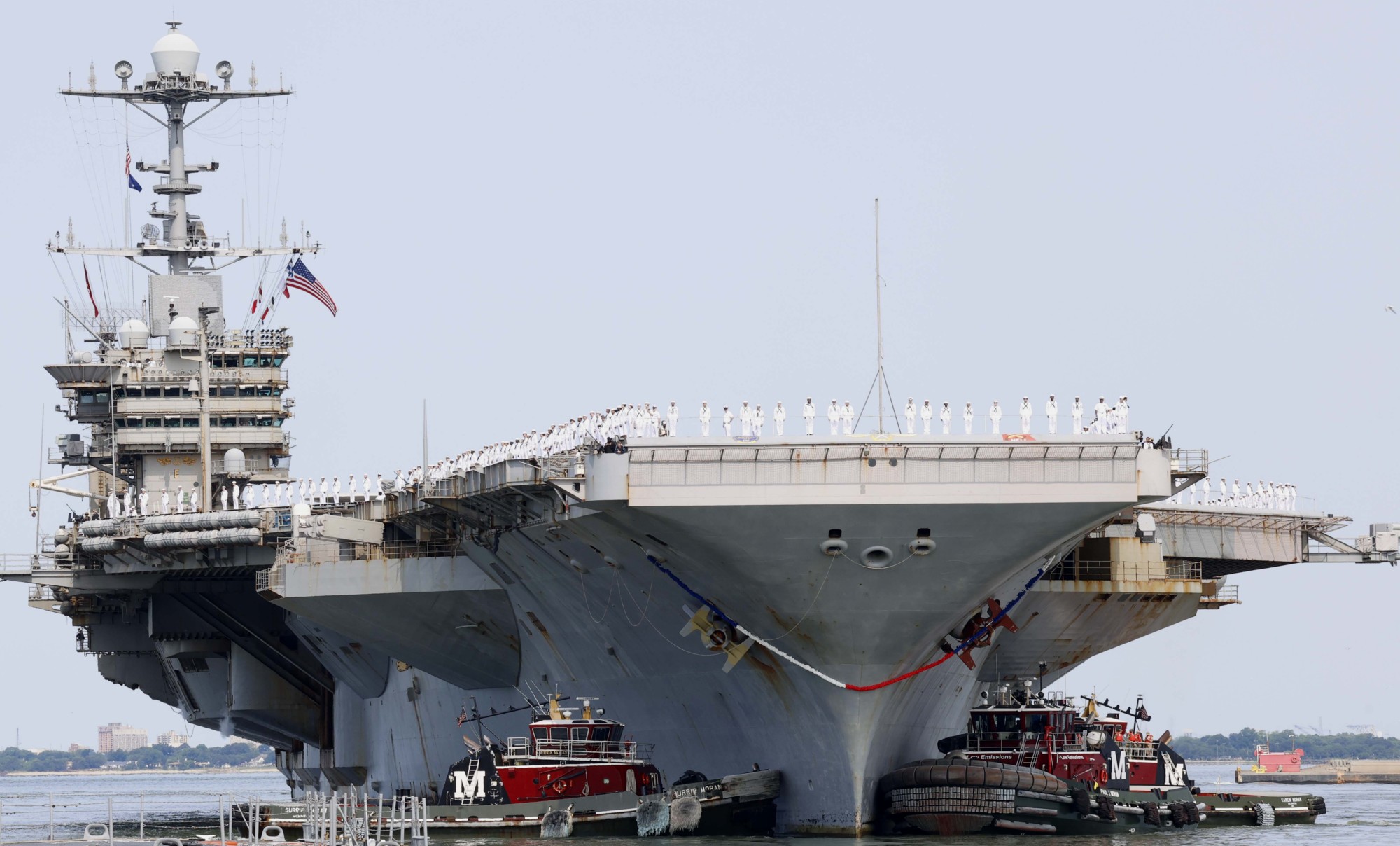 returning to Naval Station Norfolk, Virginia - June 1, 2025  with CVW-1 embarked - Mediterranean Sea - May 2025 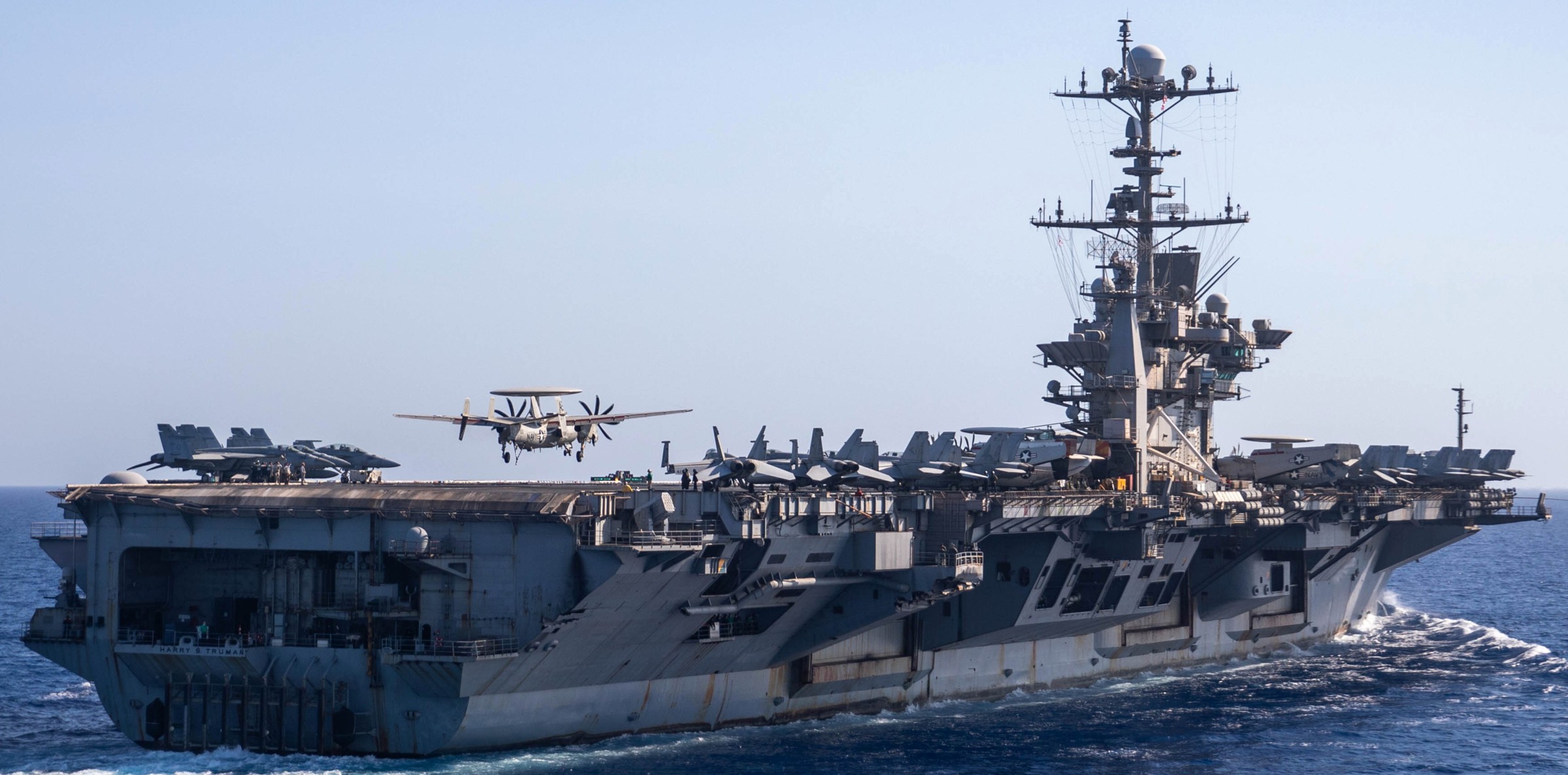 with CVW-1 embarked - Mediterranean Sea - May 2025  with CVW-1 embarked - Mediterranean Sea - May 2025 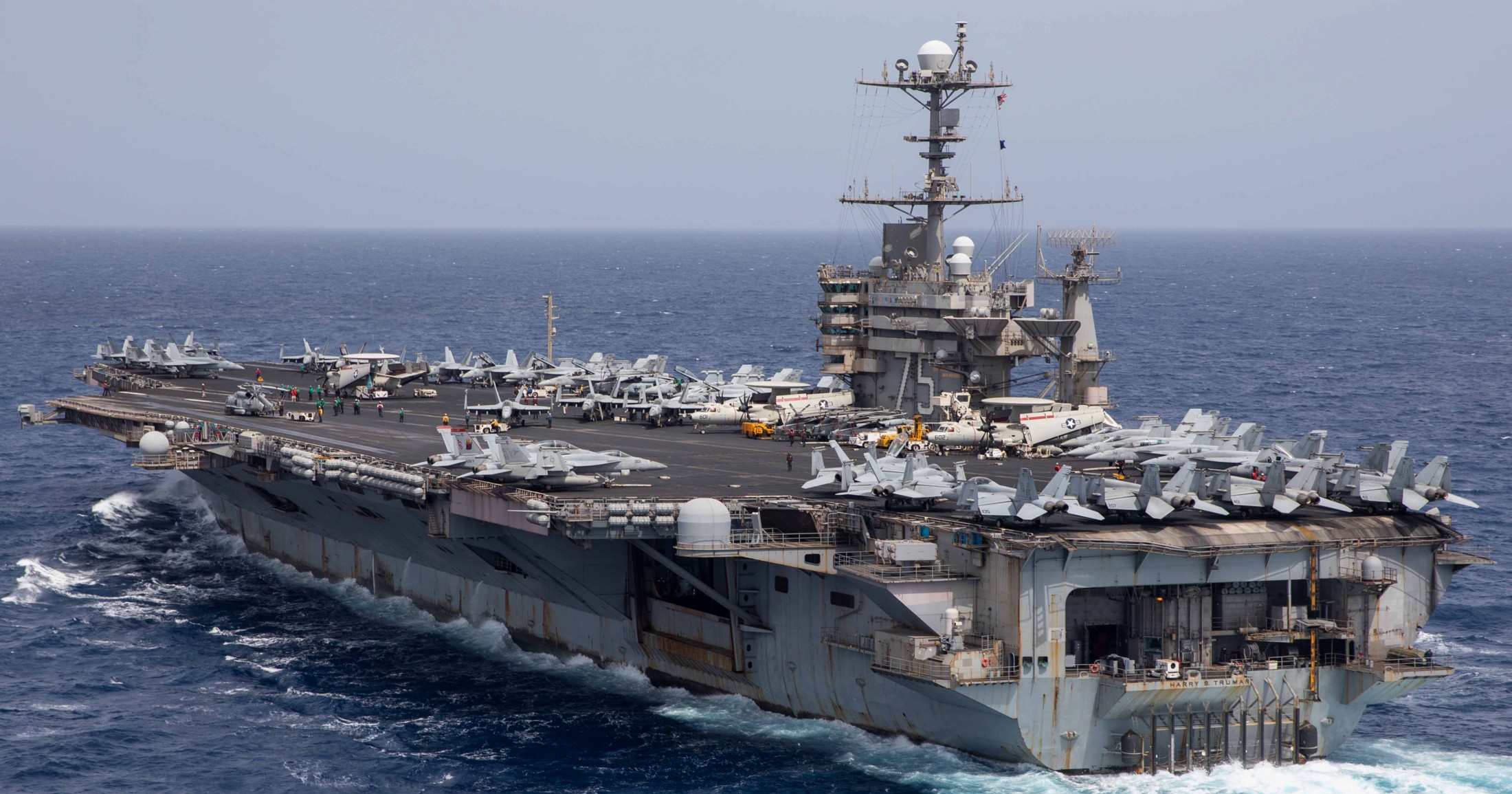 with CVW-1 embarked - 5th Fleet AOR - April 2025 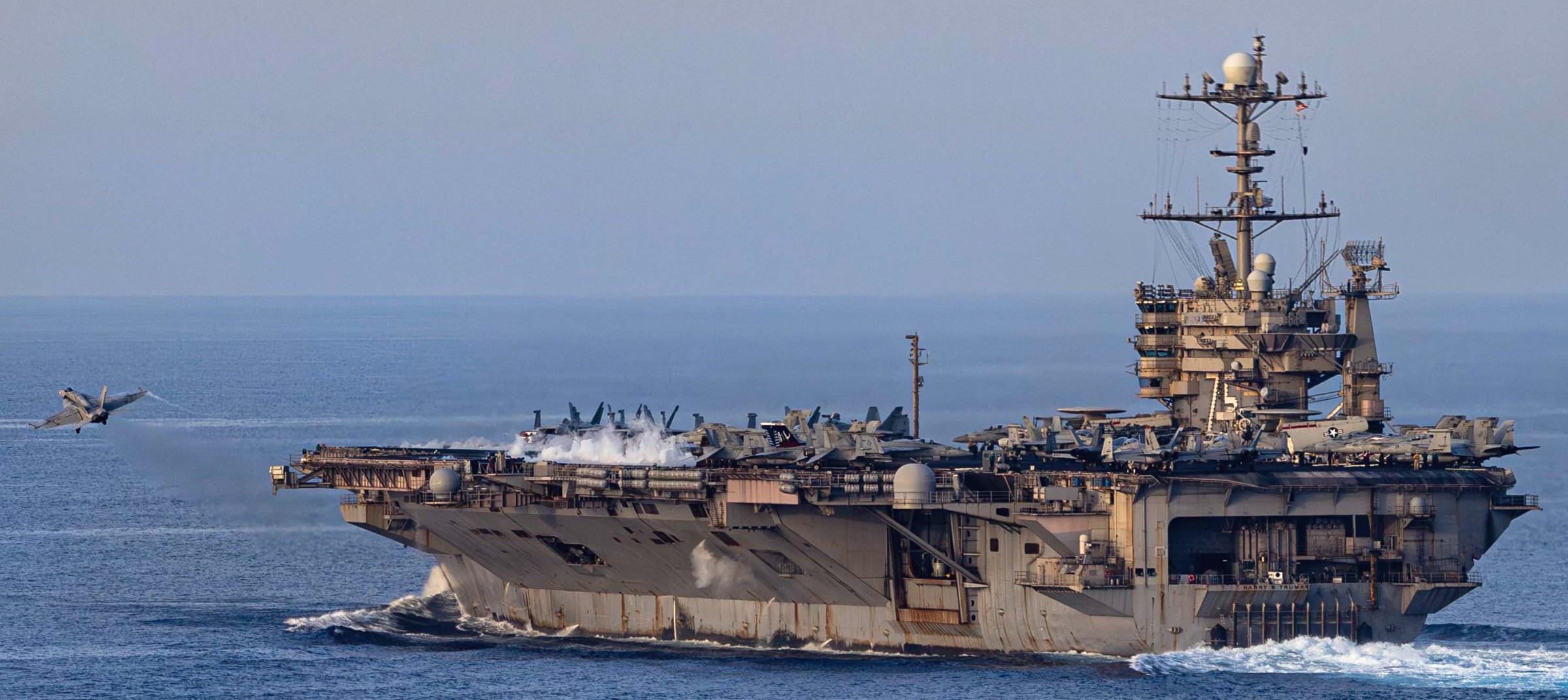 with CVW-1 embarked - 5th Fleet AOR - March 2025  with CVW-1 embarked - 5th Fleet AOR - March 2025 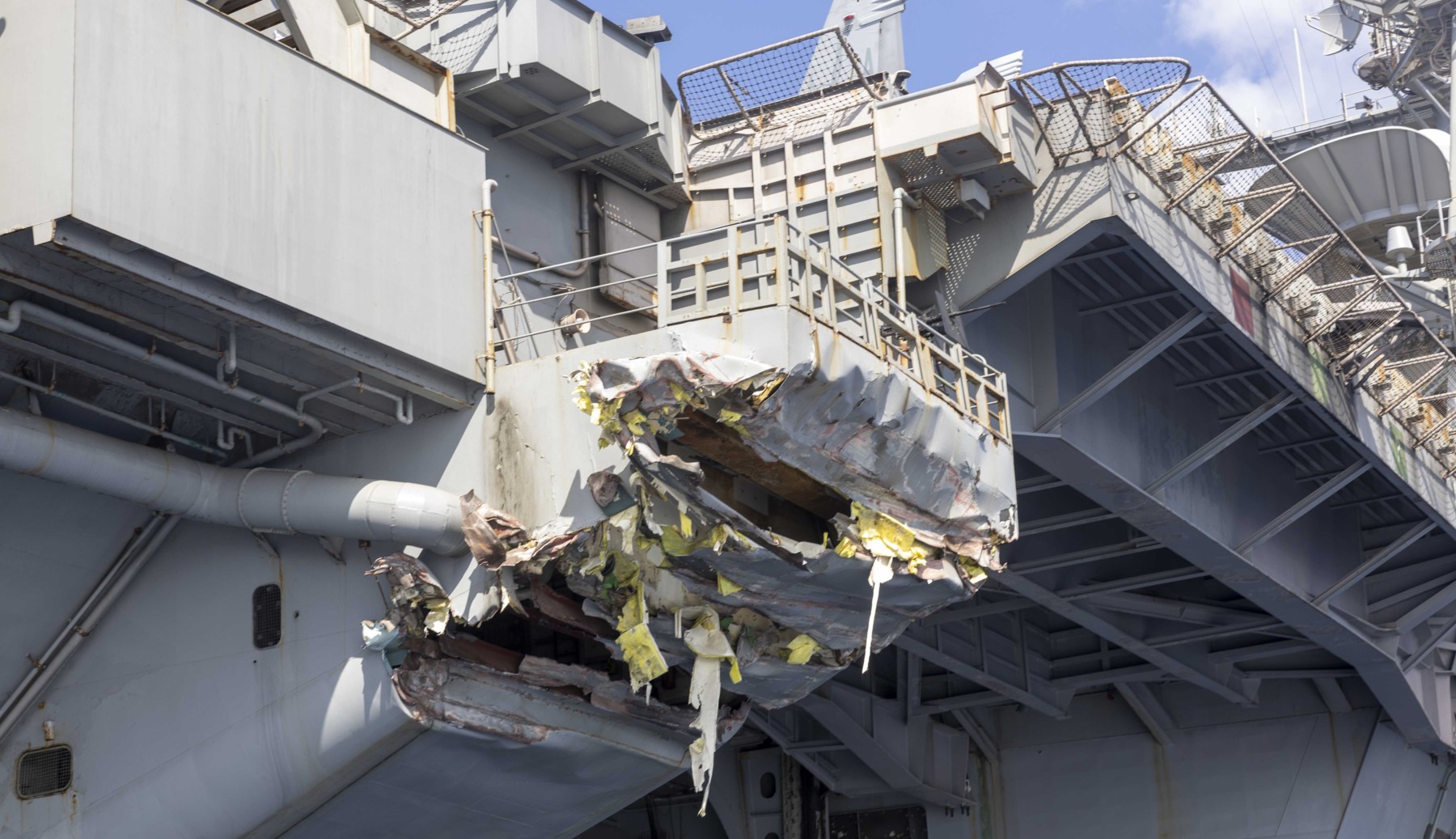 Exterior damage following a collision with merchant vessel Besiktas-M, while operating in the vicinity of Port Said, Egypt - February 12, 2025 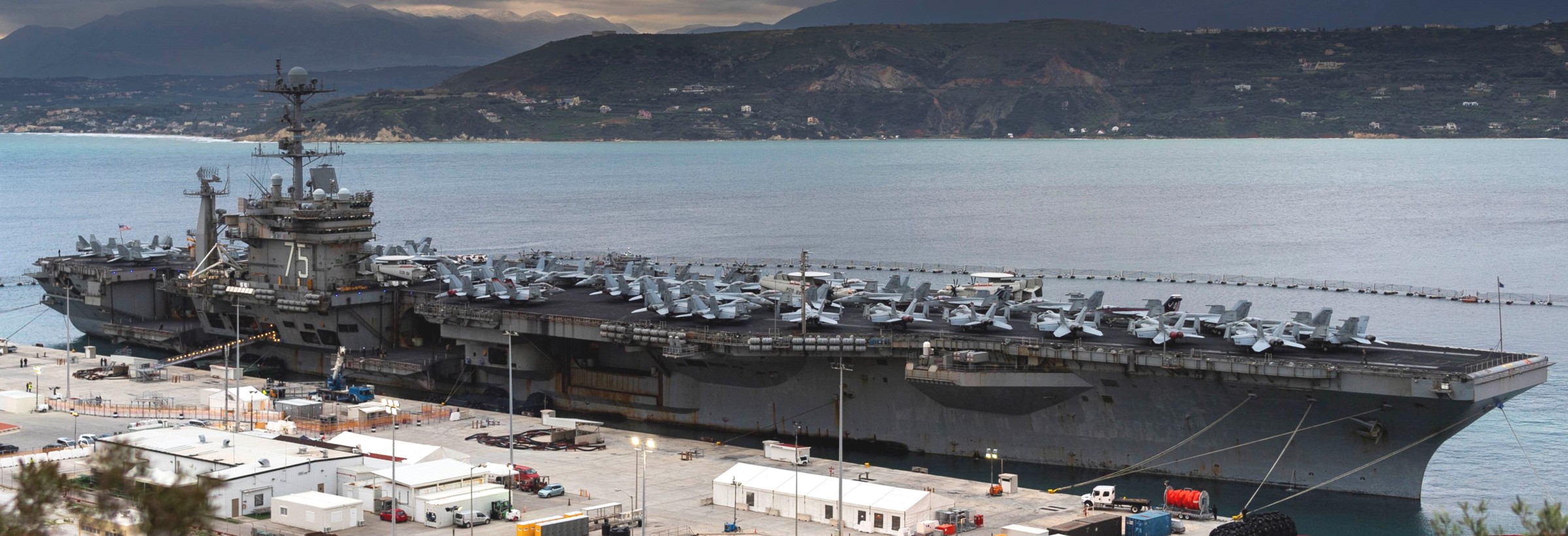 with CVW-1 embarked - NSA Souda Bay, Crete, Greece - February 6, 2025 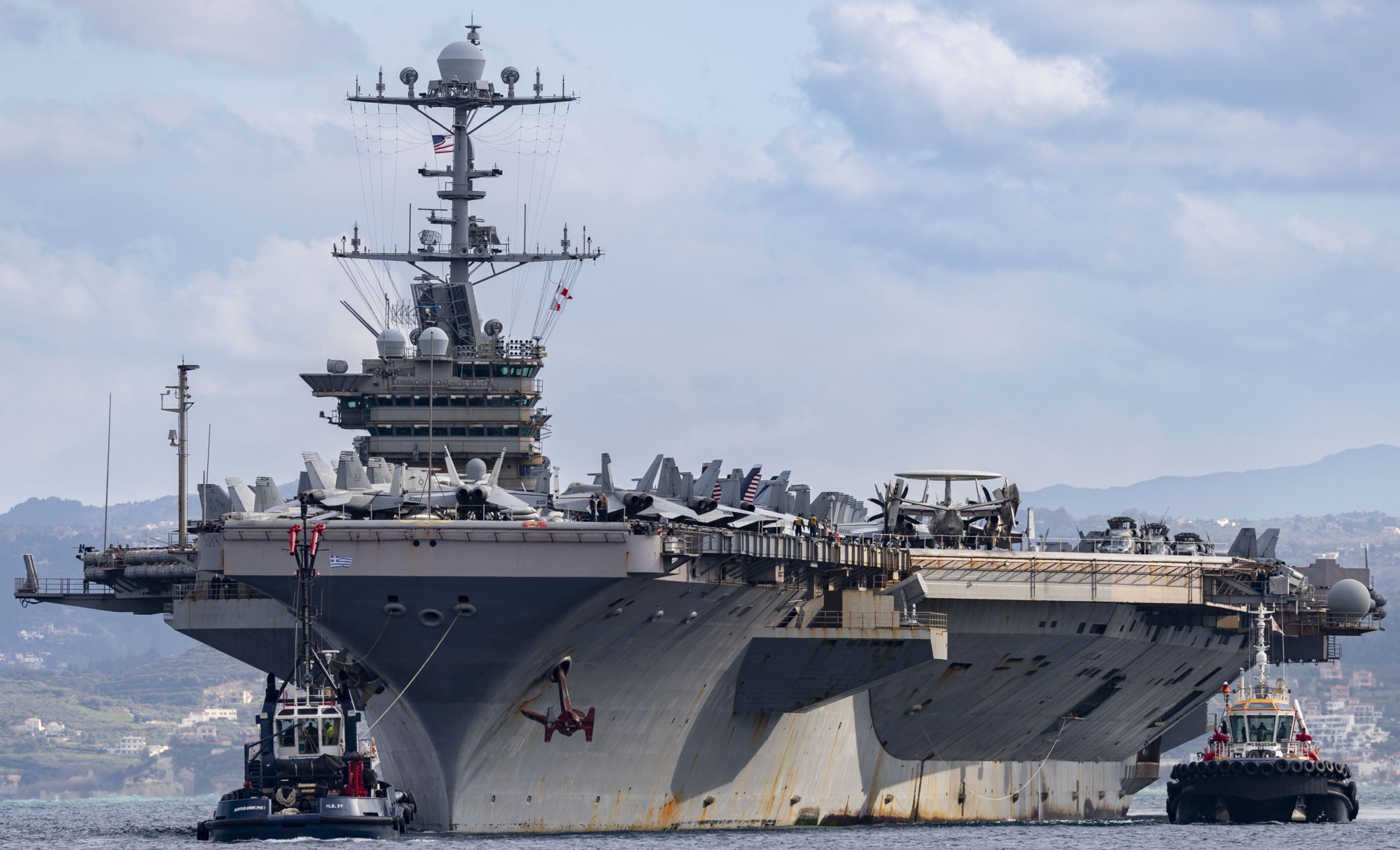 with CVW-1 embarked - NSA Souda Bay, Crete, Greece - February 6, 2025 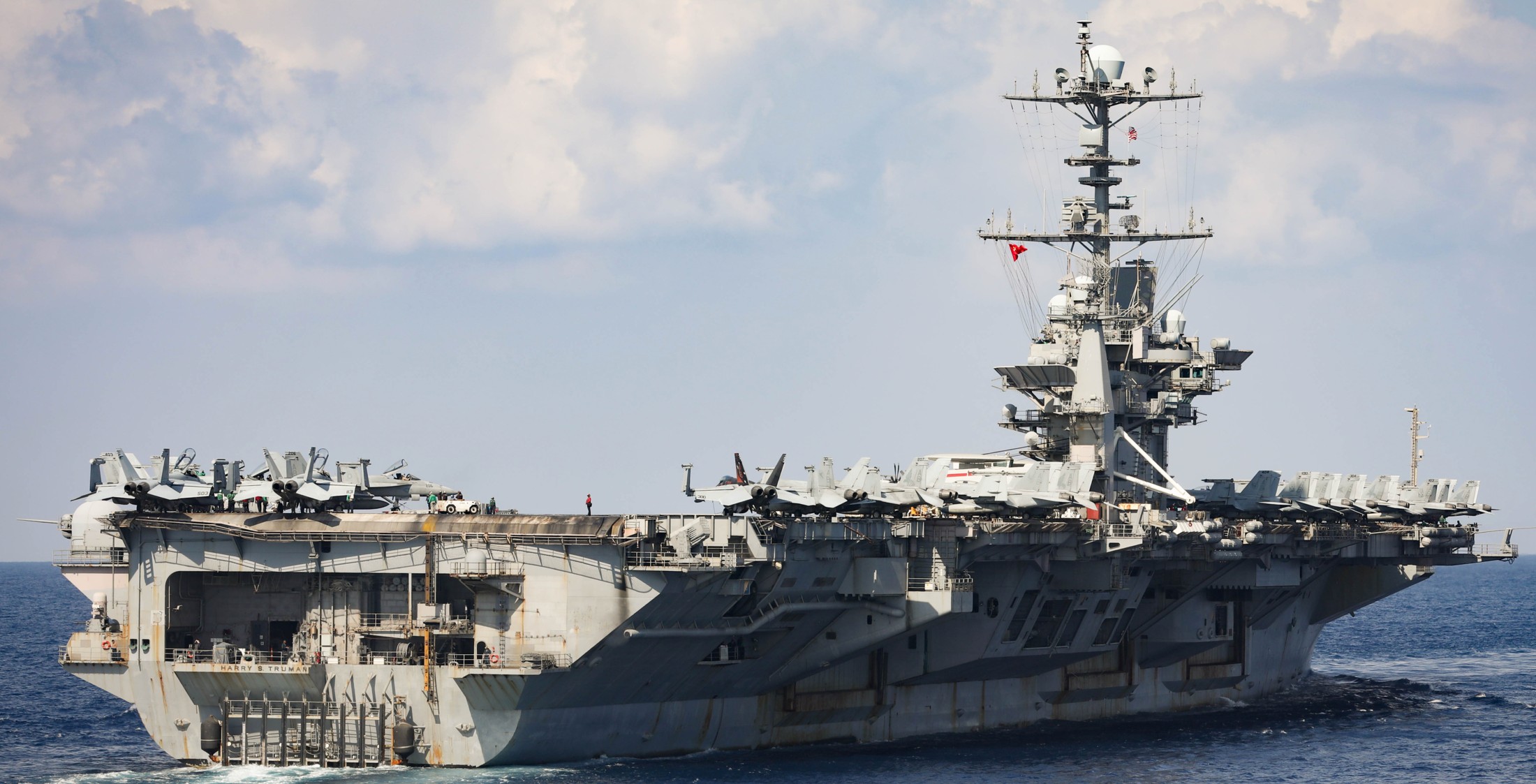 with CVW-1 embarked - 5th Fleet AOR - January 2025 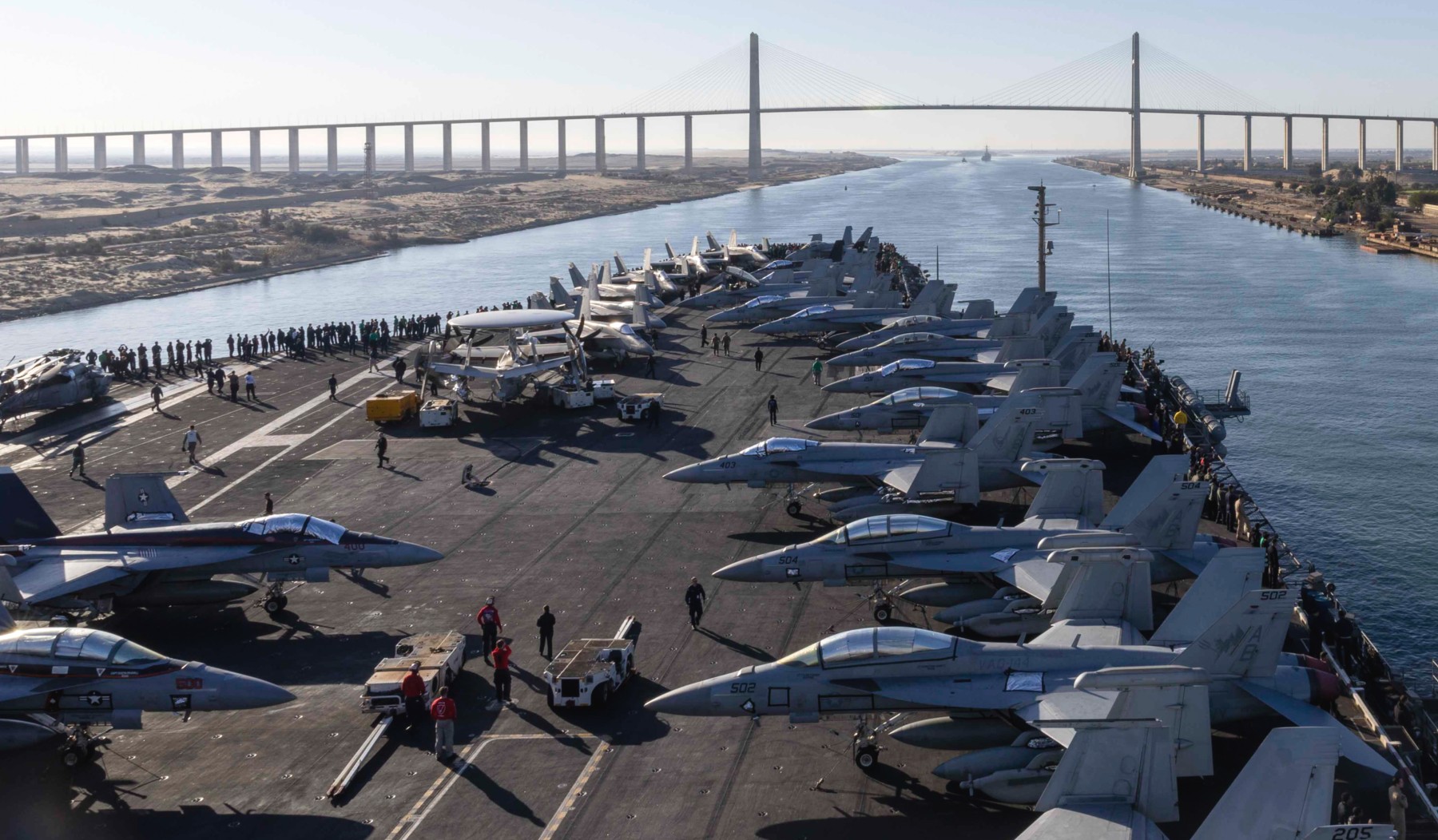 with CVW-1 embarked - Suez Canal - December 15, 2024  with CVW-1 embarked - Strait of Gibraltar - November 25, 2024 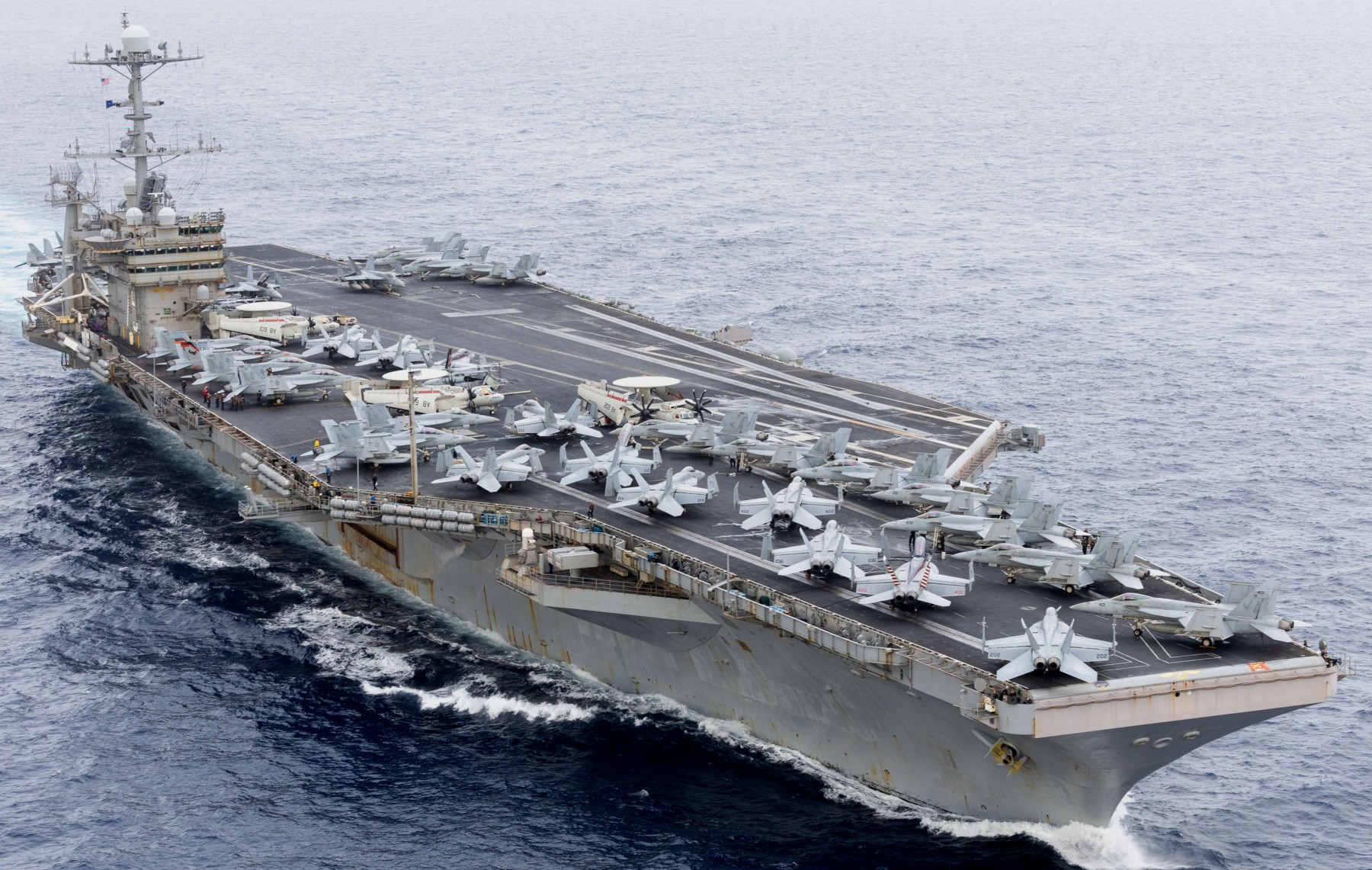 with CVW-1 embarked - Strait of Gibraltar - November 25, 2024 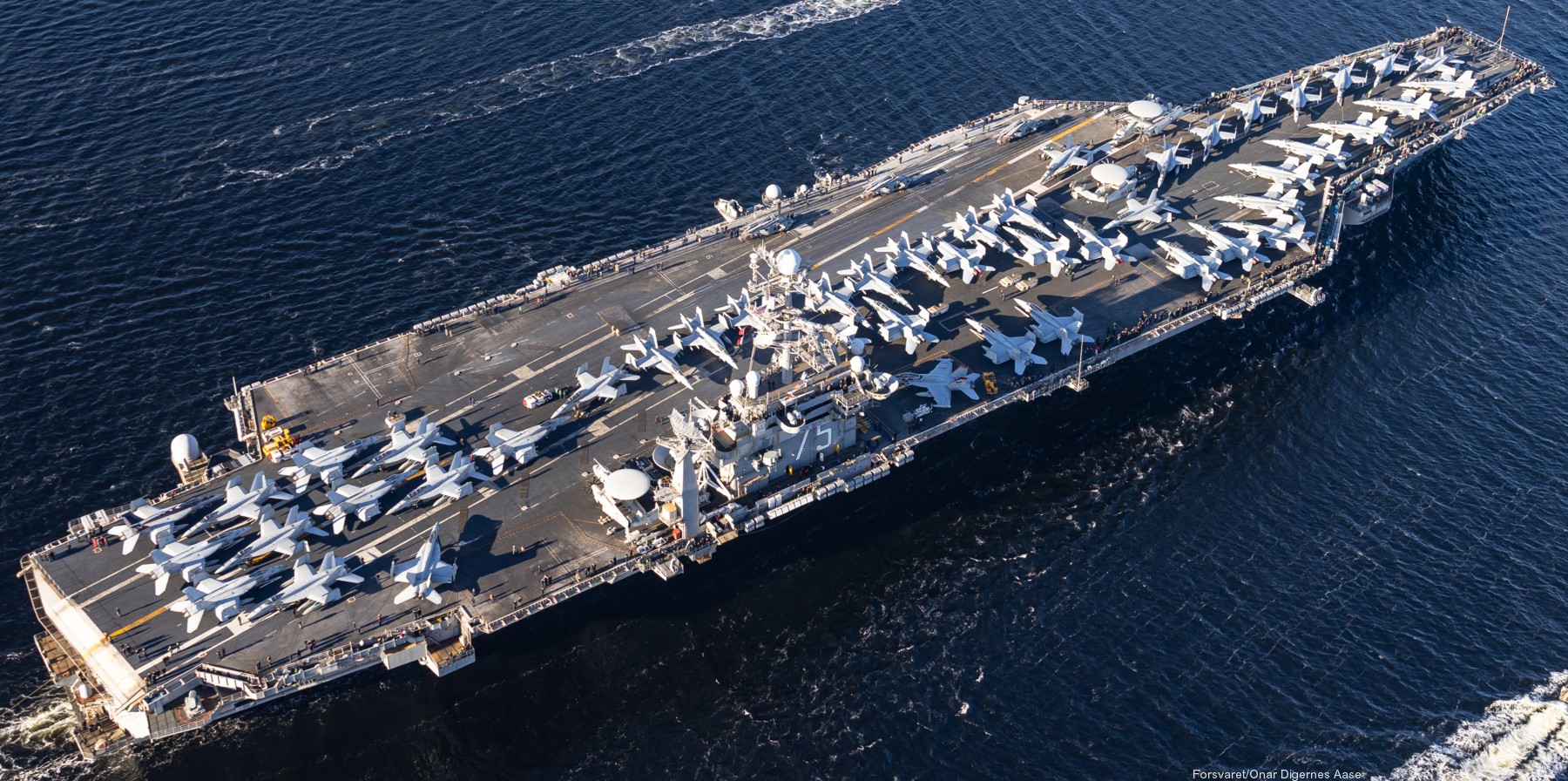 with CVW-1 embarked - arriving in Oslo, Norway - November 2024 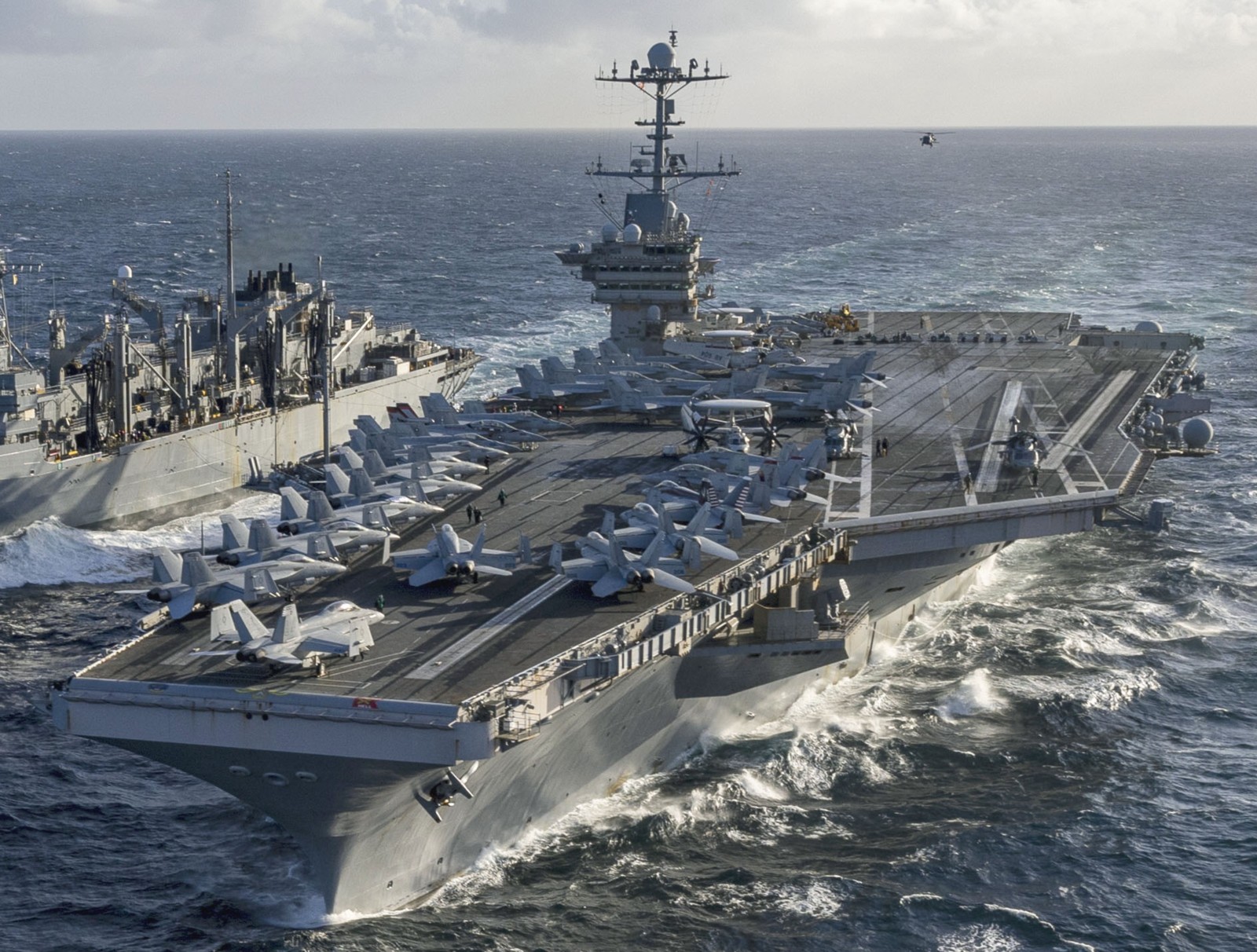 with CVW-1 embarked - NATO Exercise Neptune Strike 24 - October 2024 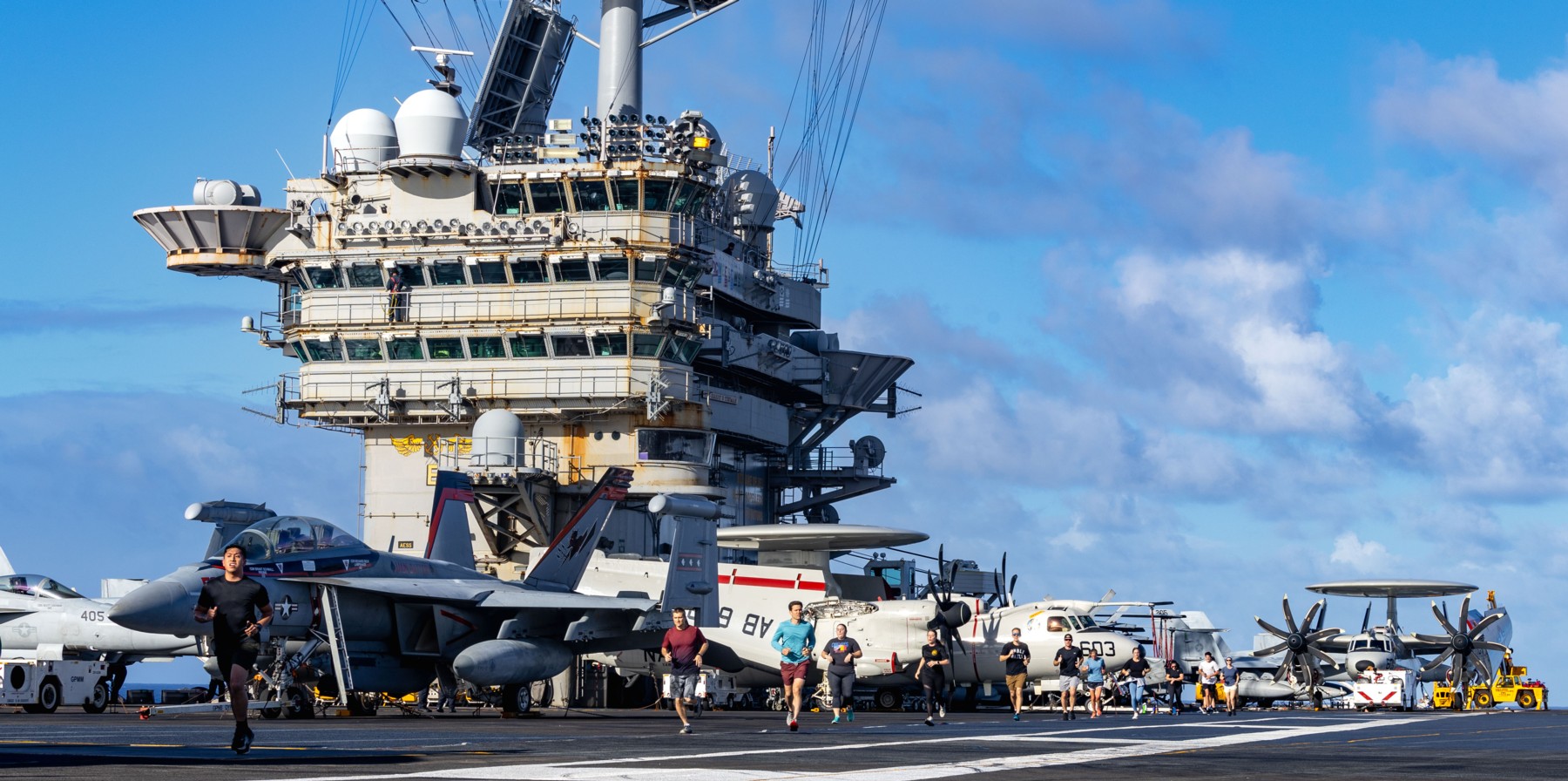 with CVW-1 embarked - Atlantic Ocean - September 30, 2024 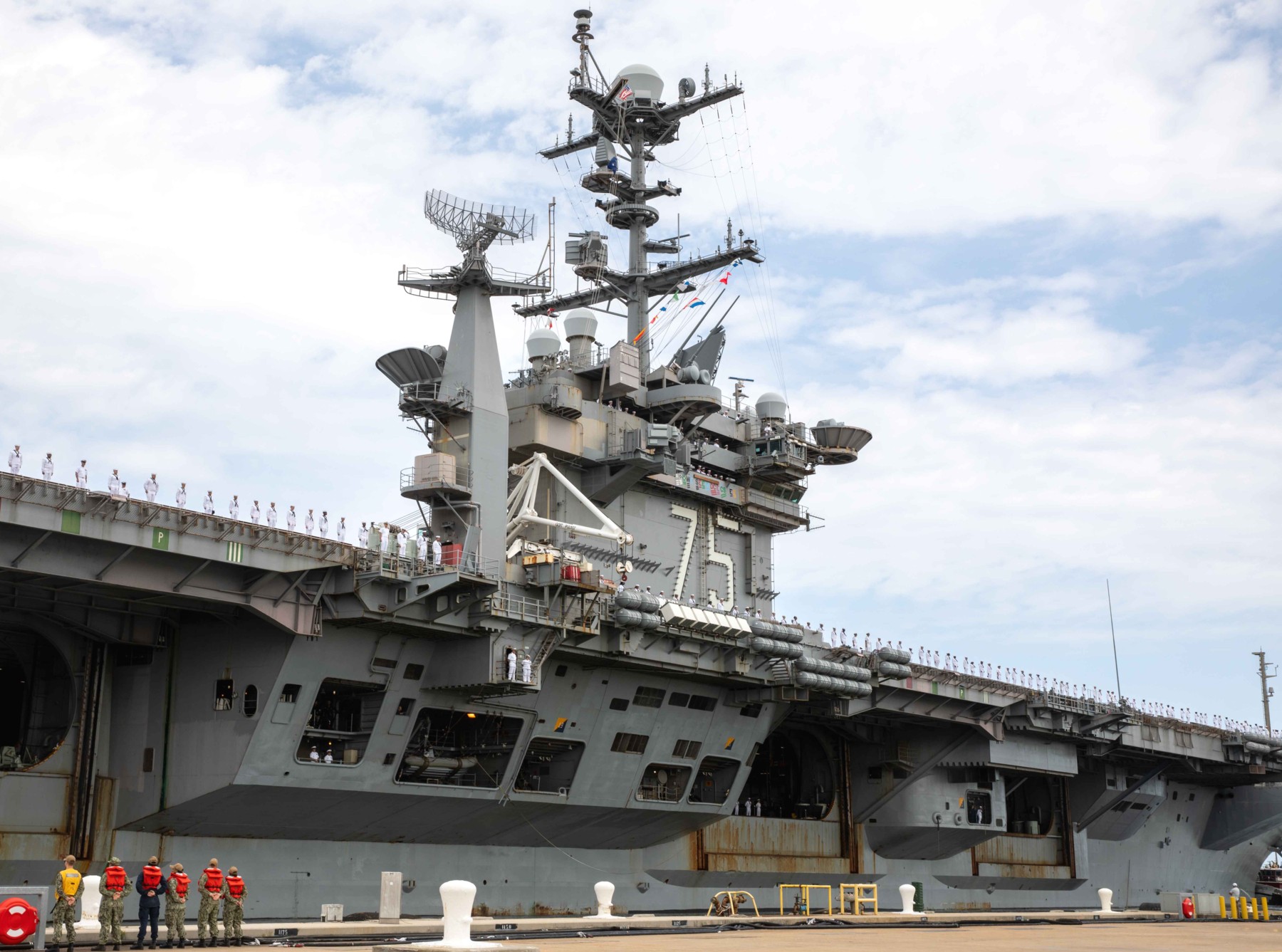 departing Naval Station Norfolk, Virginia - September 23, 2024 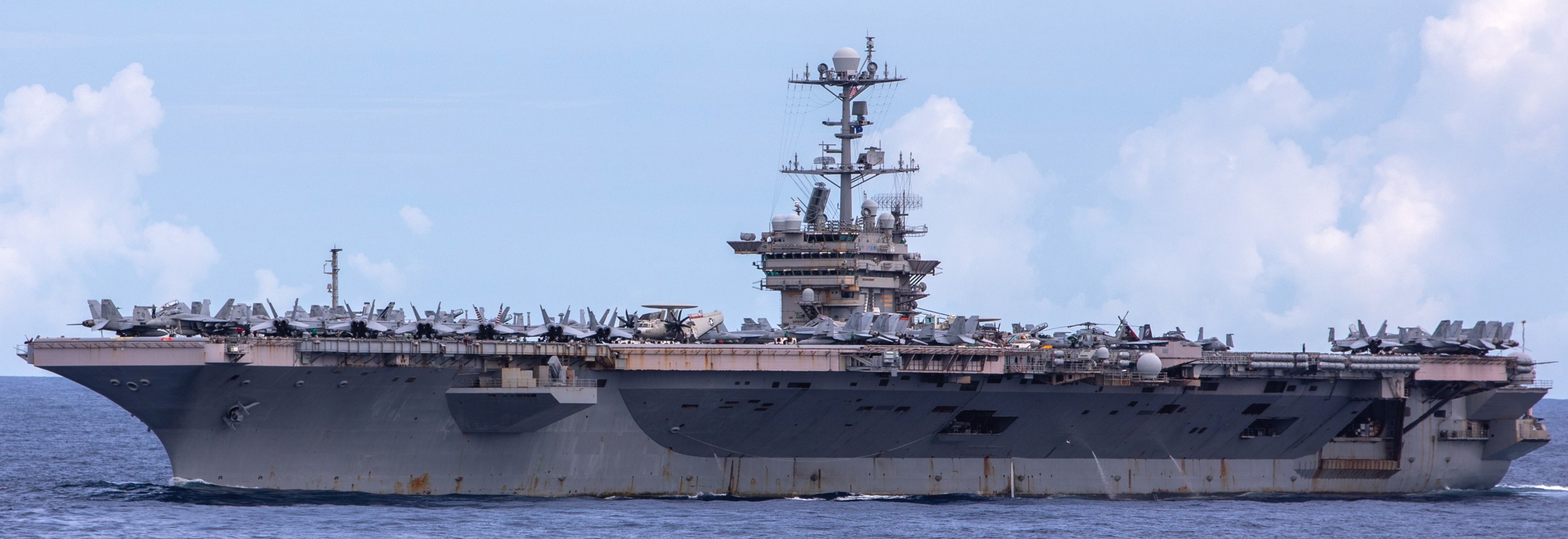 with CVW-1 embarked - COMPTUEX - Atlantic Ocean - August 2024 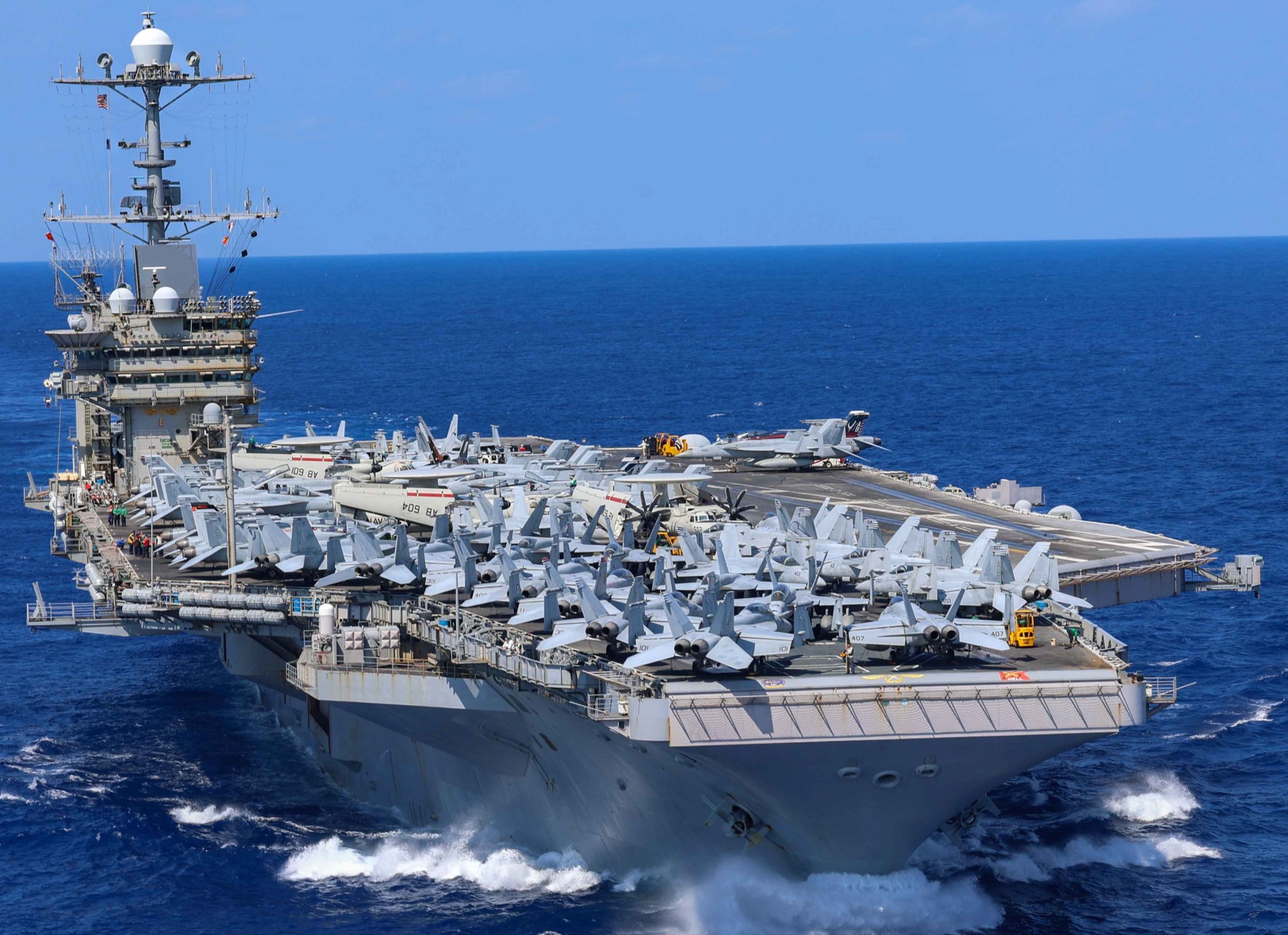 with CVW-1 embarked - COMPTUEX - Atlantic Ocean - August 2024 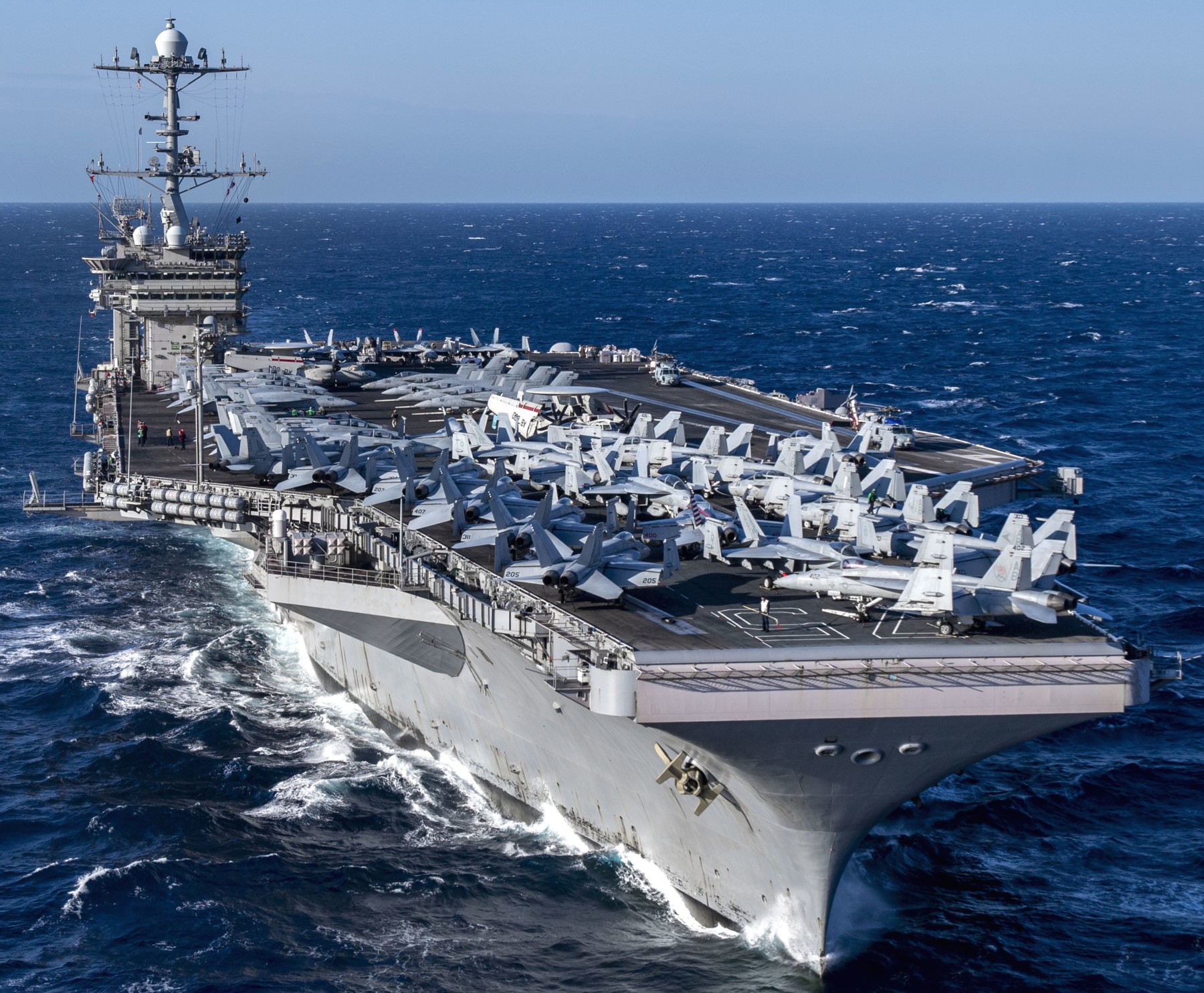 with CVW-1 embarked - basic training - Atlantic Ocean - May 2024  flight deck certifications - Atlantic Ocean - February 2024 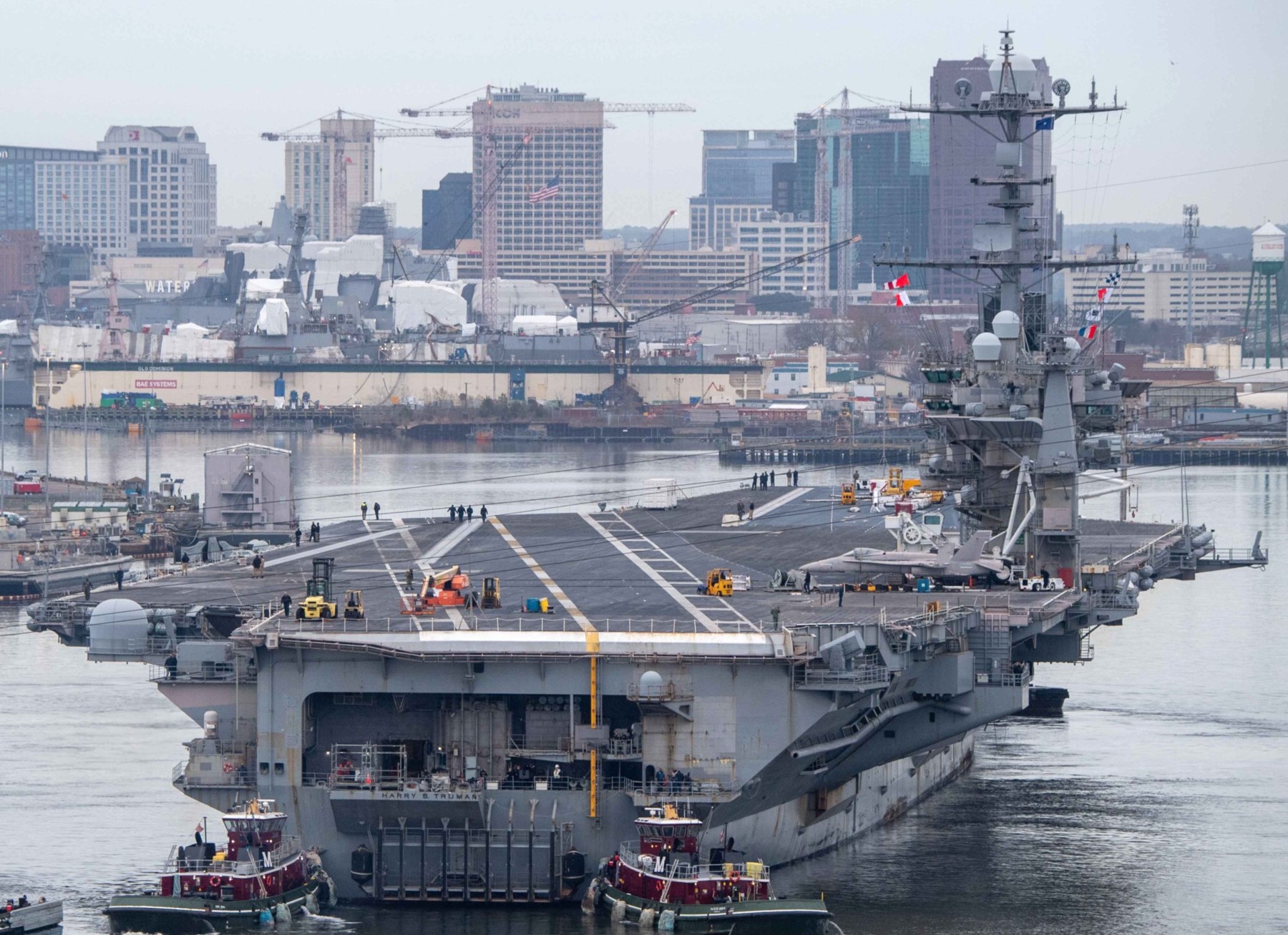 transferring from Norfolk Naval Shipyard (NNSY) back to Naval Station Norfolk after her Planned Incremental Availability (PIA) - December 23, 2023  transferring from Norfolk Naval Shipyard (NNSY) back to Naval Station Norfolk after her Planned Incremental Availability (PIA) - December 23, 2023 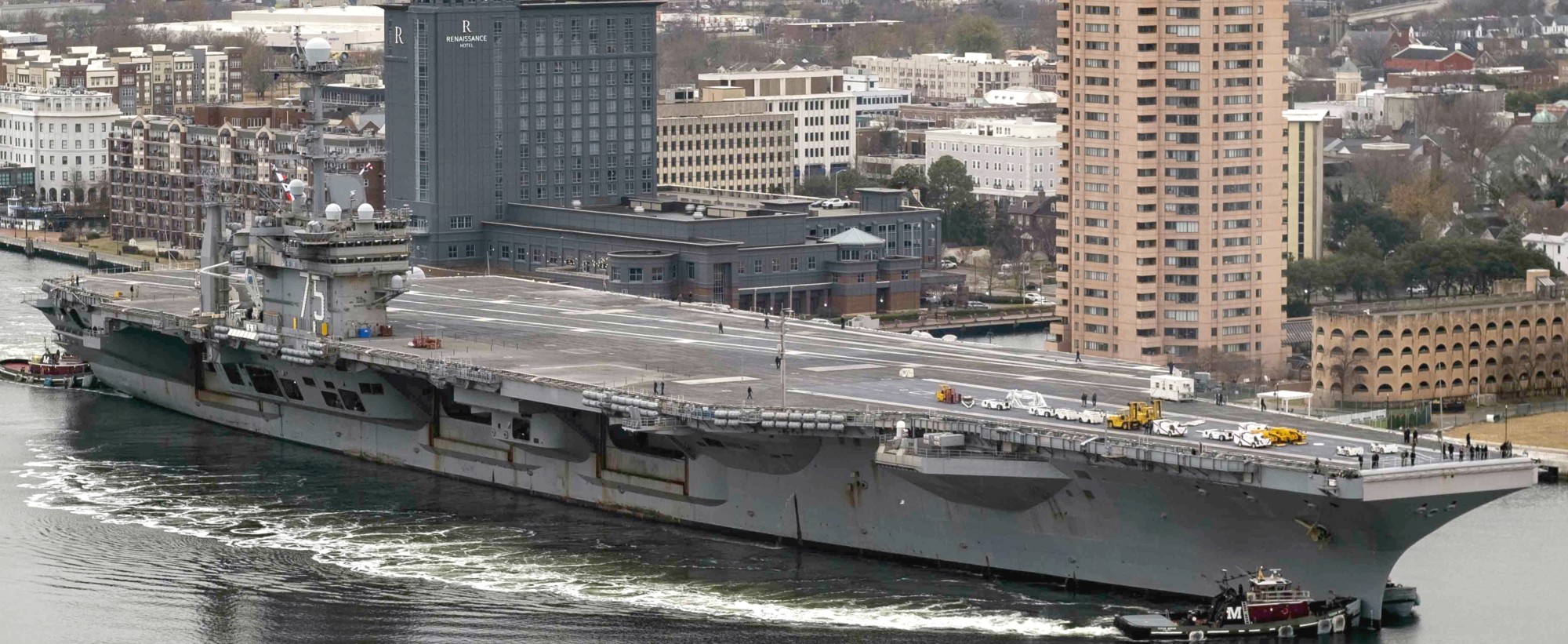 transferring from Norfolk Naval Shipyard (NNSY) back to Naval Station Norfolk after her Planned Incremental Availability (PIA) - December 23, 2023 December 2022 - December 2023: Planned Incremental Availability (PIA) at Norfolk Naval Shipyard, Virginia 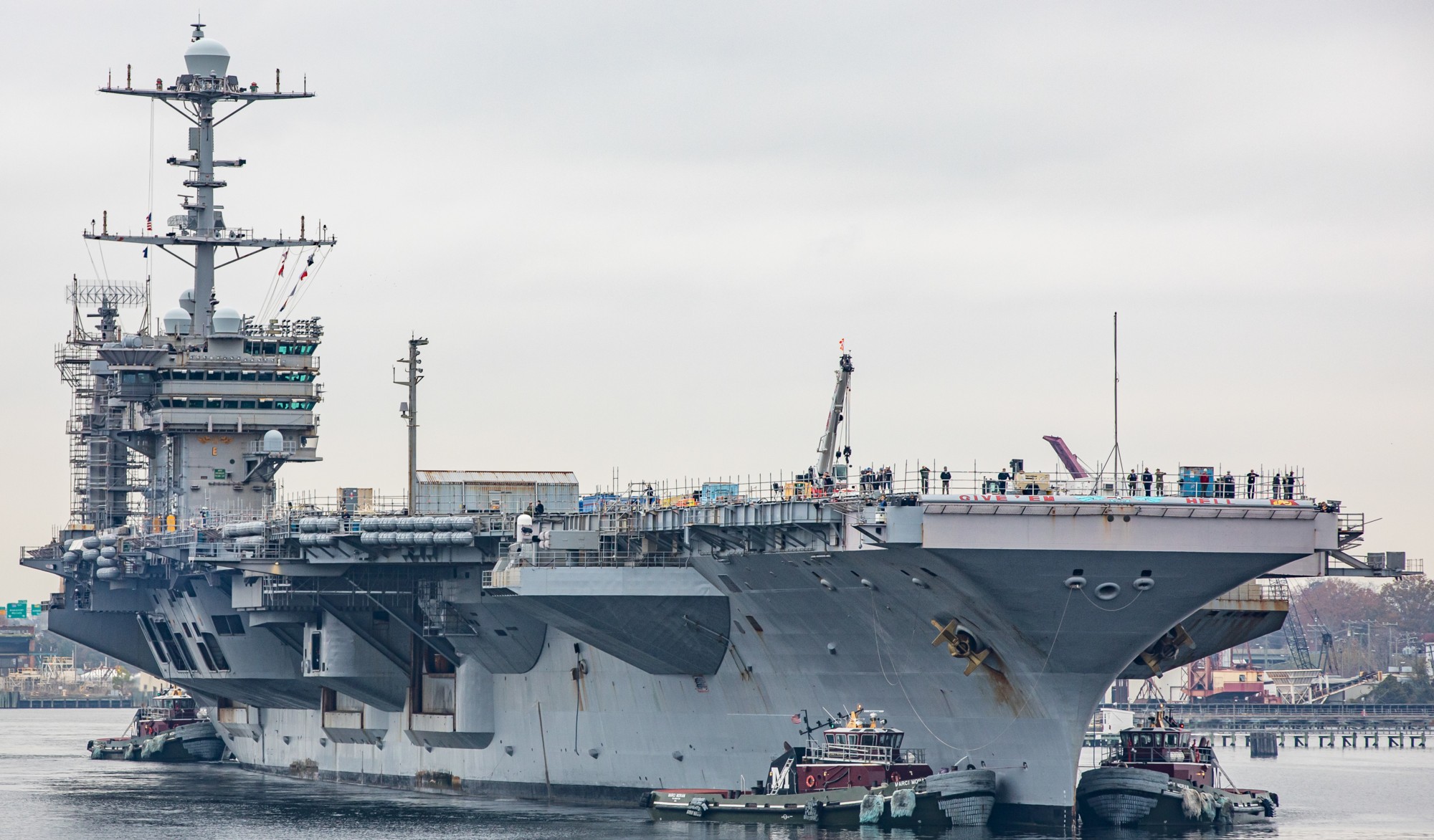 Norfolk Naval Shipyard (NNSY) welcomes USS Harry S. Truman in advance of its scheduled Planned Incremental Availability (PIA) - December 7, 2022 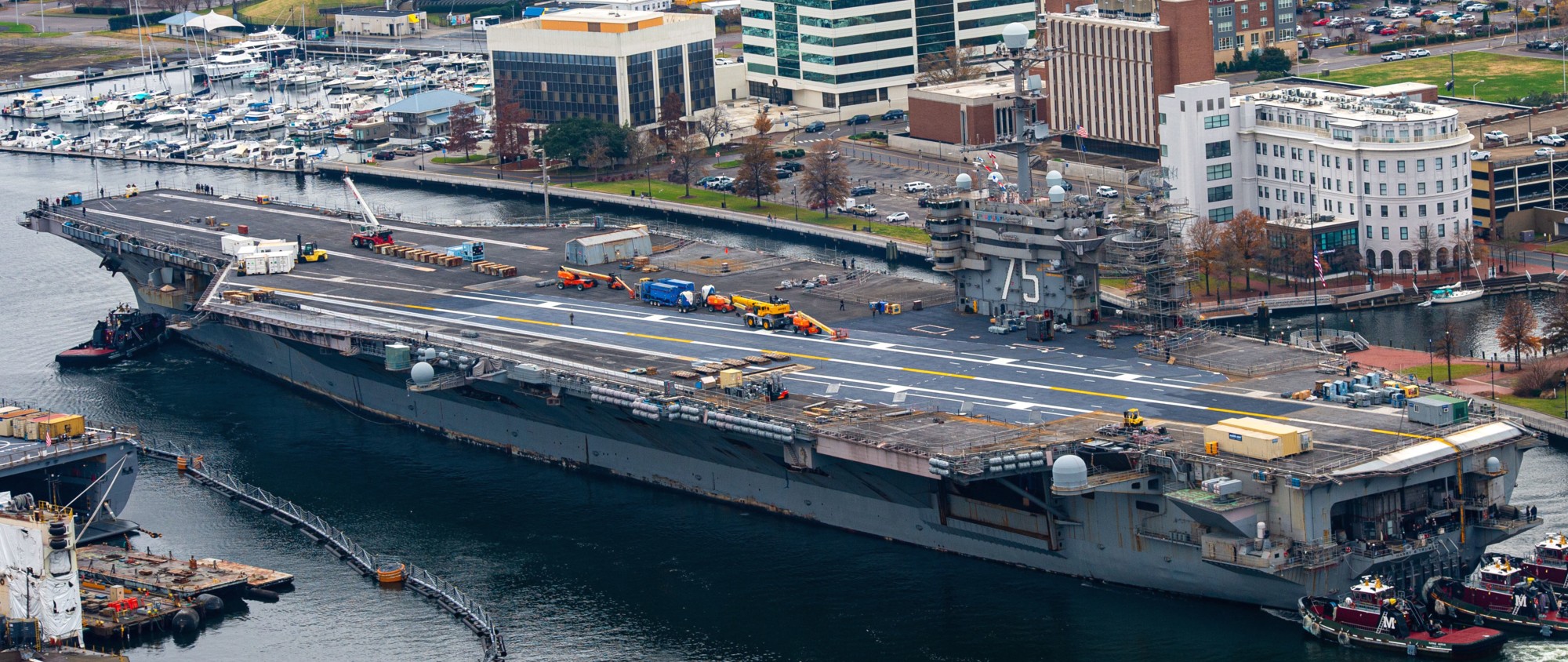 transferring from Naval Station Norfolk, Virginia to Norfolk Naval Shipyard (NNSY) for a Planned Incremental Availability (PIA) - December 7, 2022 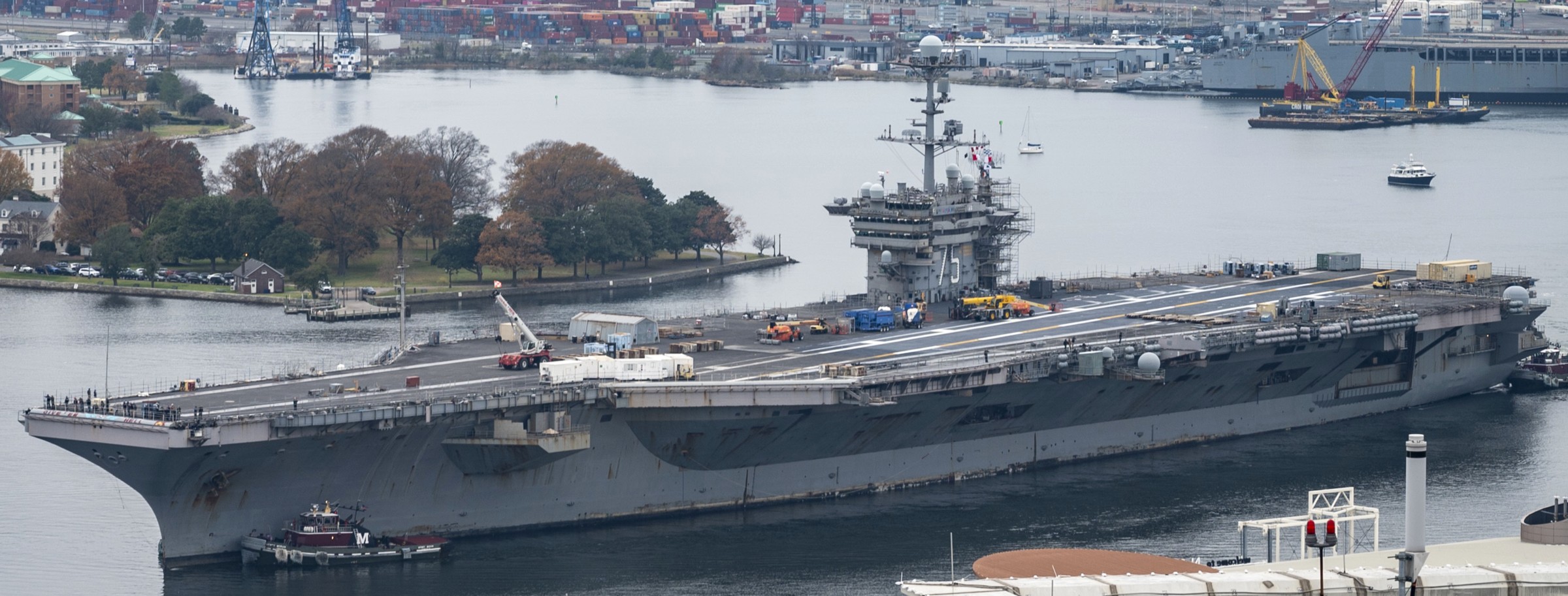 transferring from Naval Station Norfolk, Virginia to Norfolk Naval Shipyard (NNSY) for a Planned Incremental Availability (PIA) - December 7, 2022 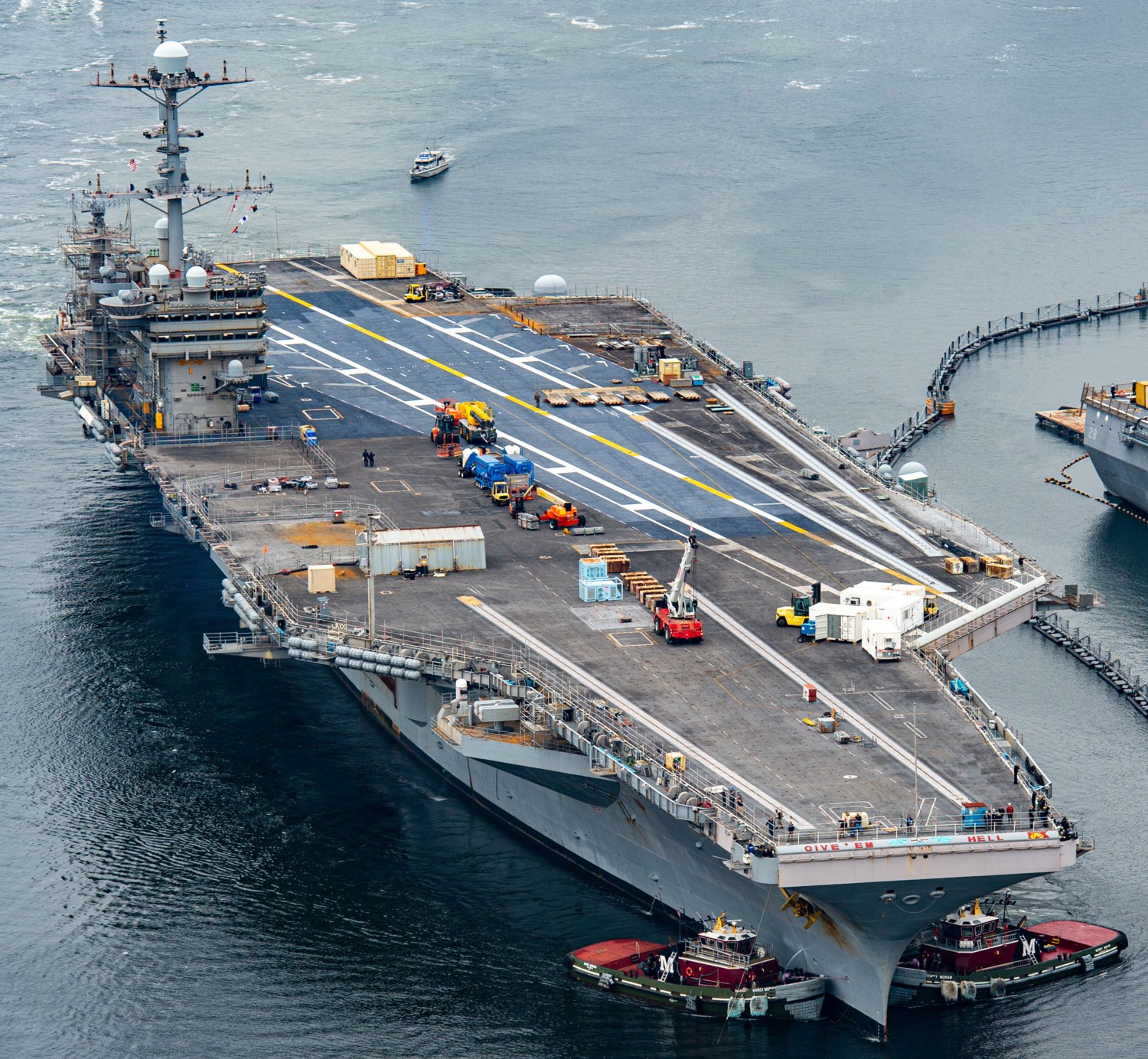 departing Naval Station Norfolk, Virginia en route to Norfolk Naval Shipyard for a Planned Incremental Availability (PIA) - December 7, 2022 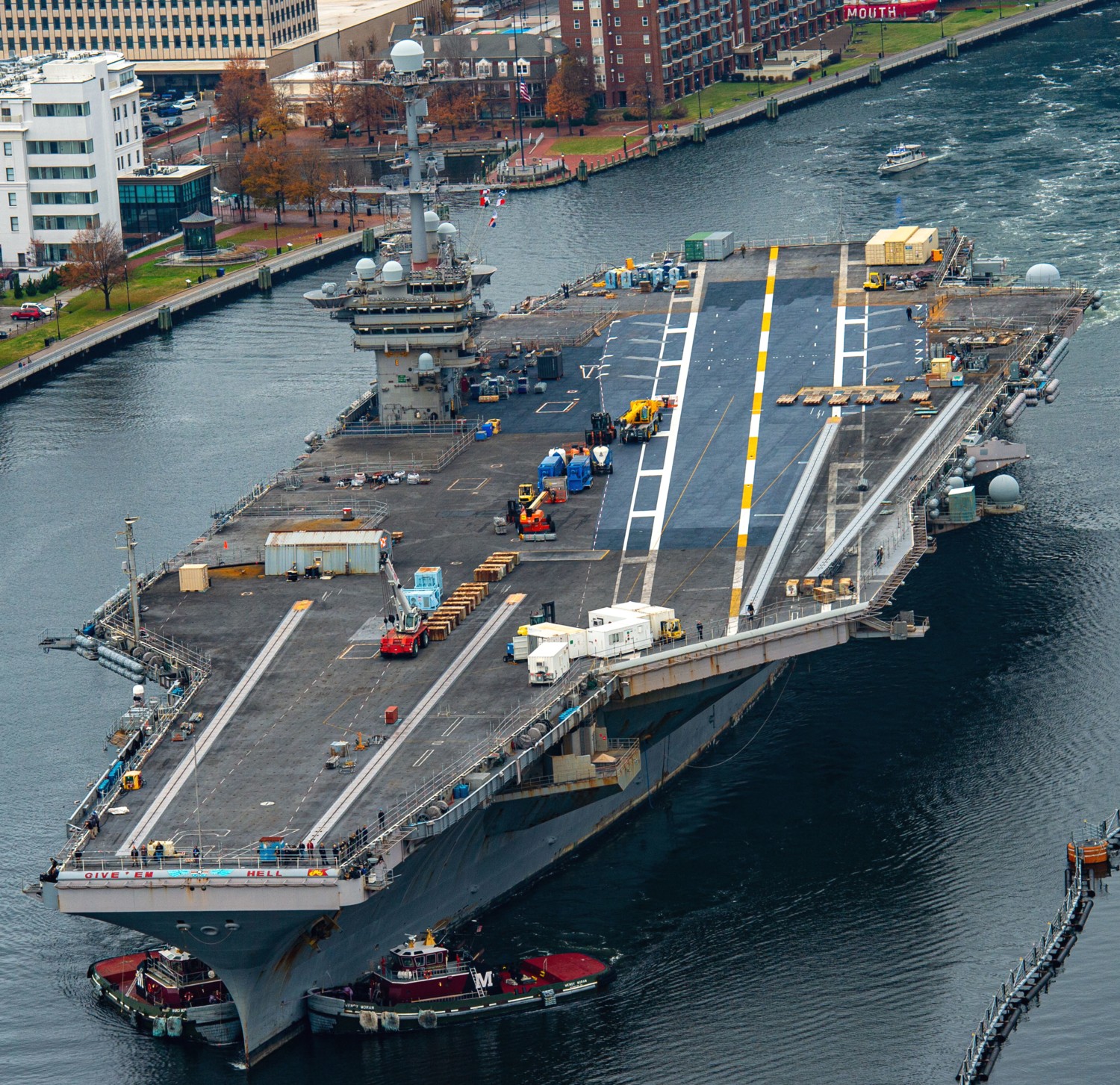 departing Naval Station Norfolk, Virginia en route to Norfolk Naval Shipyard for a Planned Incremental Availability (PIA) - December 7, 2022  departing Naval Station Norfolk, Virginia en route to Norfolk Naval Shipyard for a Planned Incremental Availability (PIA) - December 7, 2022 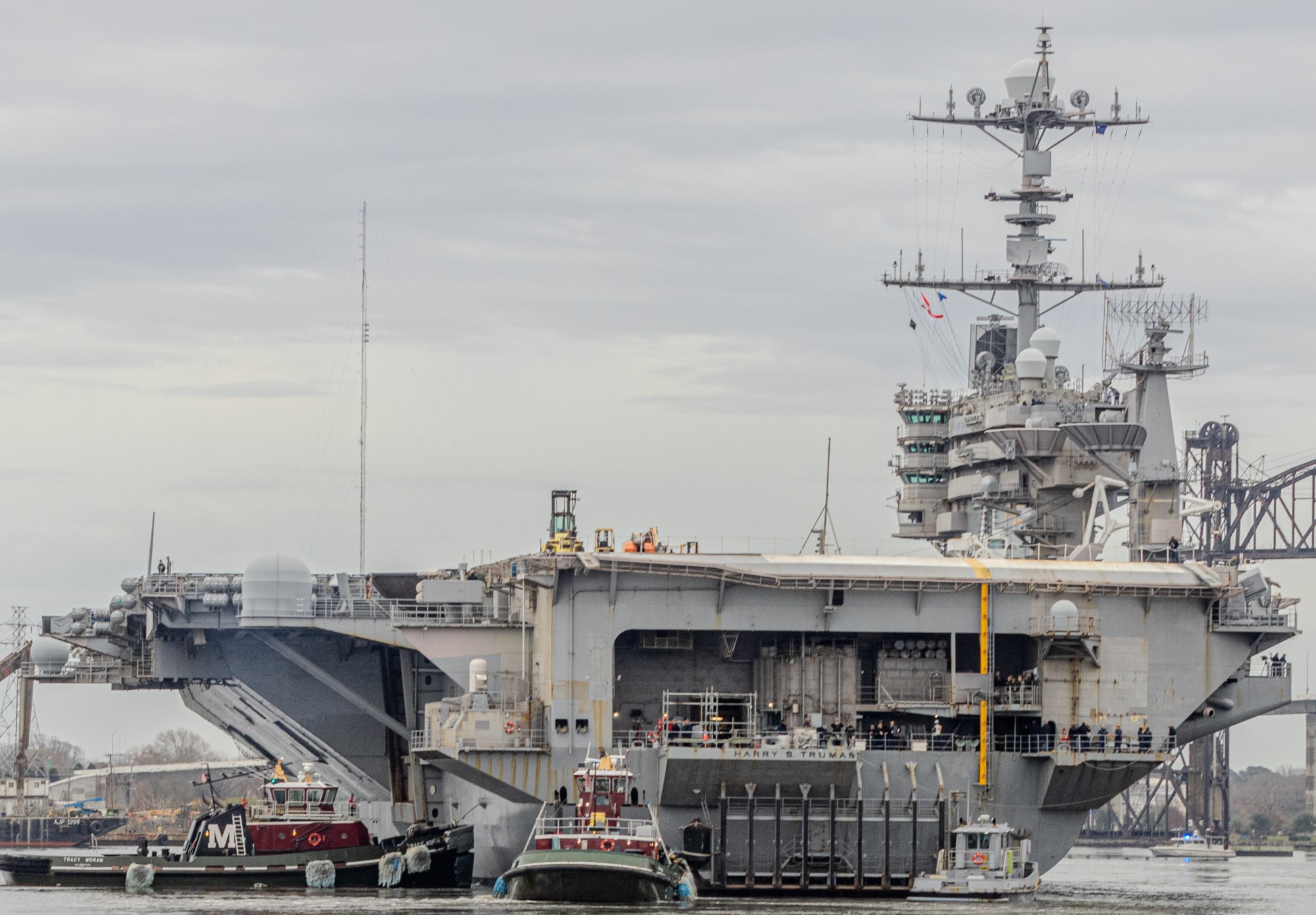 departing Naval Station Norfolk, Virginia en route to Norfolk Naval Shipyard for a Planned Incremental Availability (PIA) - December 7, 2022 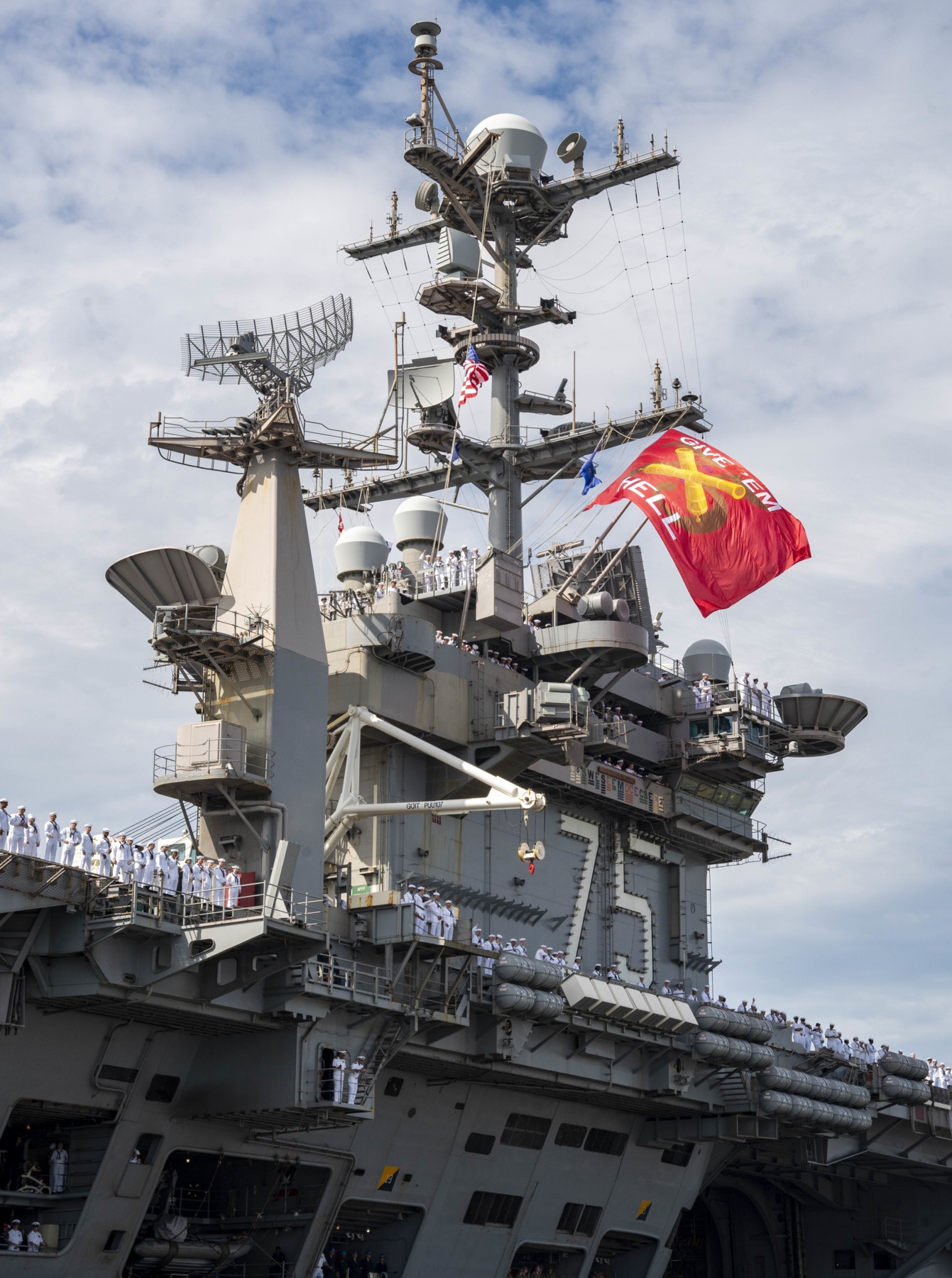 returning to Naval Station Norfolk, Virginia - September 12, 2022 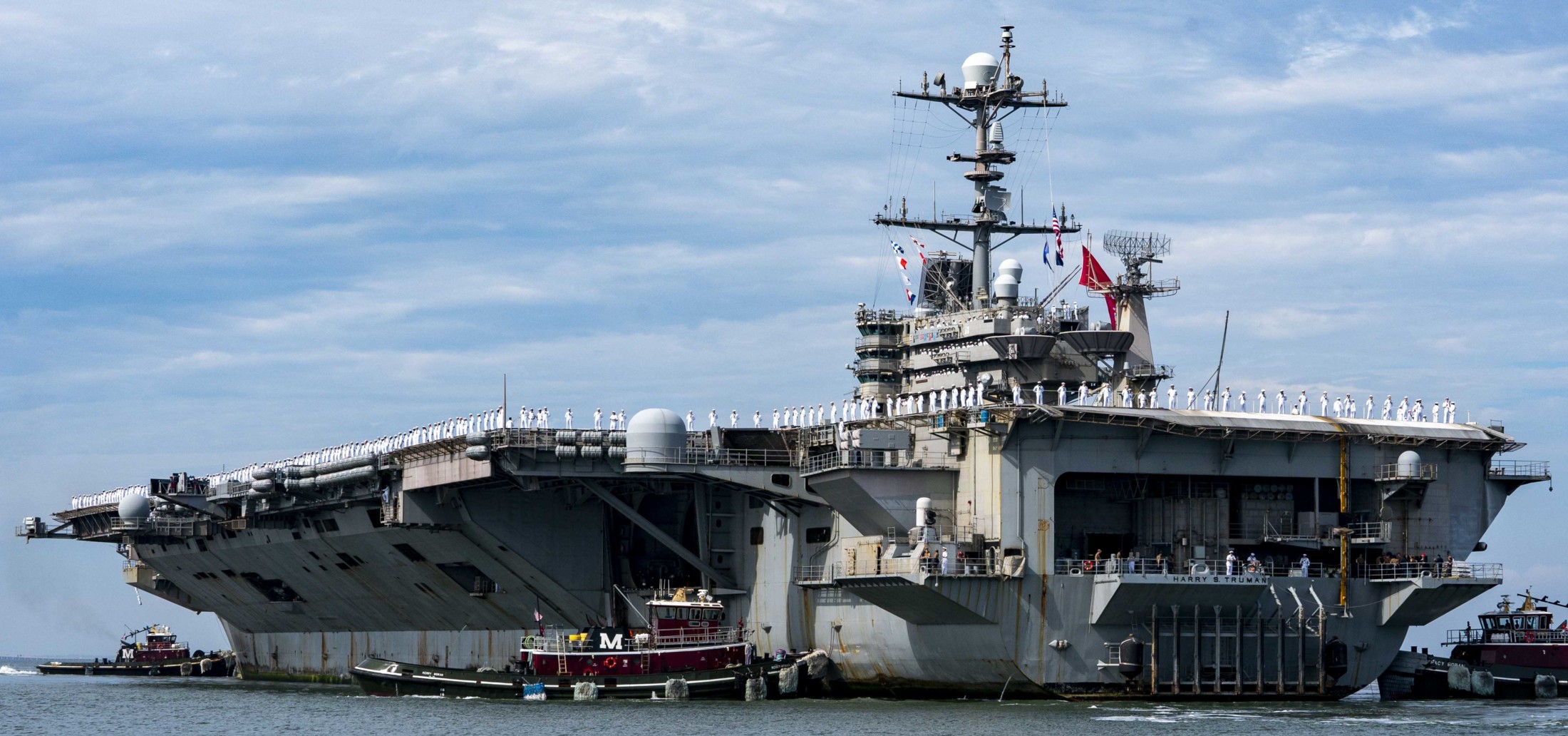 returning to Naval Station Norfolk, Virginia - September 12, 2022  returning to Naval Station Norfolk, Virginia - September 12, 2022 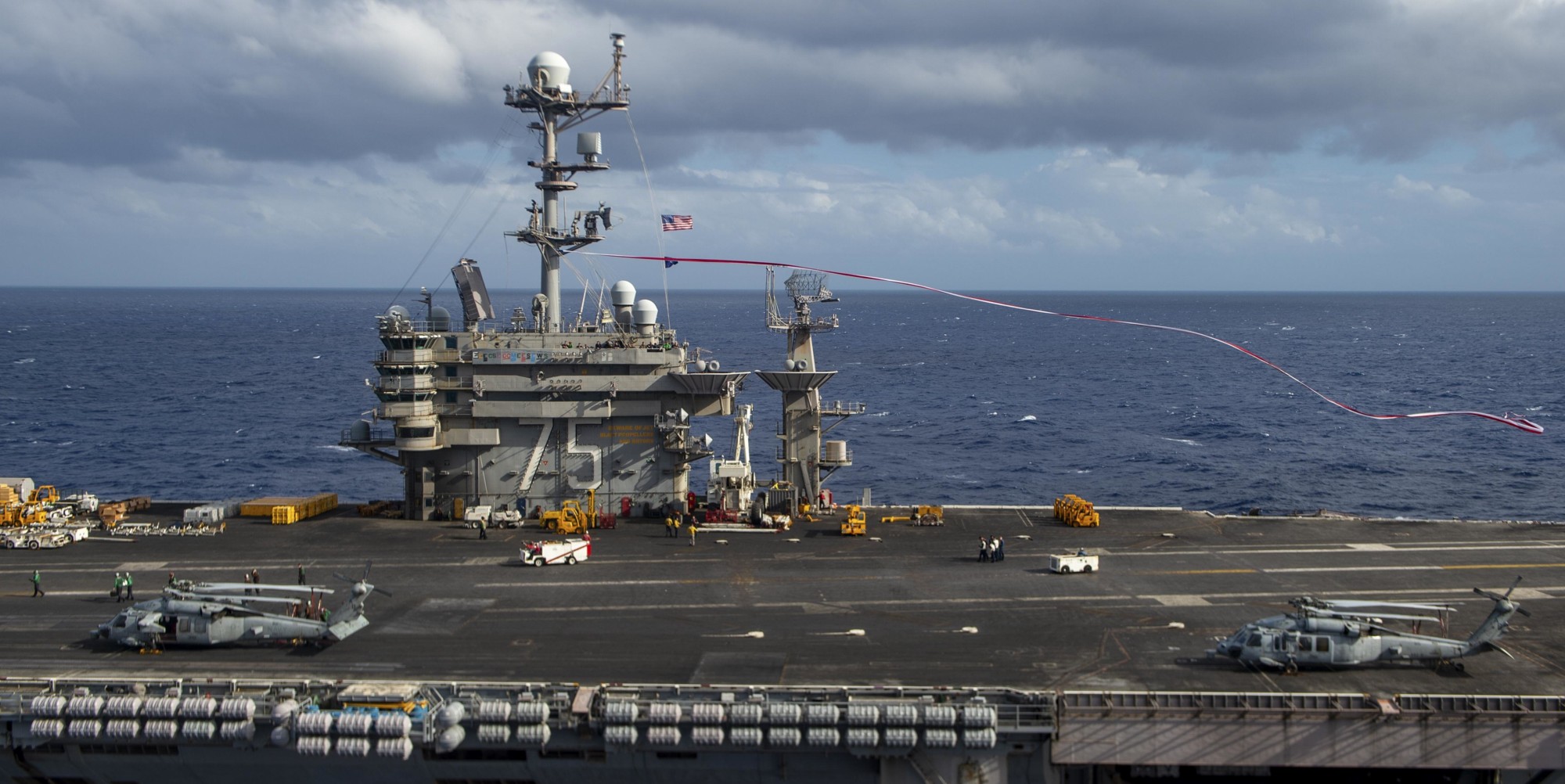 flying the homeward bound pennant - Atlantic Ocean - September 2022 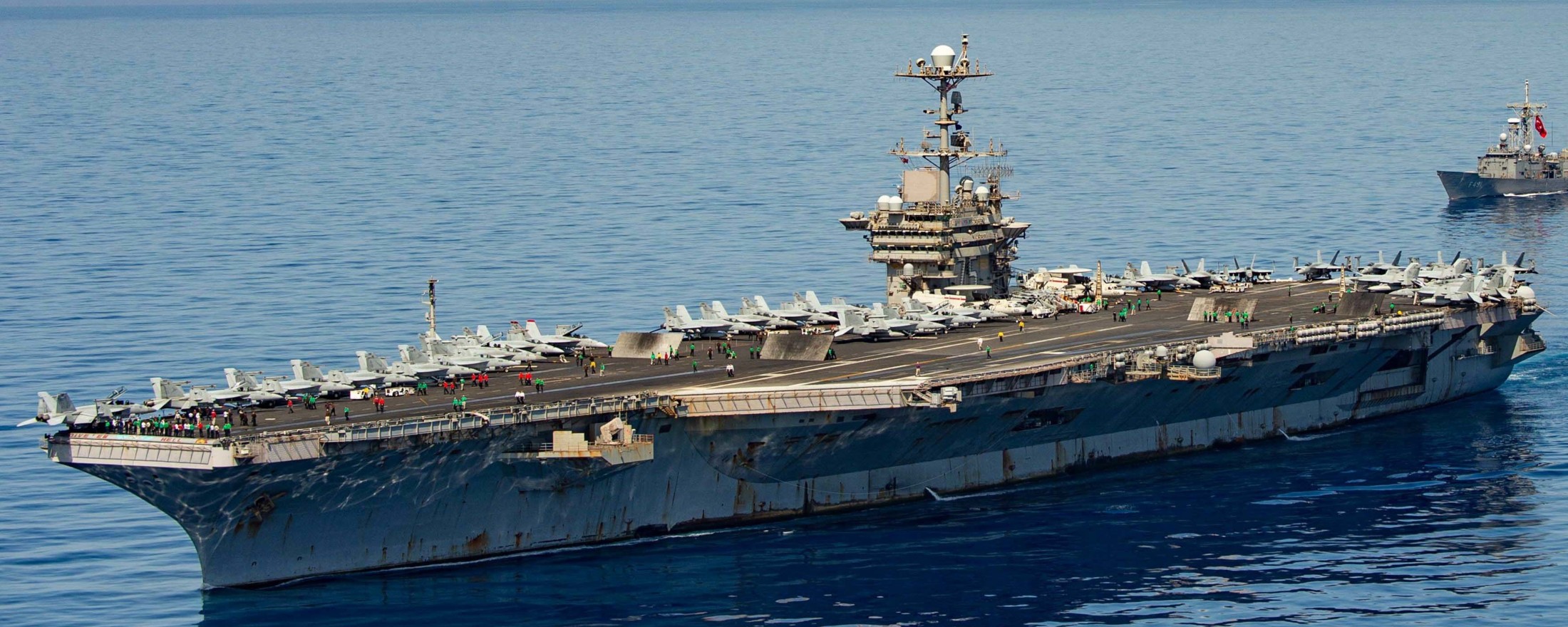 with CVW-1 embarked - Mediterranean Sea - June 2022 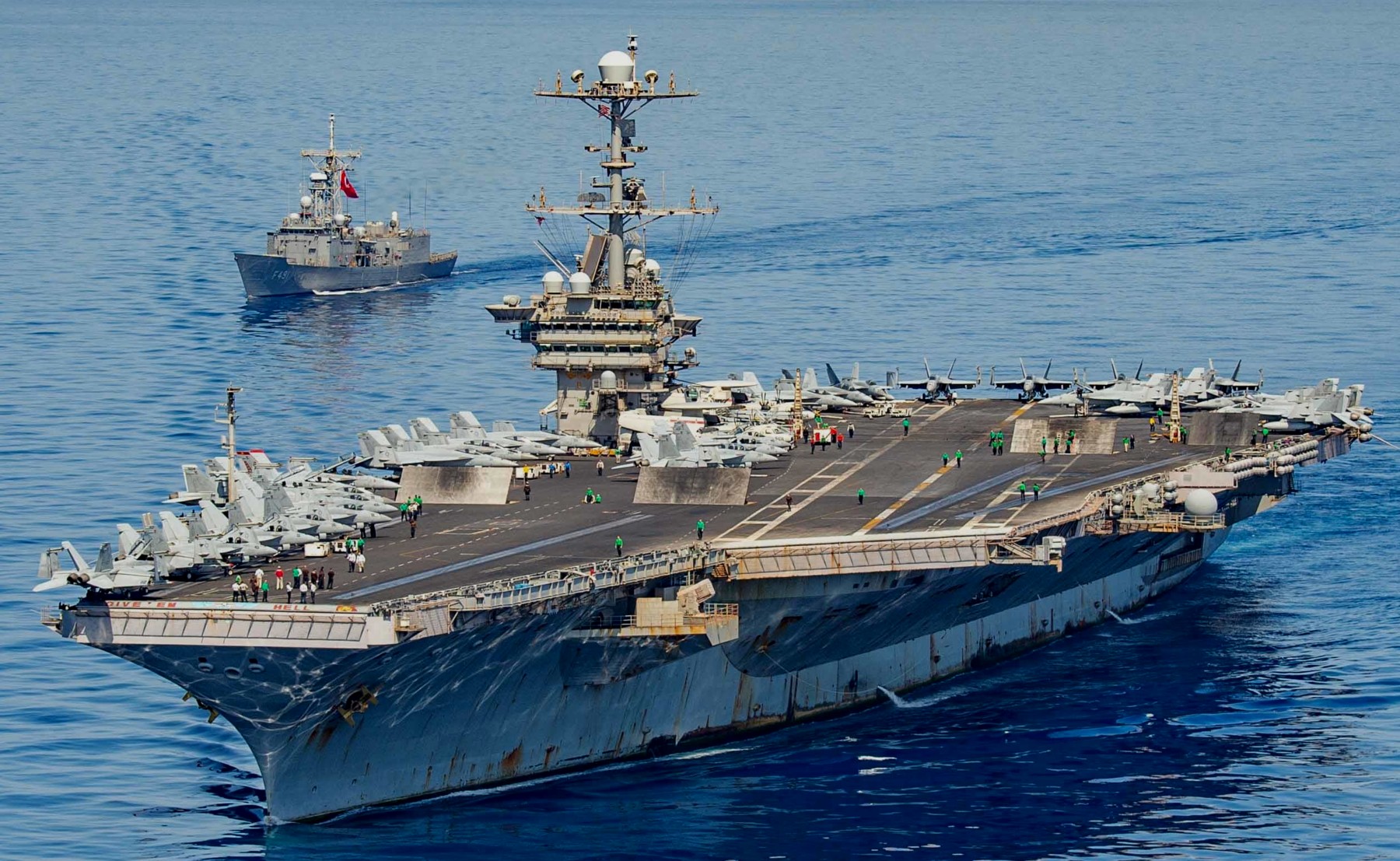 with CVW-1 embarked - Mediterranean Sea - June 2022 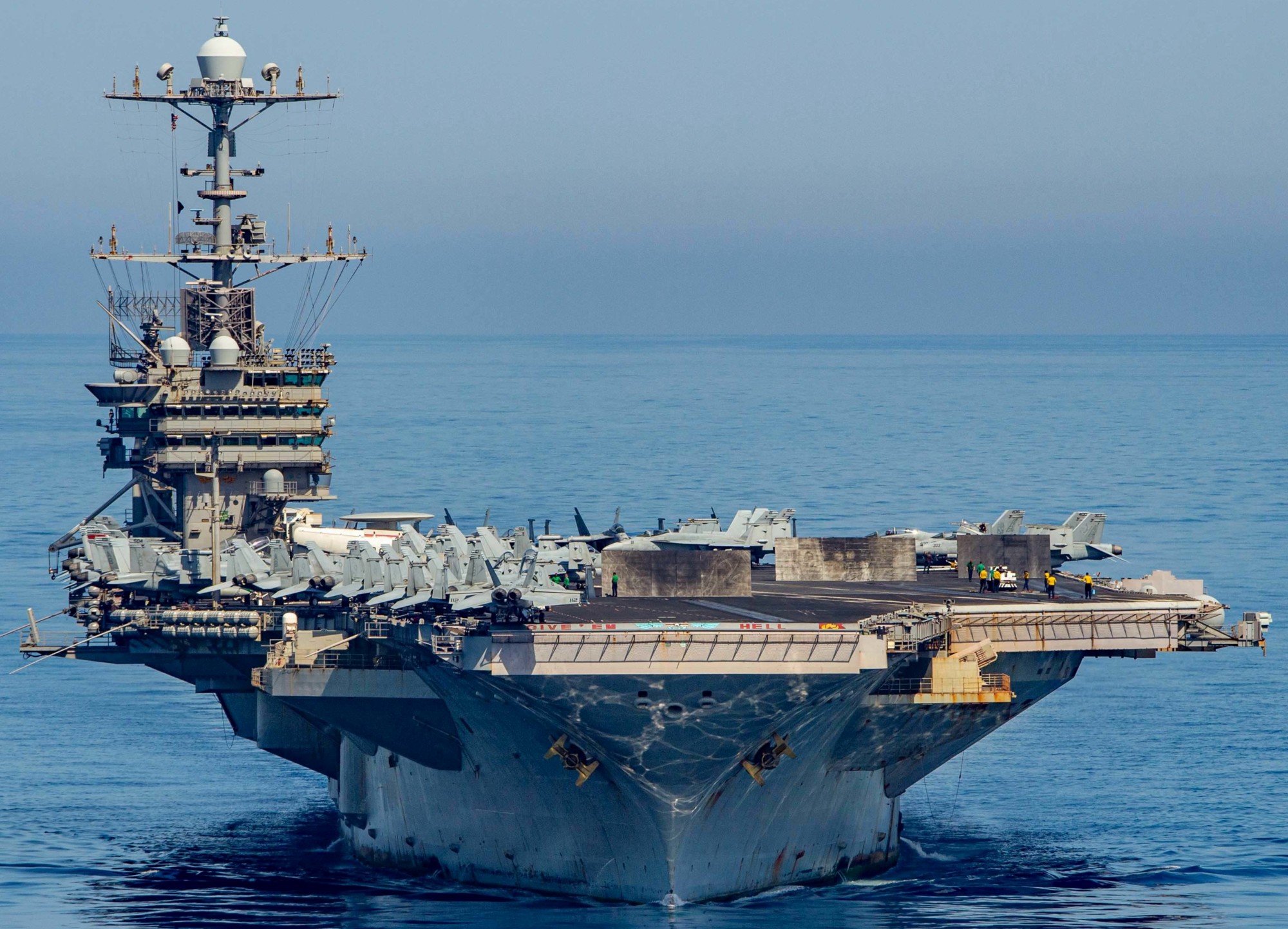 with CVW-1 embarked - Mediterranean Sea - June 2022 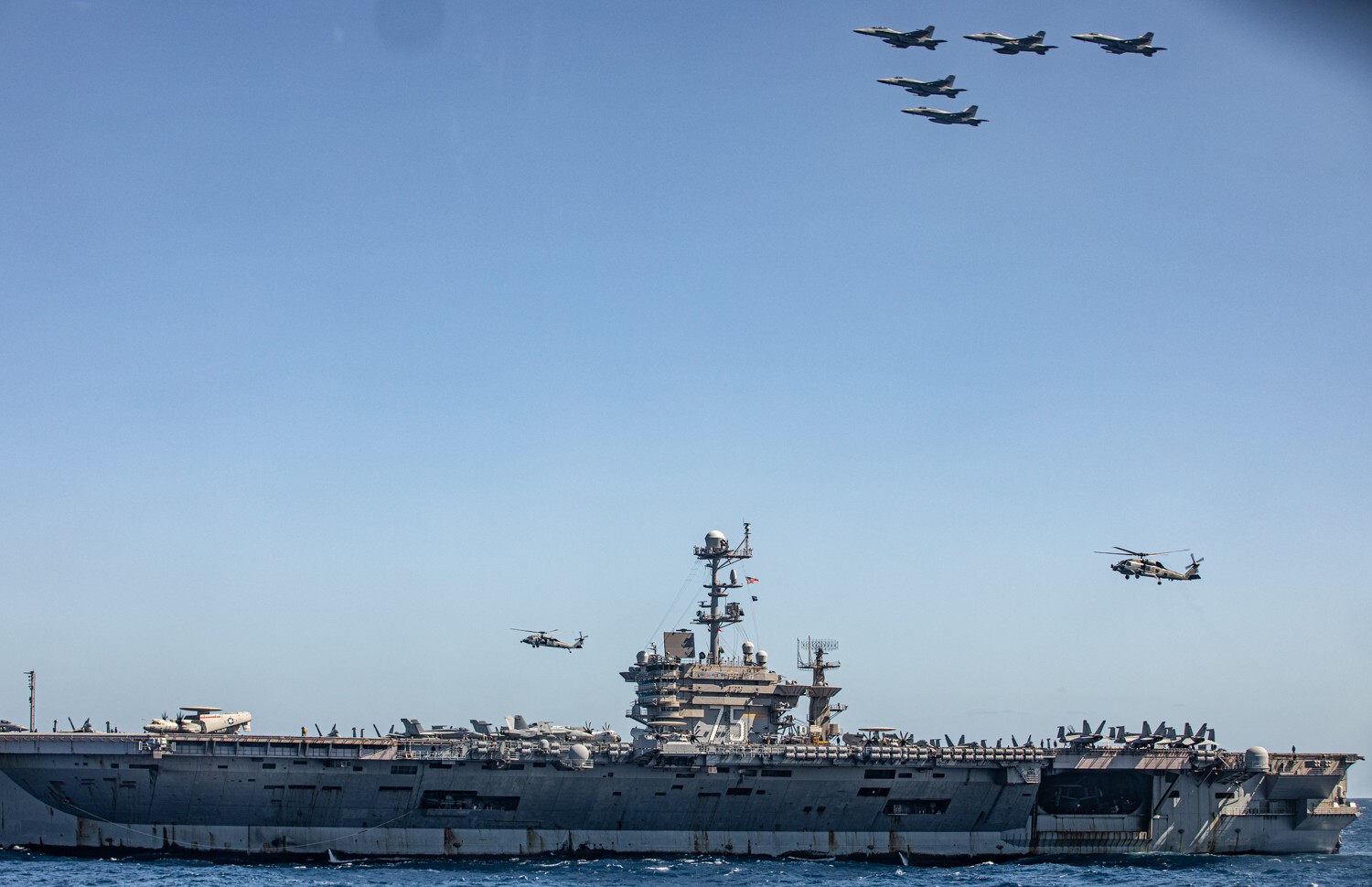 with CVW-1 embarked - Ionian Sea - April 2022 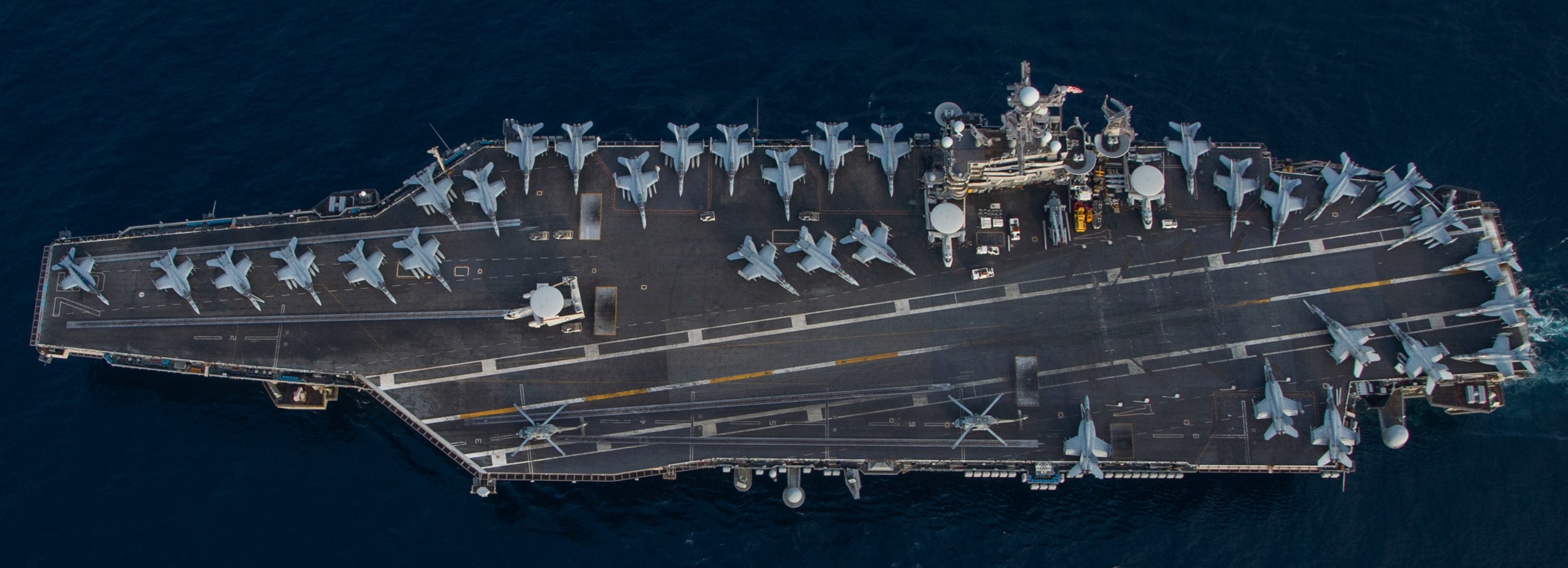 with CVW-1 embarked - Ionian Sea - March 2022 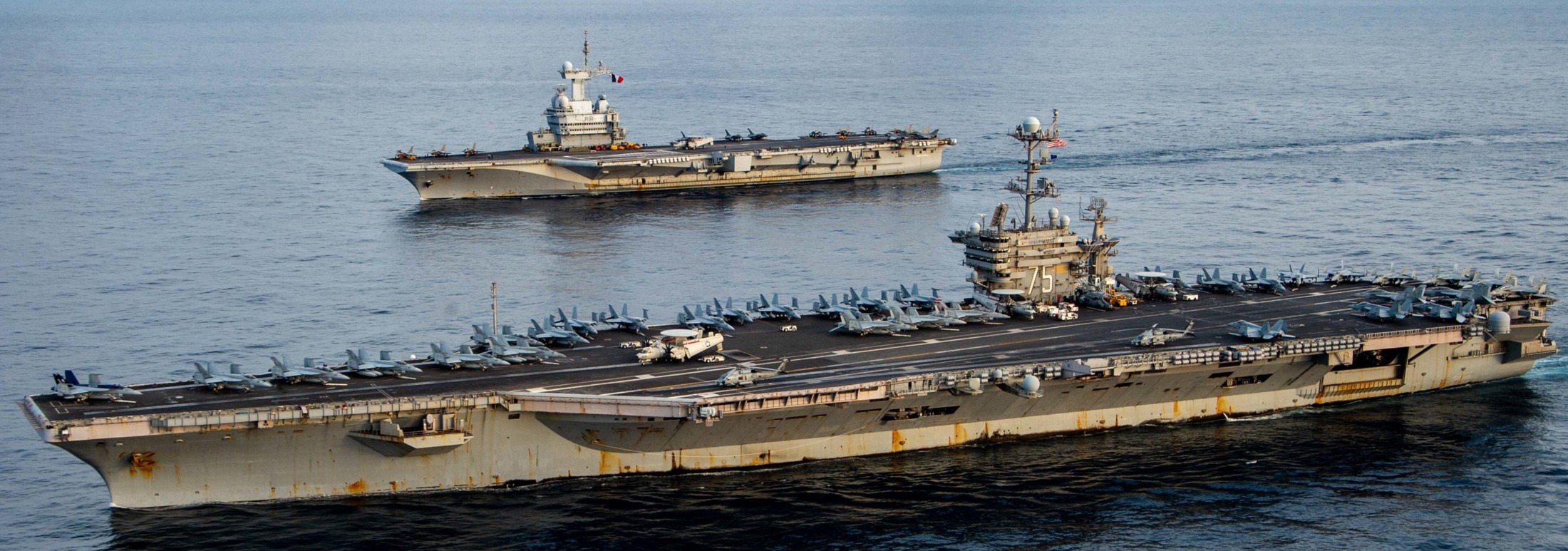 with French Aircraft Carrier FS Charles de Gaulle (R 91) - Ionian Sea - March 2022 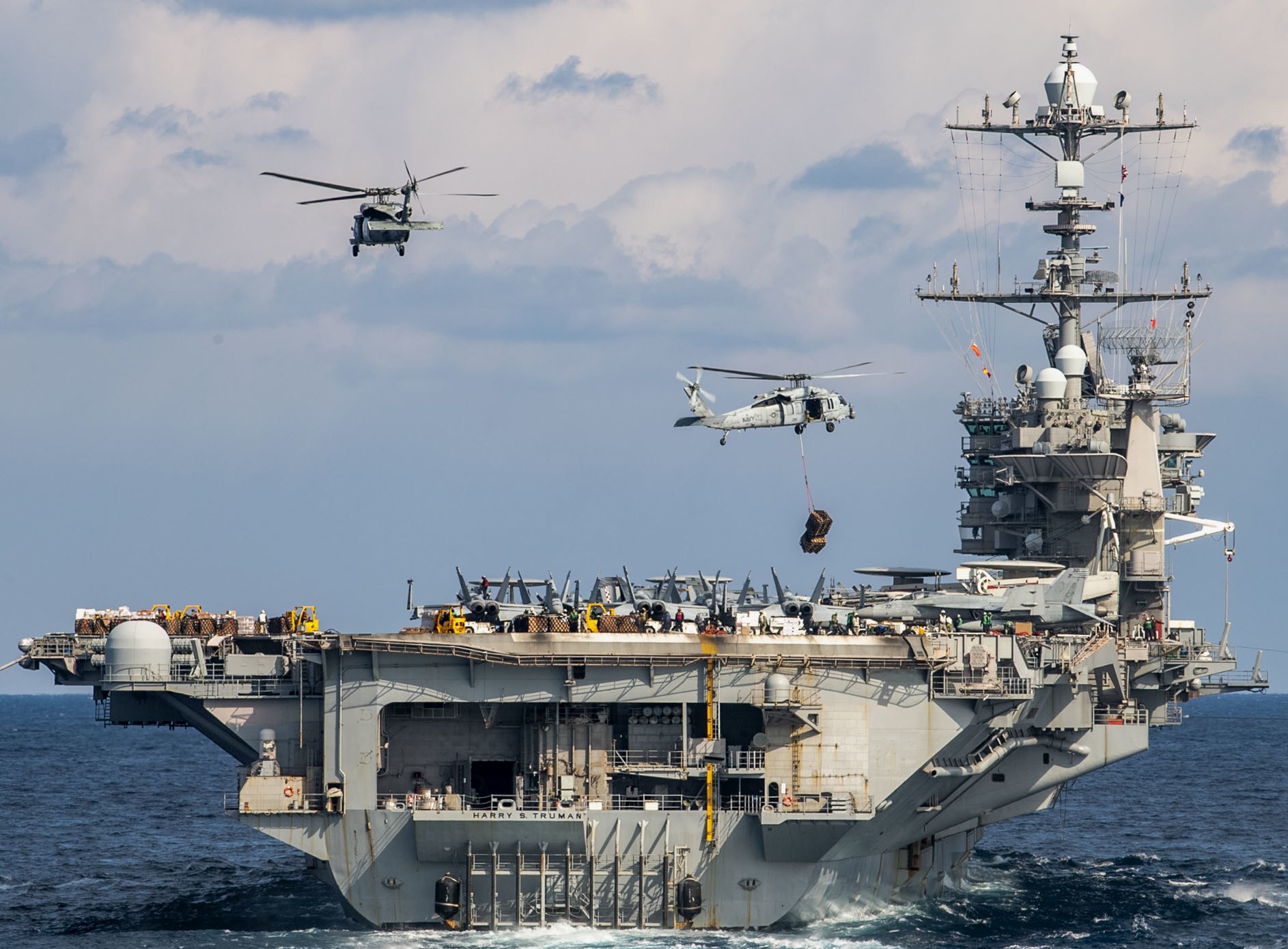 with CVW-1 embarked - Ionian Sea - March 2022 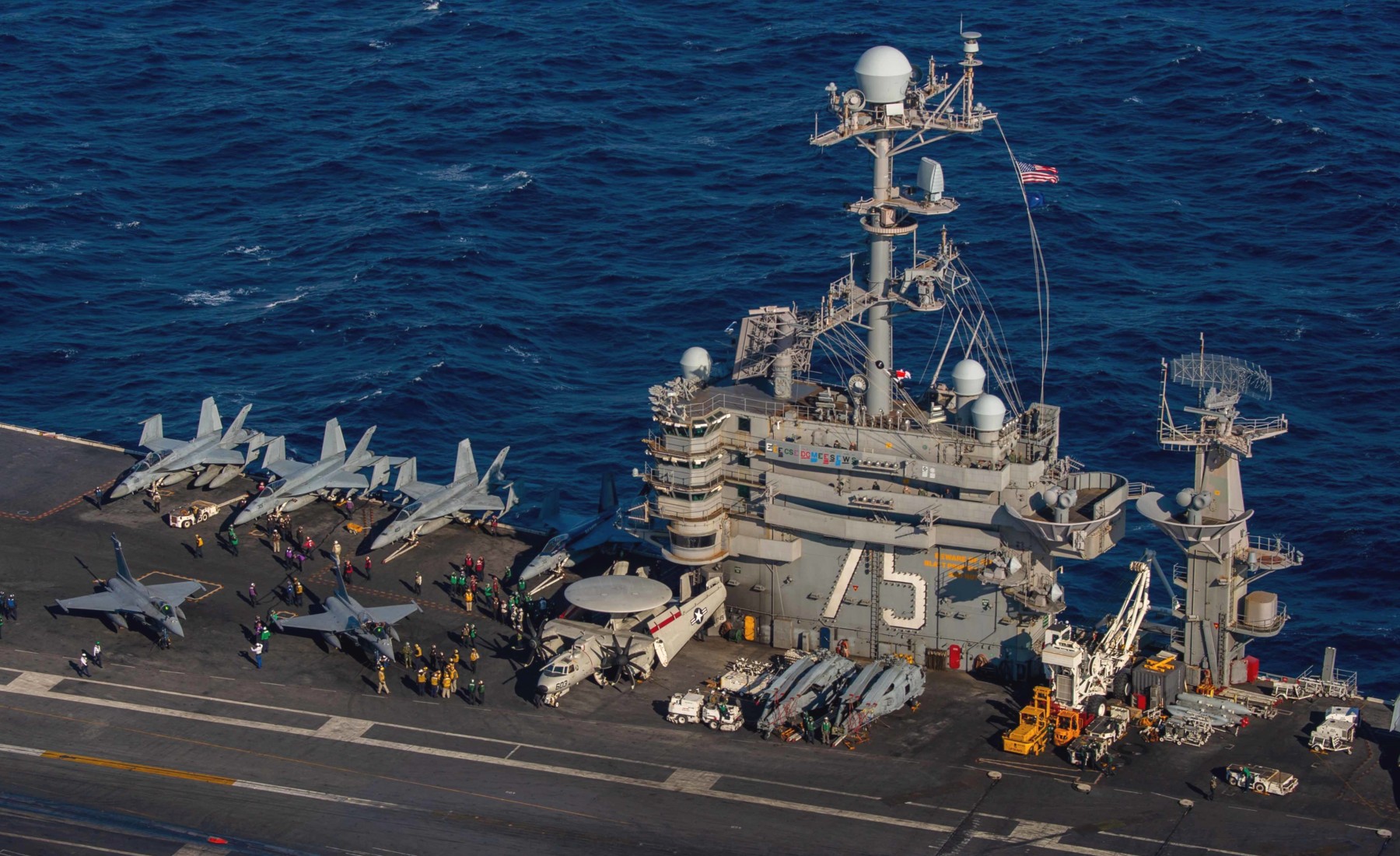 with CVW-1 embarked - Ionian Sea - March 2022 - note the two french Navy Rafale-M fighter aircraft 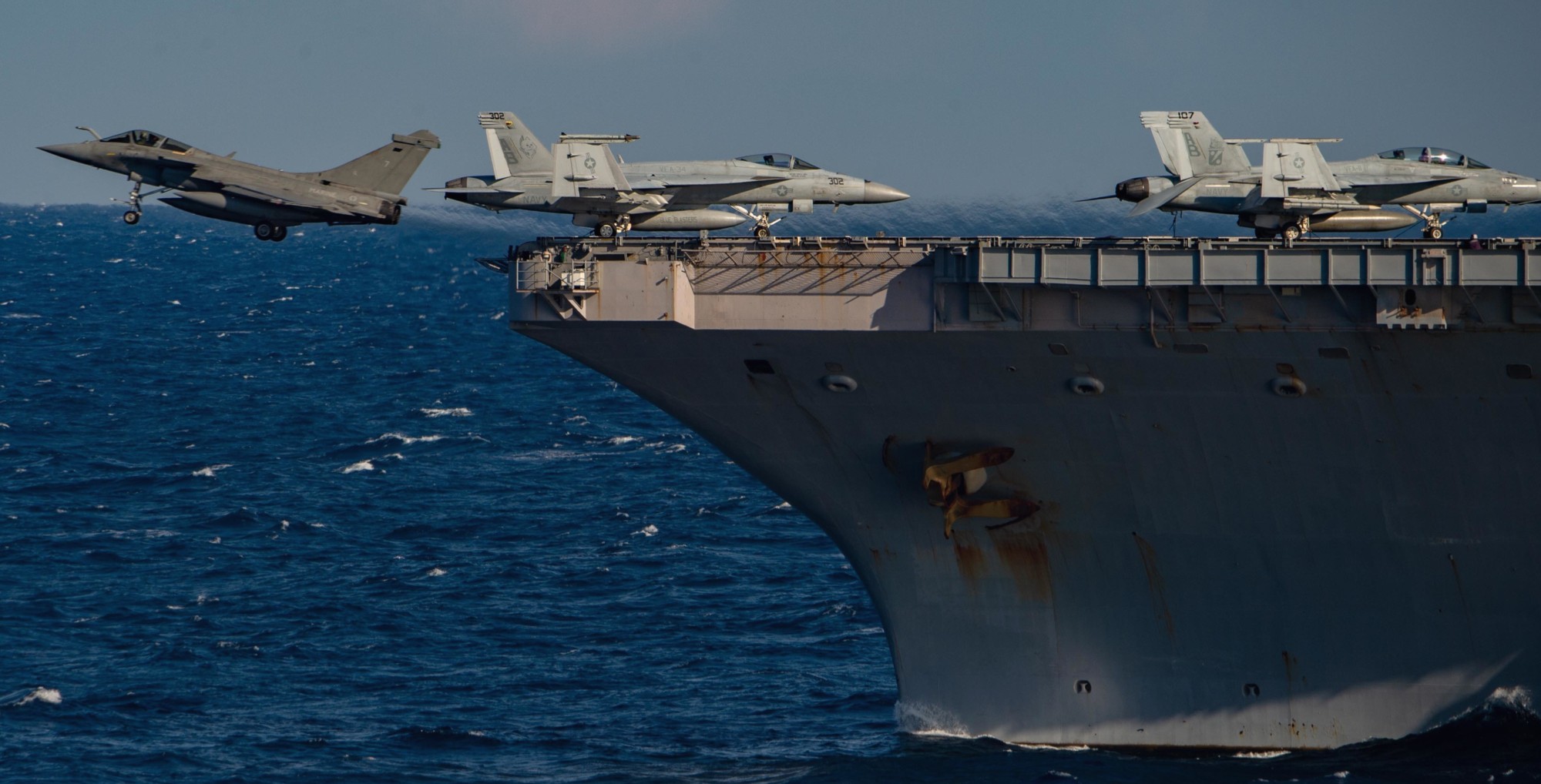 a French Navy Rafale-M aircraft is taking off - Ionian Sea - March 2022 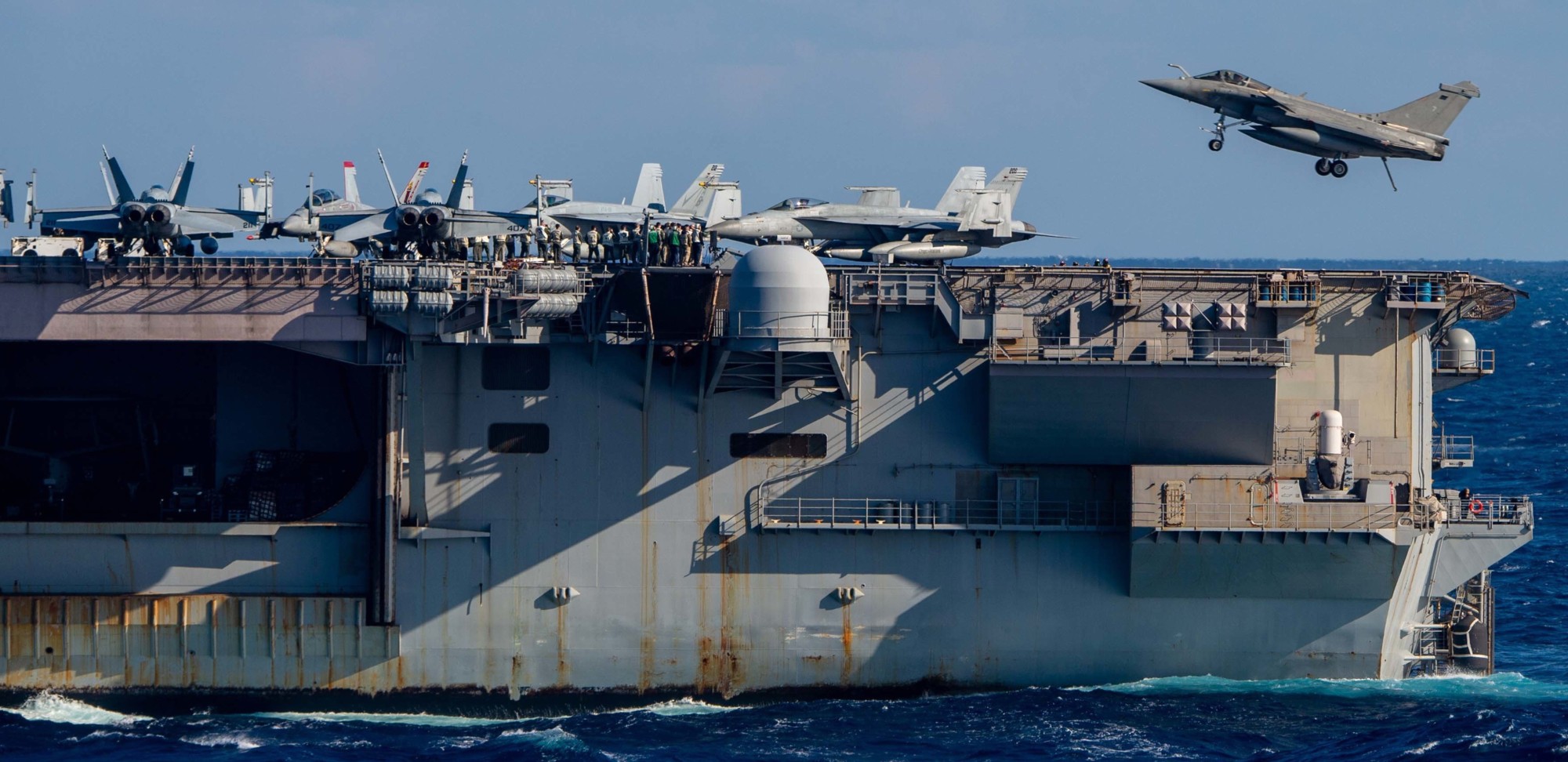 a French Navy Rafale-M aircraft is landing - Ionian Sea - March 2022 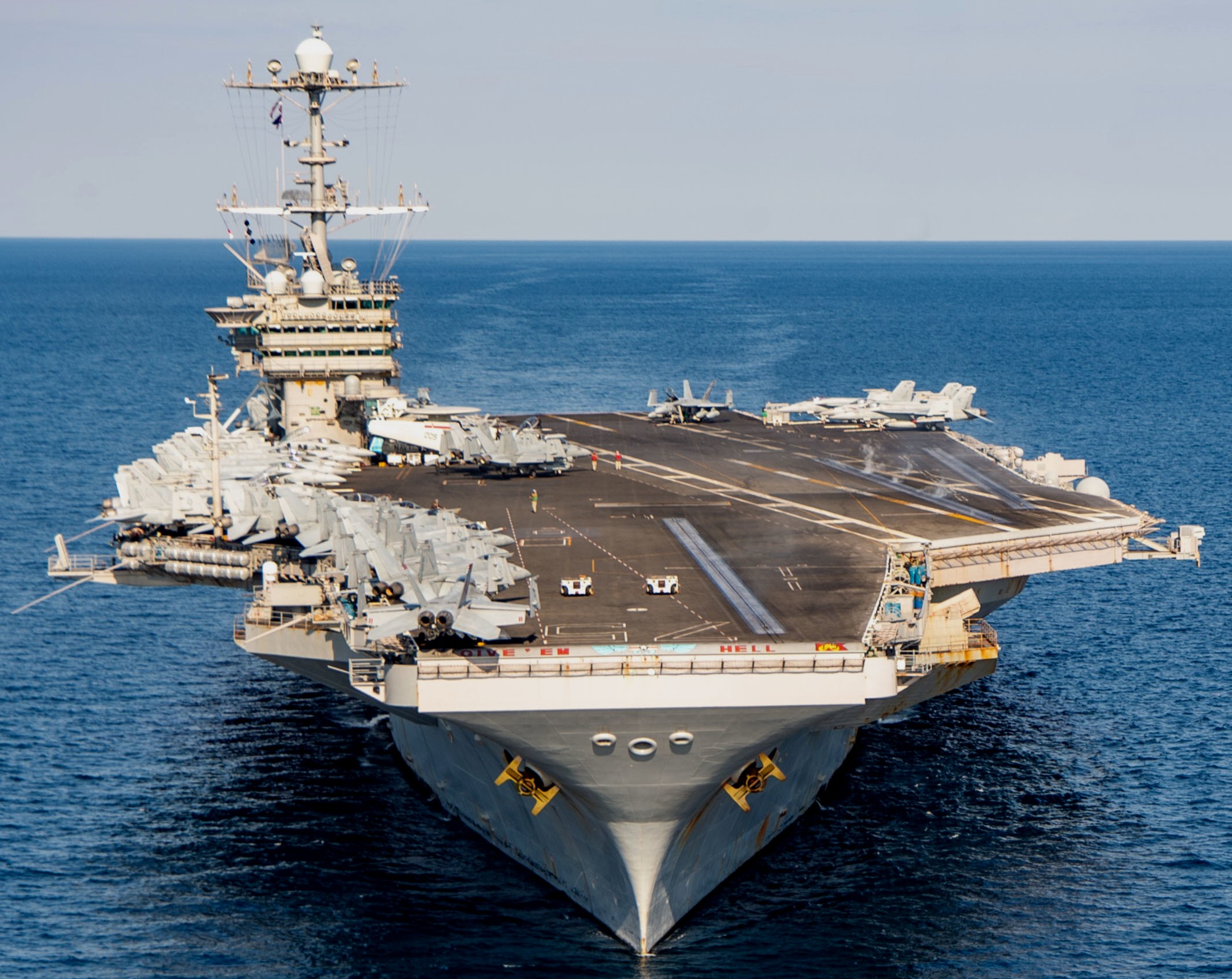 with CVW-1 embarked - Aegean Sea - March 2022 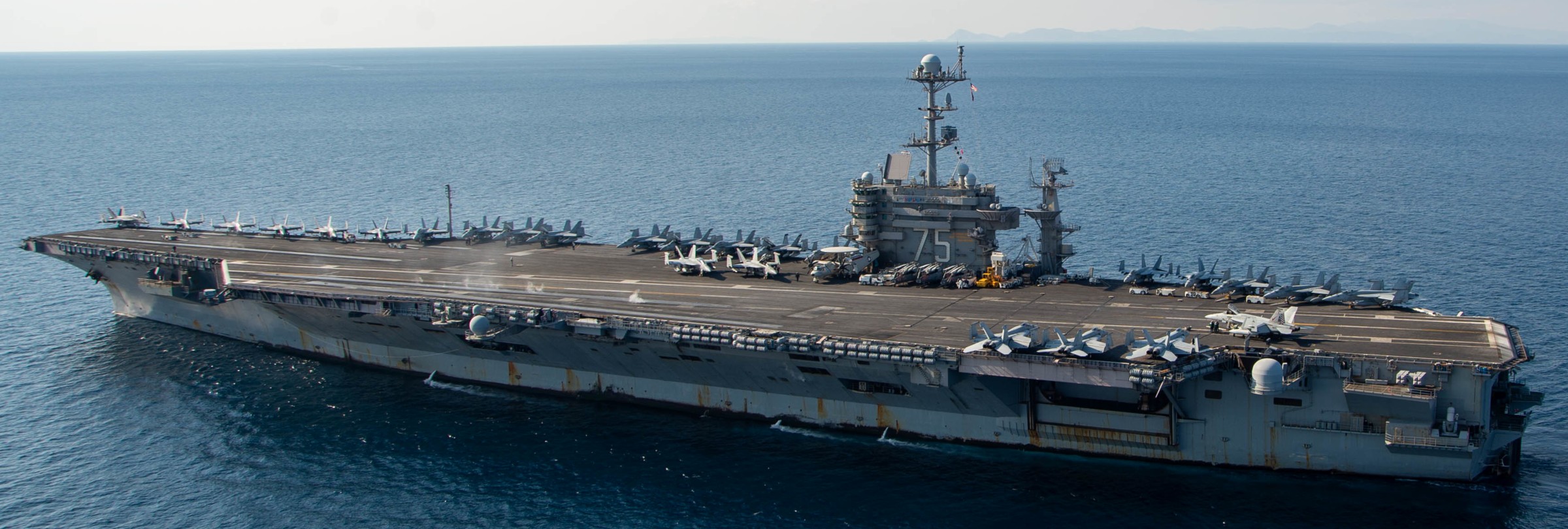 with CVW-1 embarked - Aegean Sea - March 2022 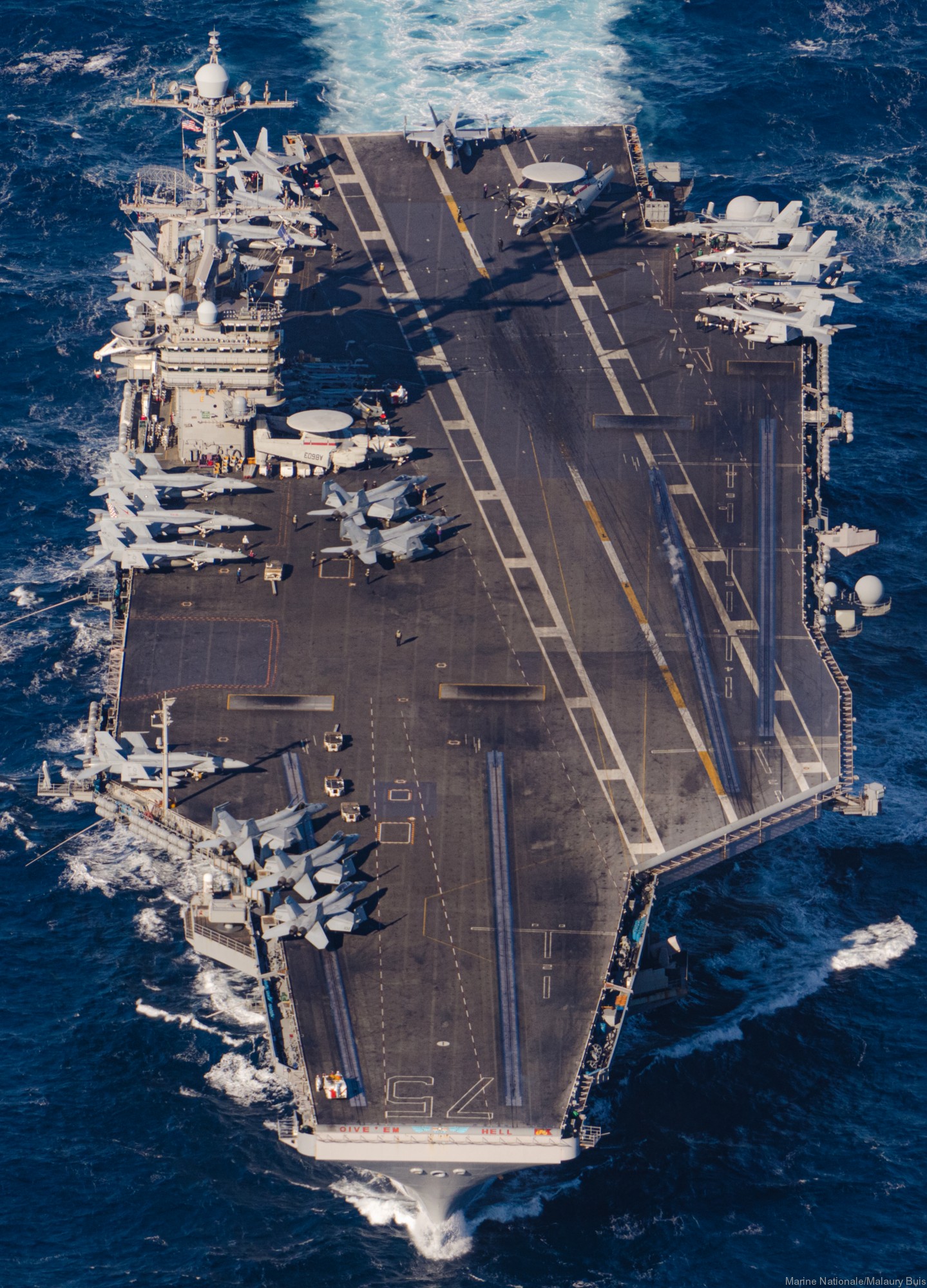 with CVW-1 embarked - exercise Neptune Strike - Mediterranean Sea - February 2022 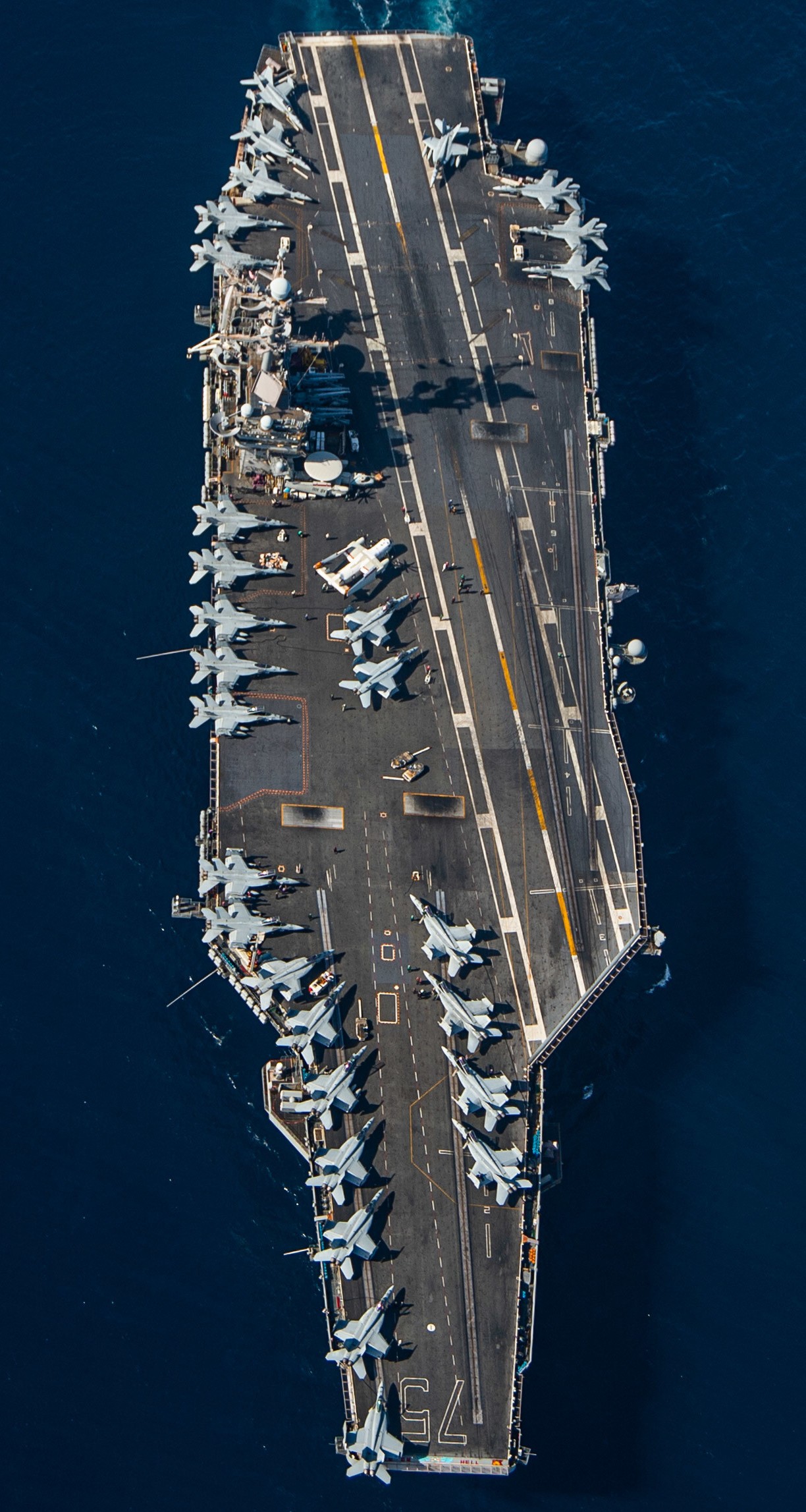 with CVW-1 embarked - exercise Neptune Strike - Mediterranean Sea - February 2022 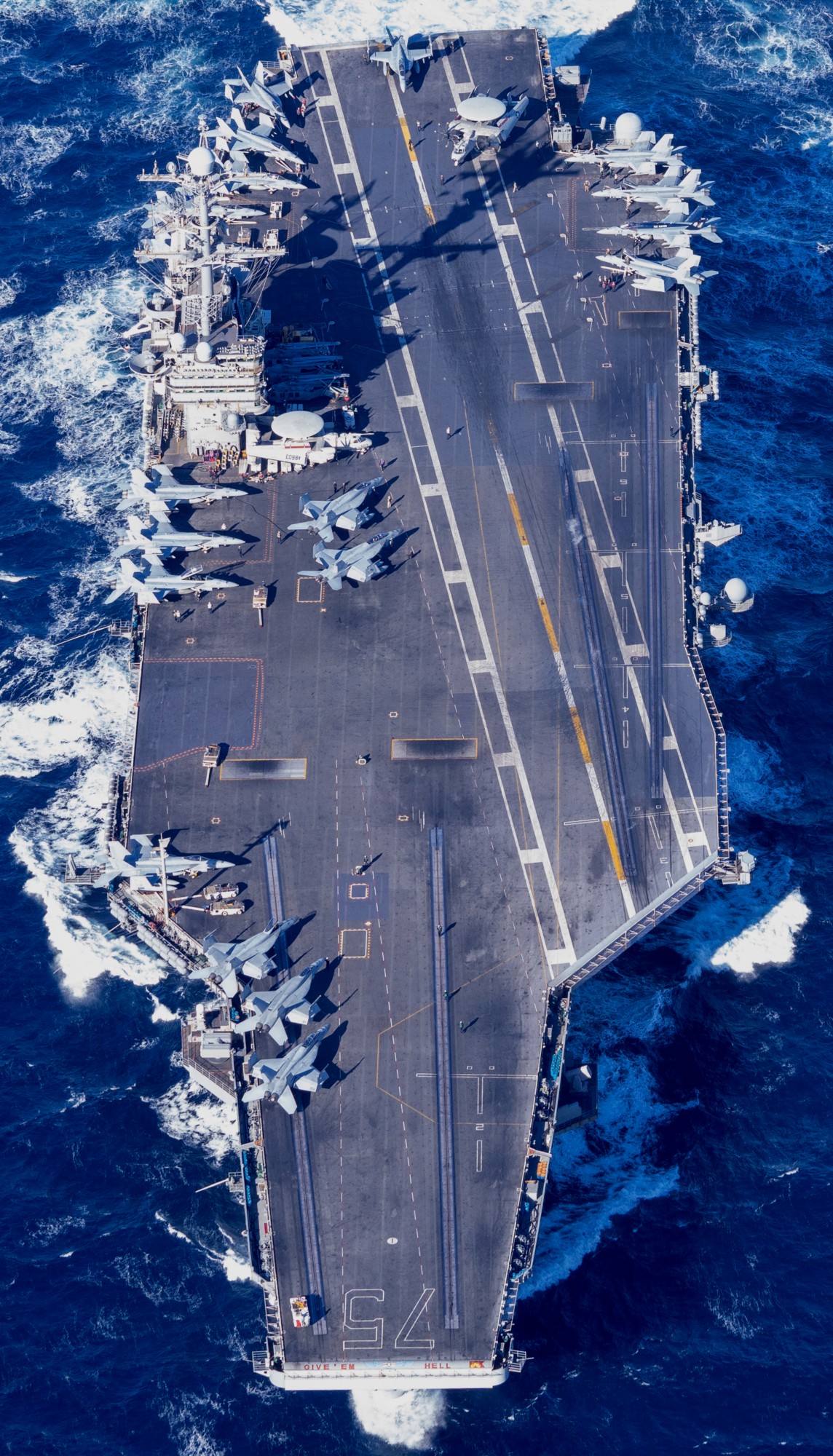 with CVW-1 embarked - exercise Neptune Strike - Mediterranean Sea - February 2022 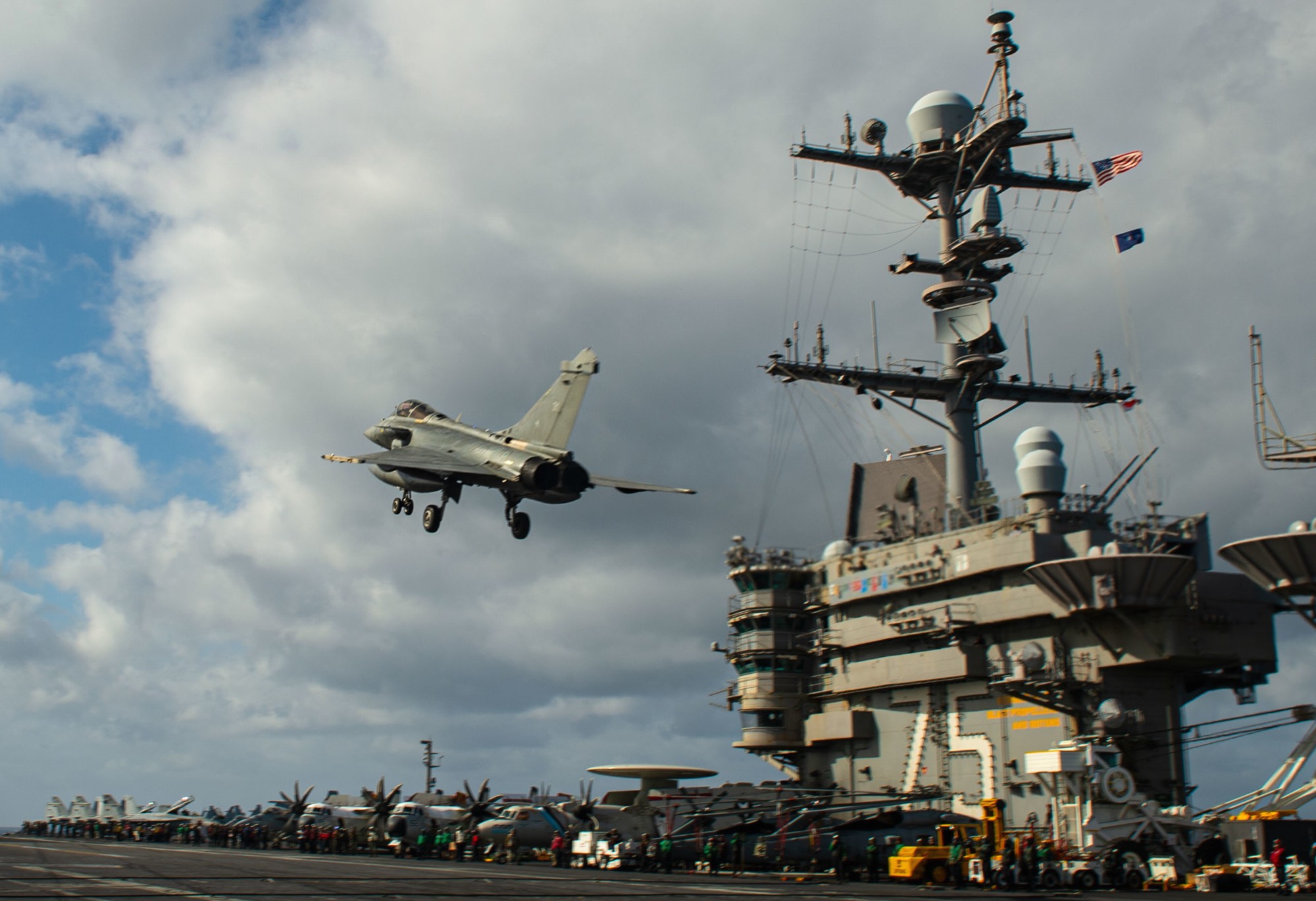 French Navy Rafele-M operations - Mediterranean Sea - February 2022  with CVW-1 embarked - Mediterranean Sea - January 2022 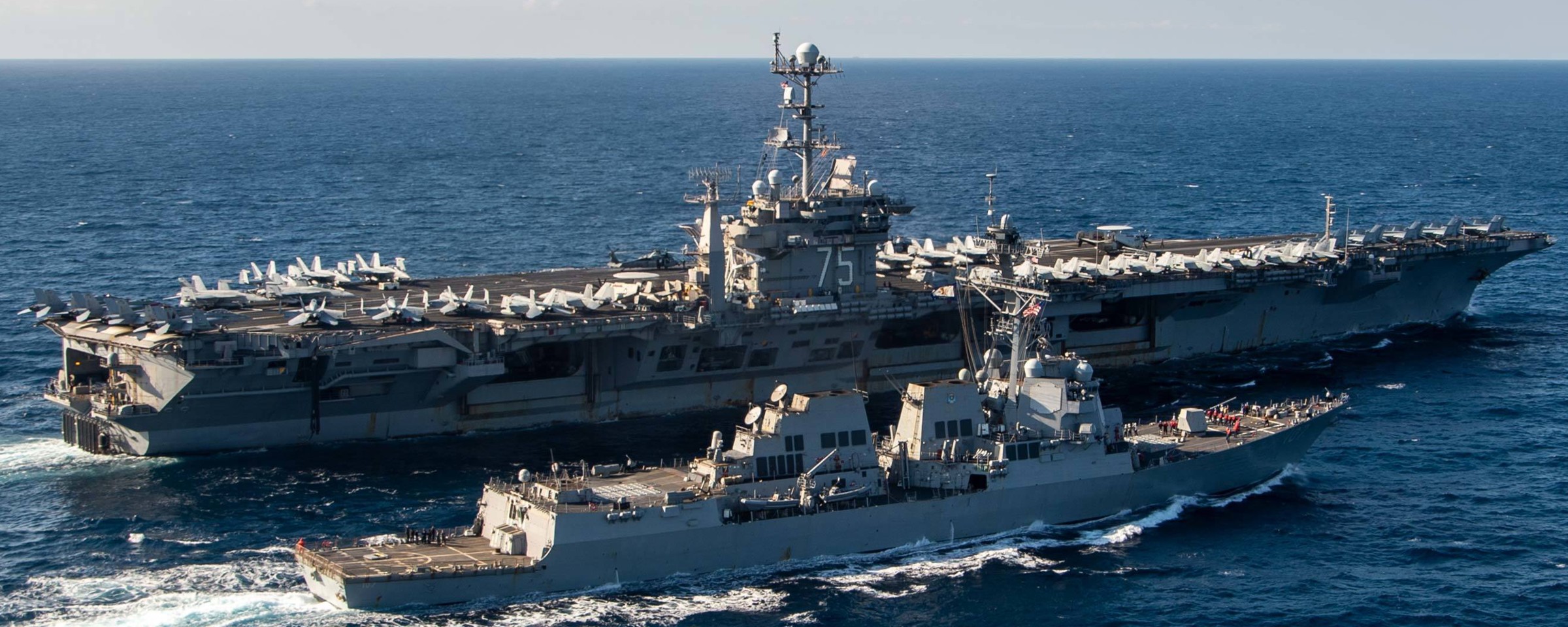 with CVW-1 embarked - Mediterranean Sea - January 2022 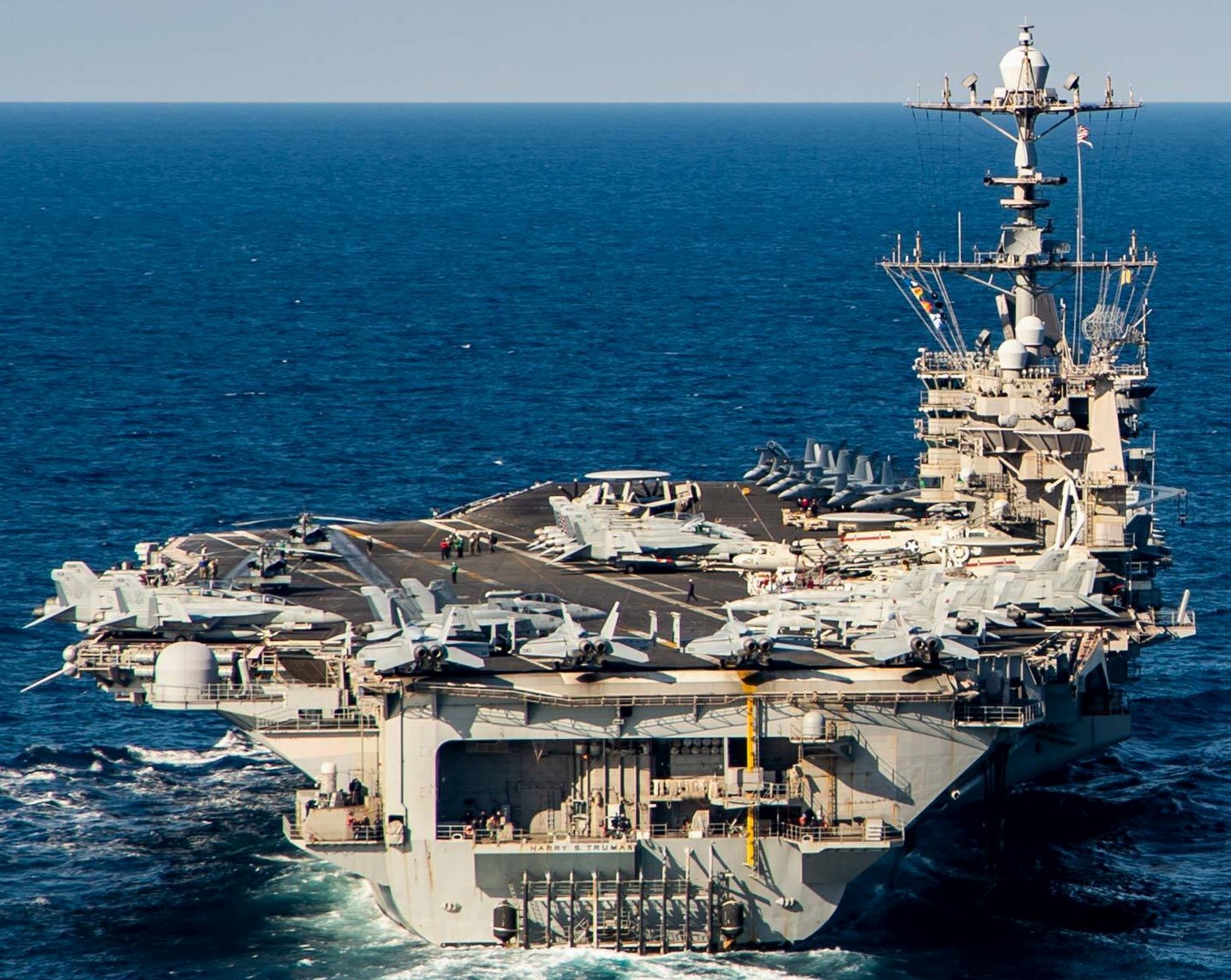 with CVW-1 embarked - Mediterranean Sea - January 2022 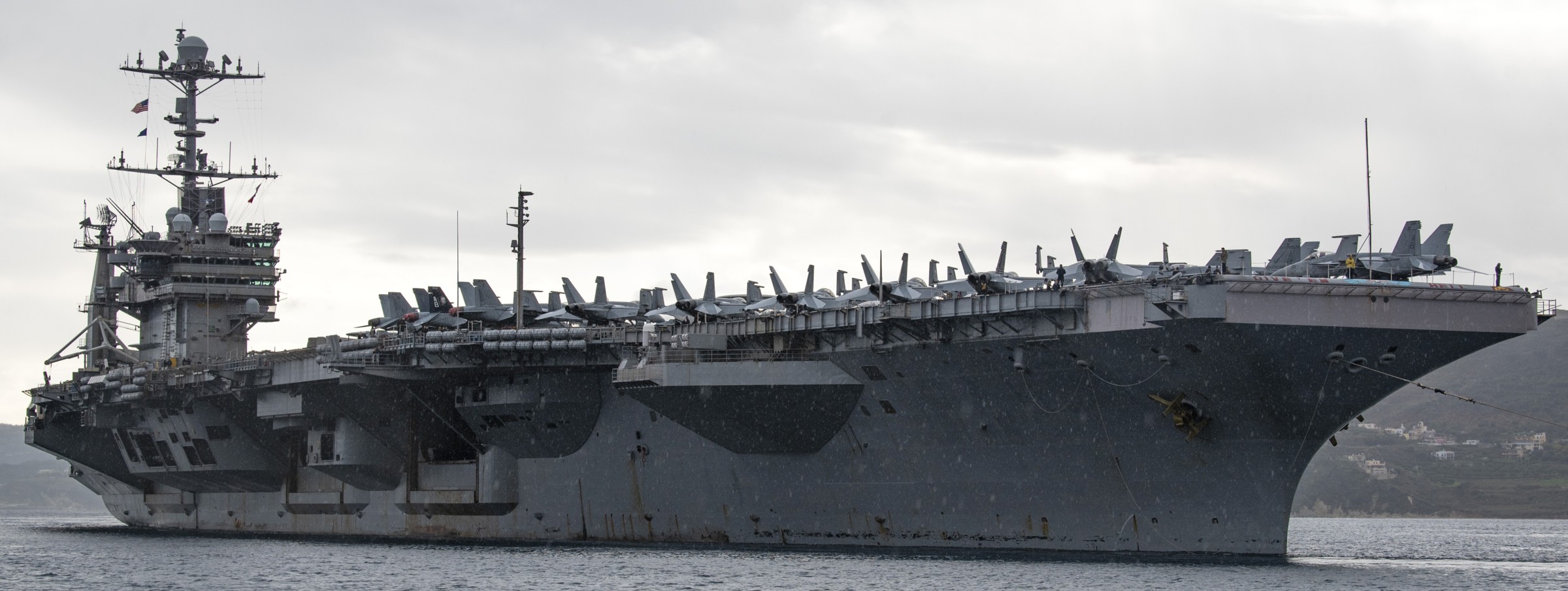 with CVW-1 embarked - Souda Bay, Crete, Greece - December 2021 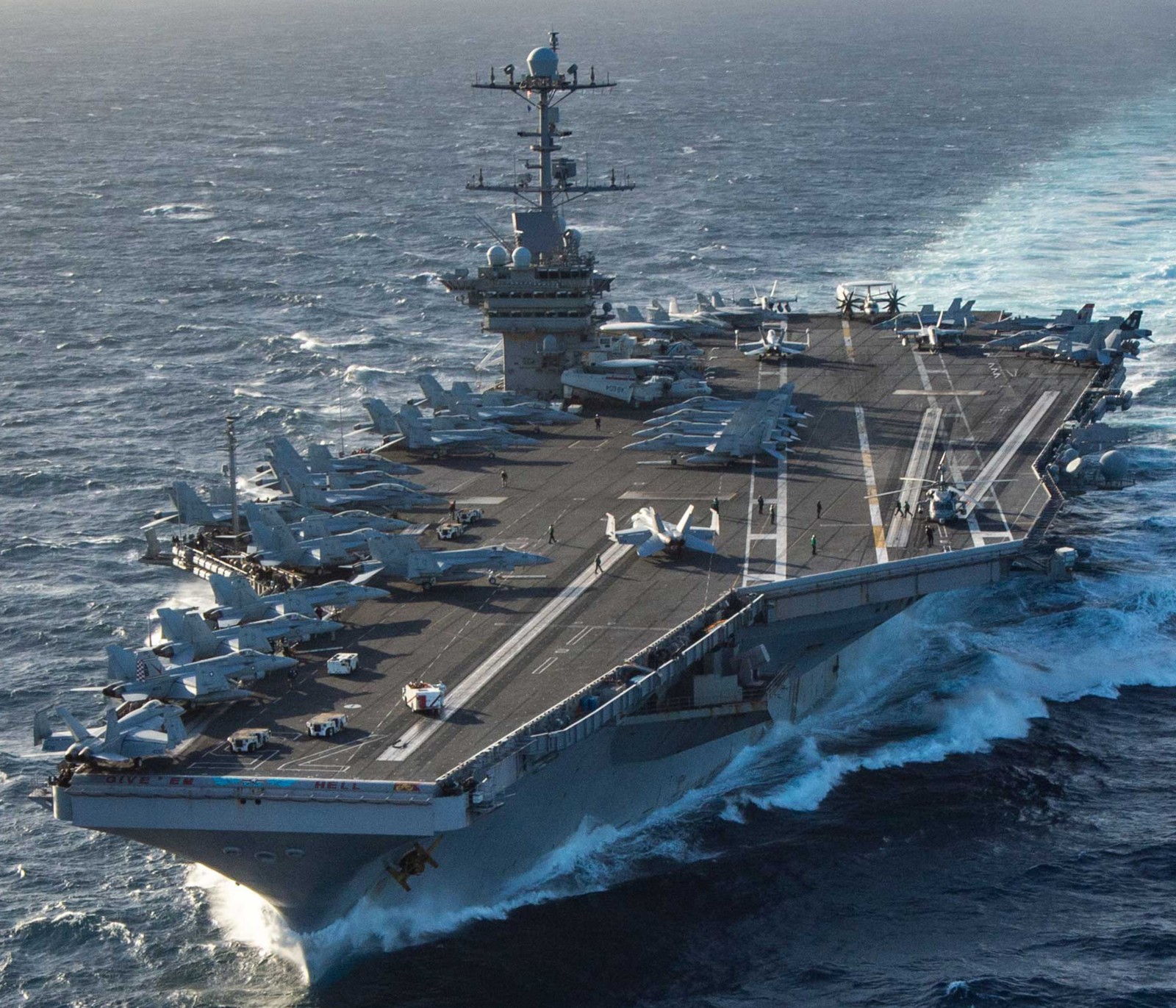 with CVW-1 embarked - Strait of Gibraltar - December 2021 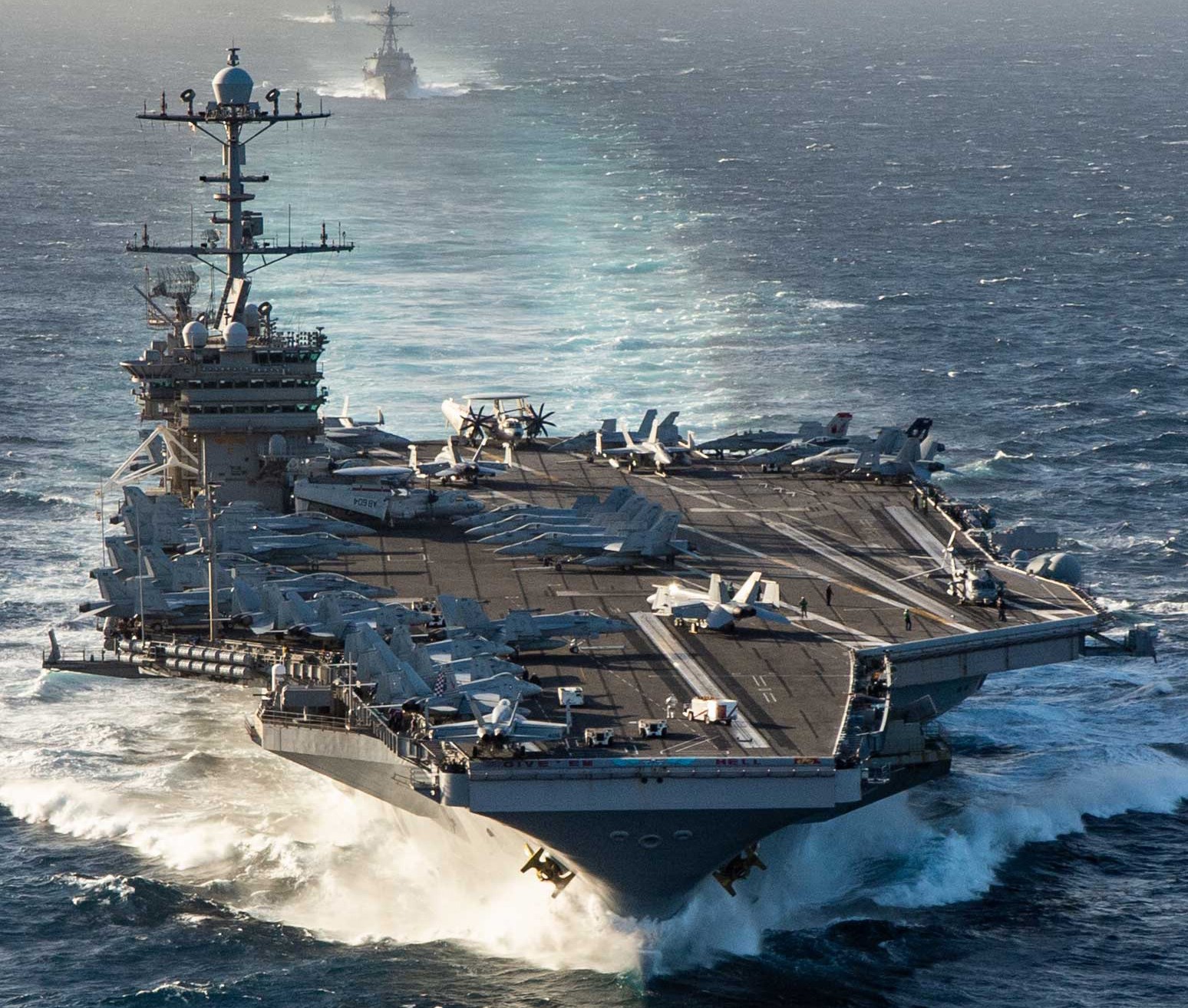 with CVW-1 embarked - Strait of Gibraltar - December 2021 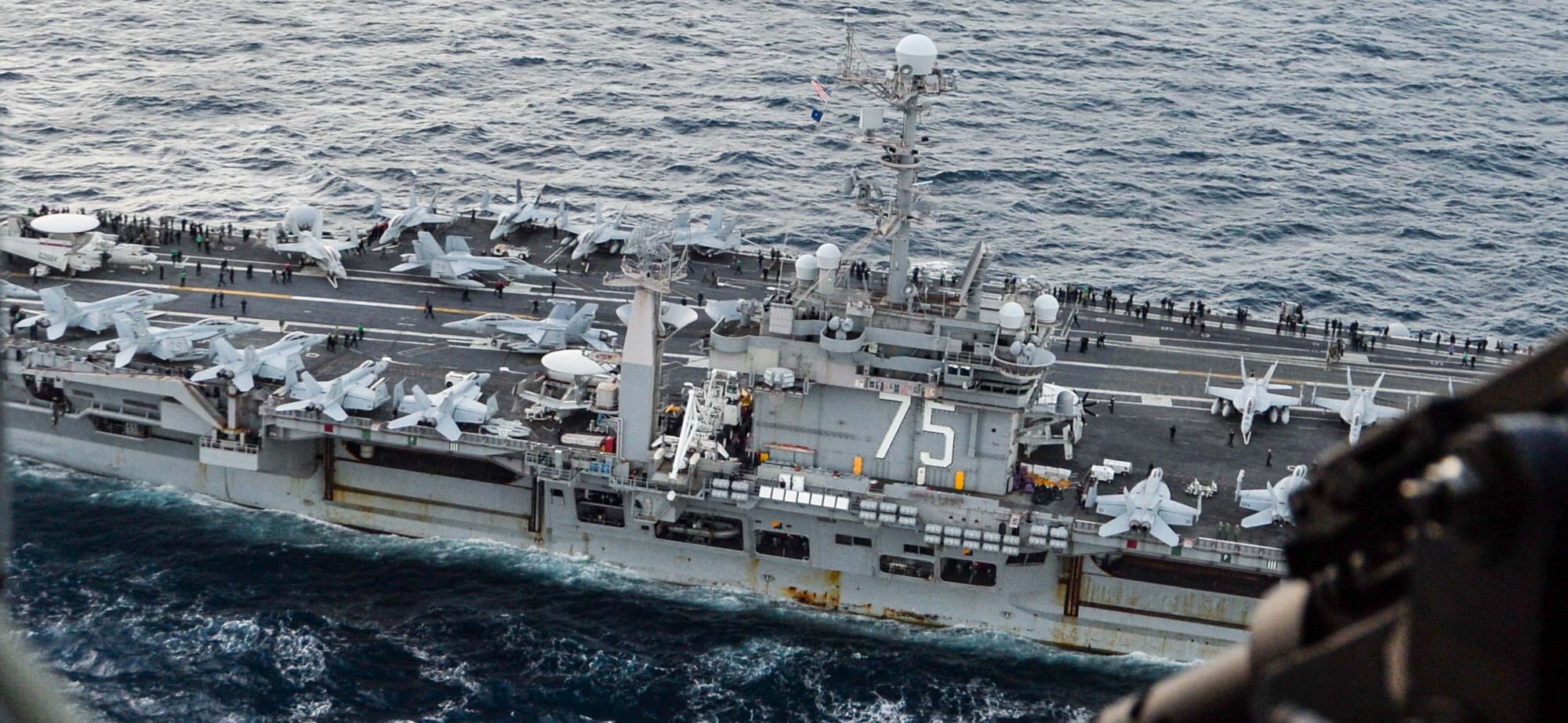 with CVW-1 embarked - Strait of Gibraltar - December 2021 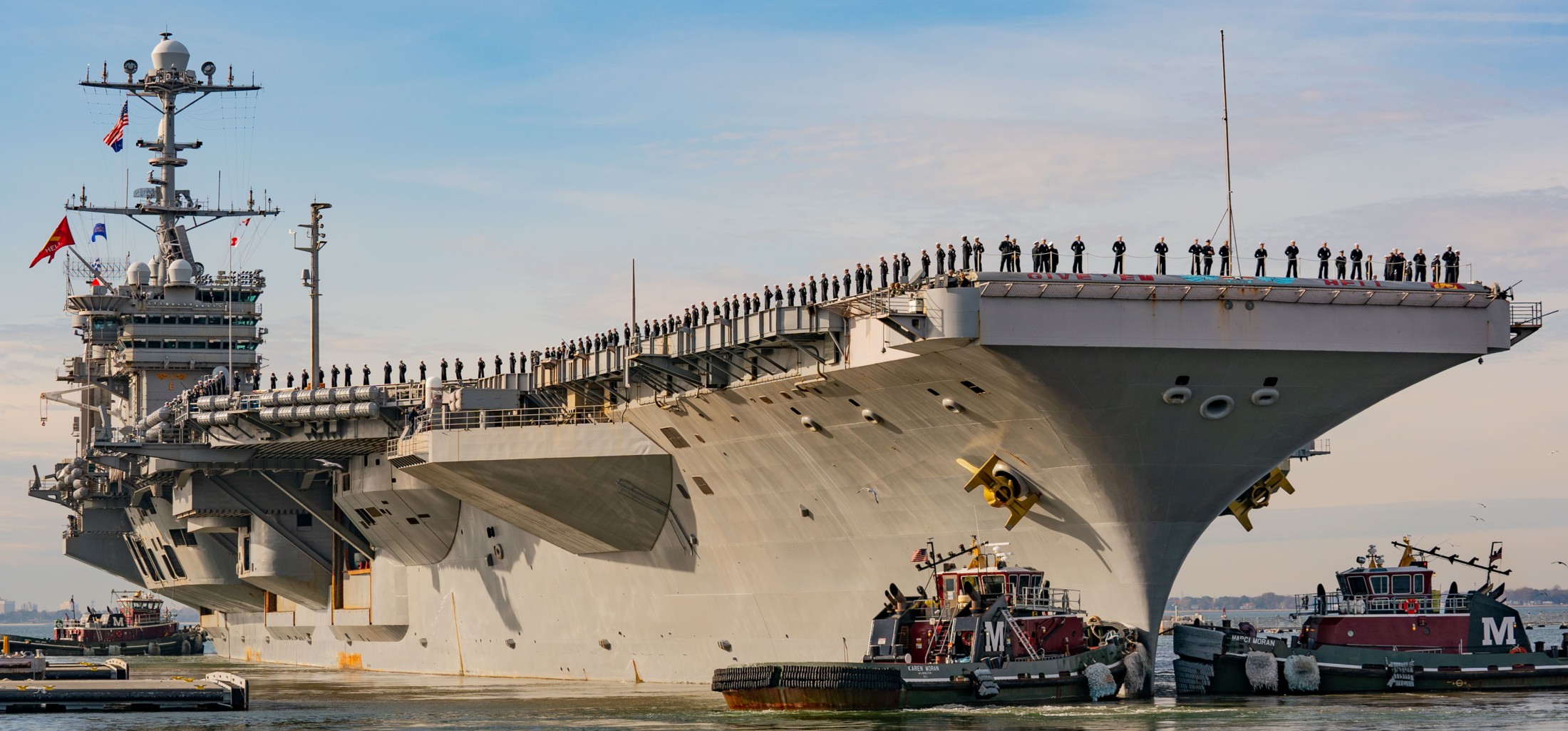 departing Naval Station Norfolk, Virginia - December 2021 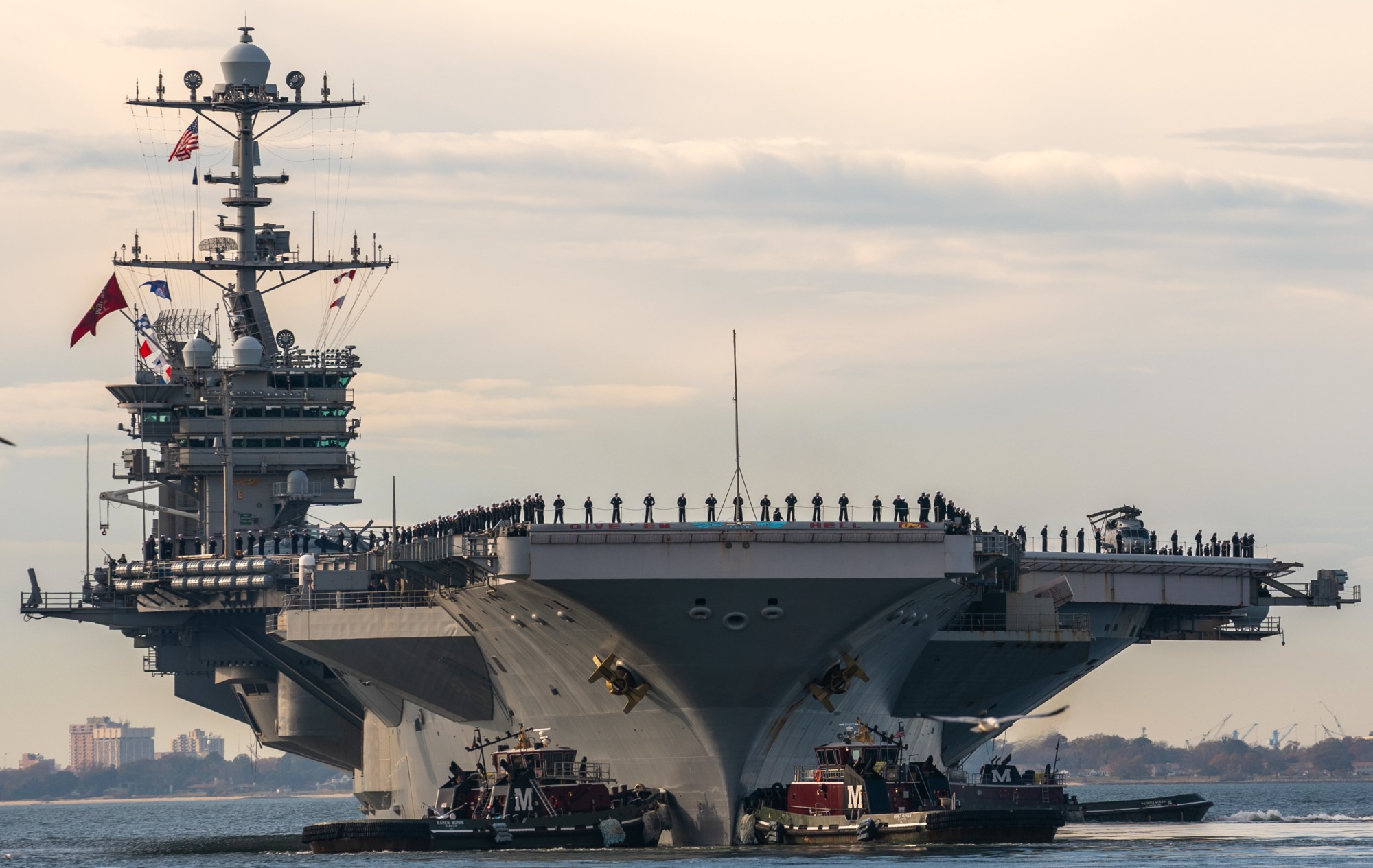 departing Naval Station Norfolk, Virginia - December 2021 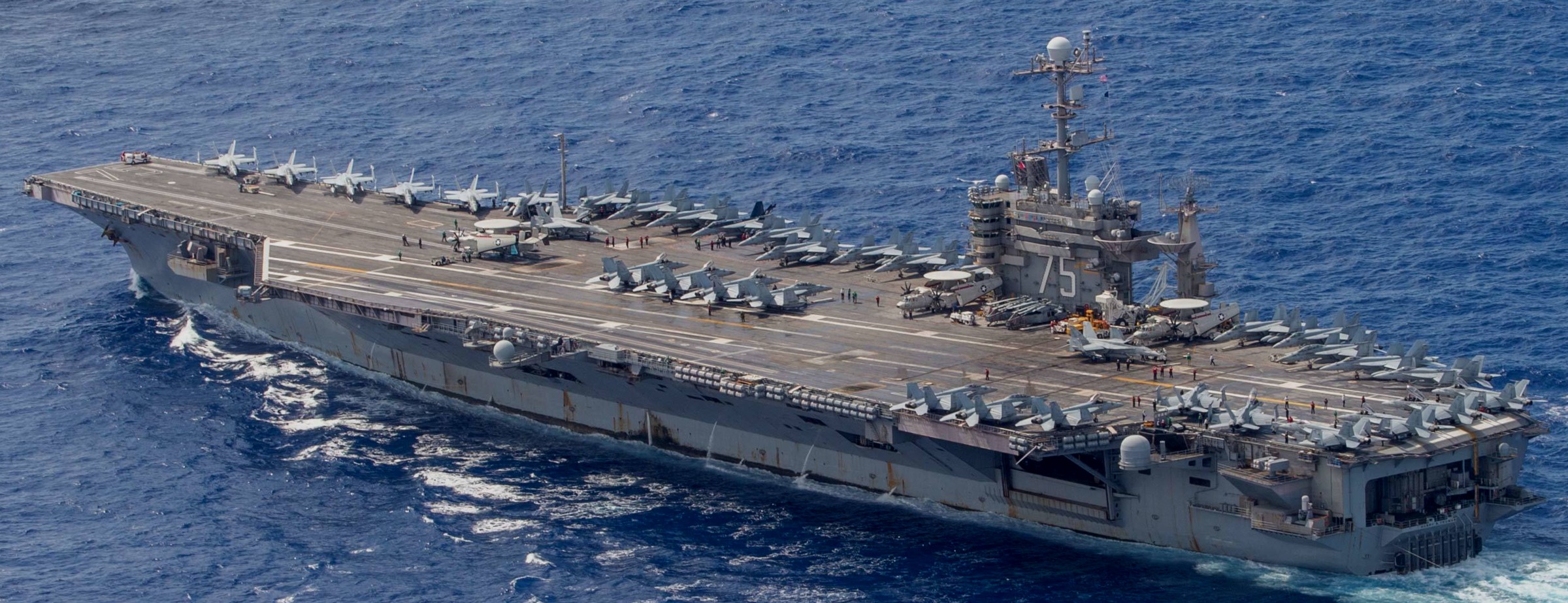 with CVW-1 embarked - Atlantic Ocean - October 2021  with CVW-1 embarked - Atlantic Ocean - October 2021 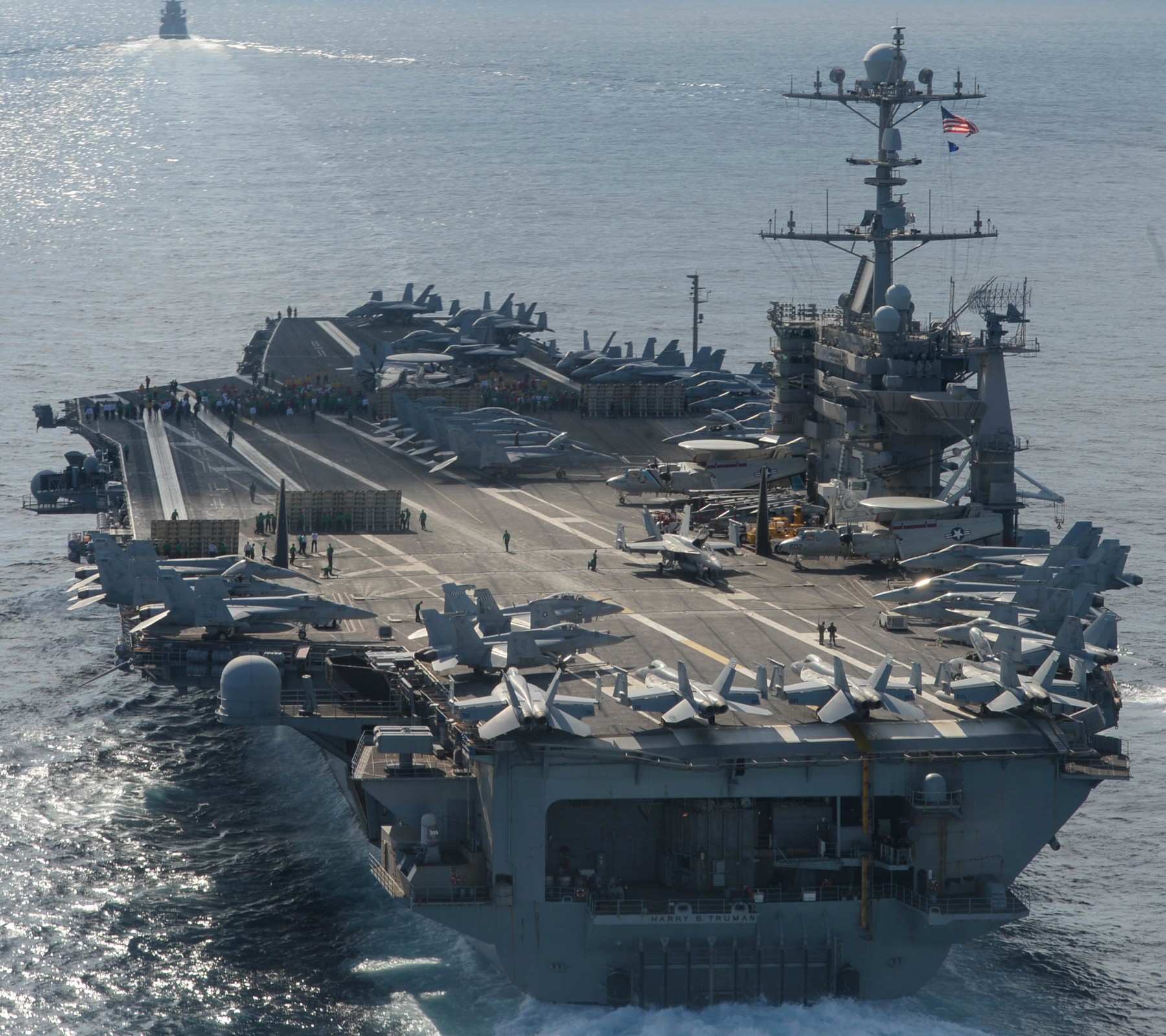 with CVW-1 embarked - Atlantic Ocean - October 2021  departing Norfolk Naval Shipyard, Virginia after Extended Carrier Incremental Availability (ECIA) - May 2021 > continue - CVN 75 image page 2 < > go to CVN 75 image page 3 < |
||
Harry S. Truman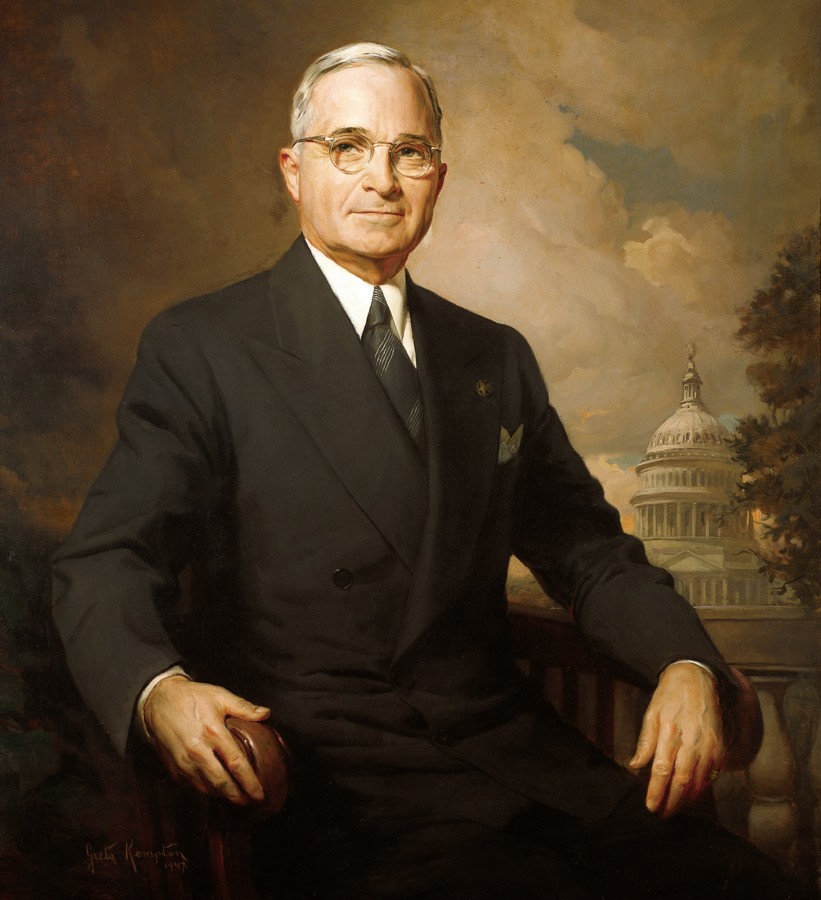 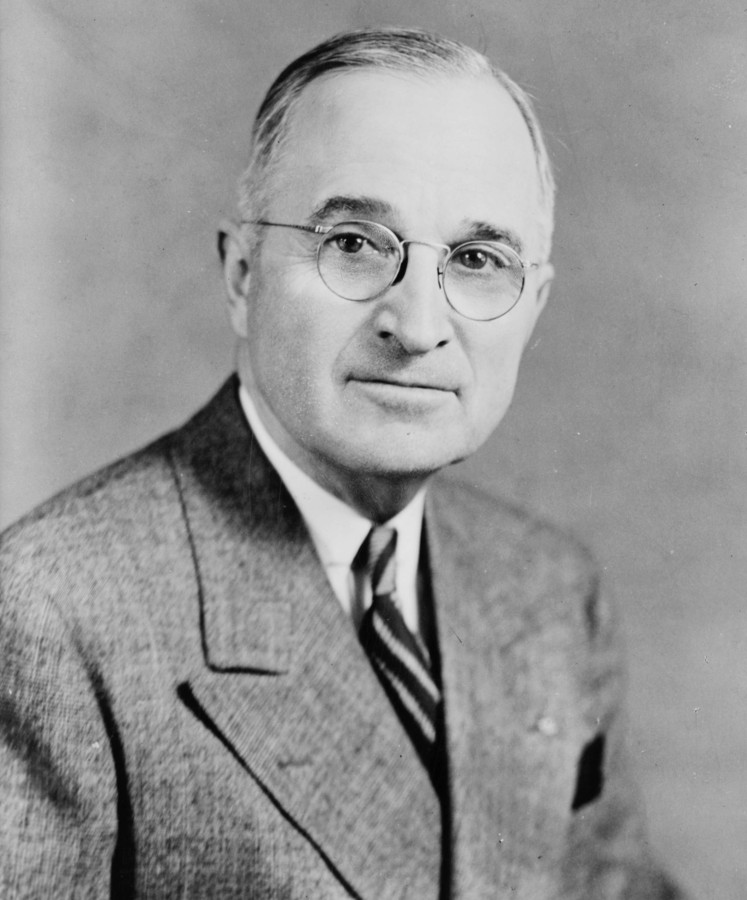
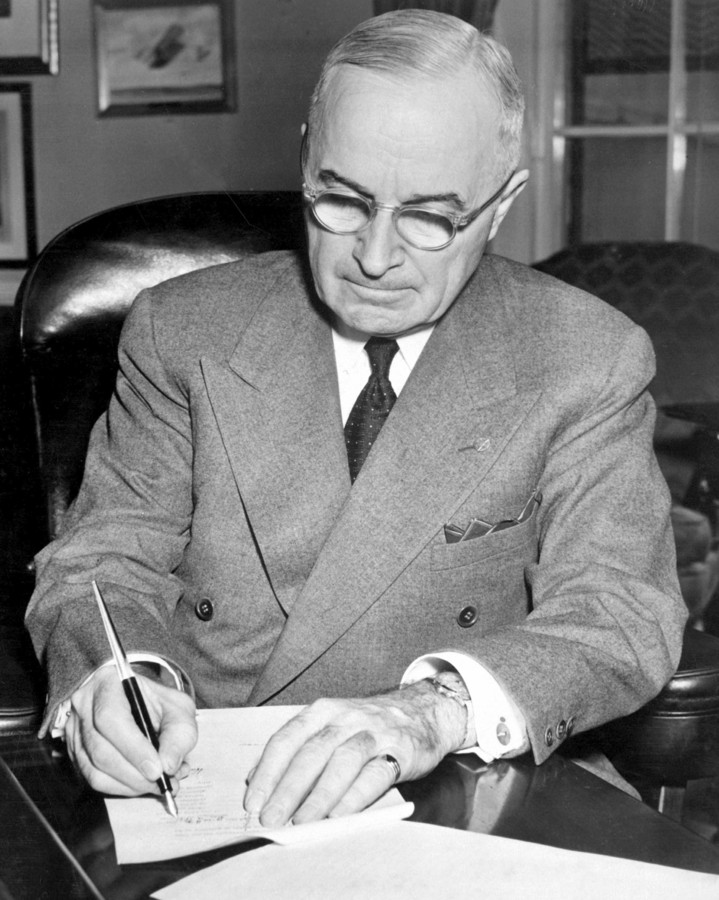 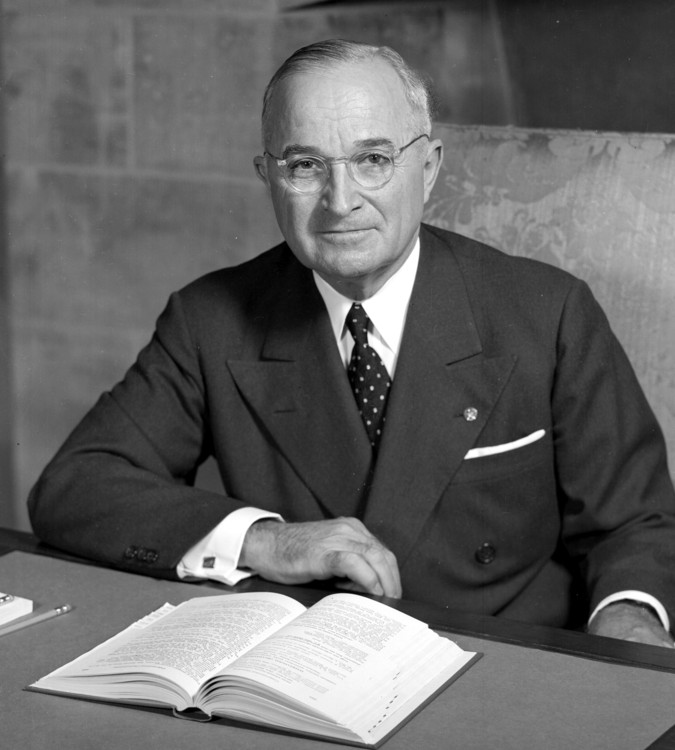 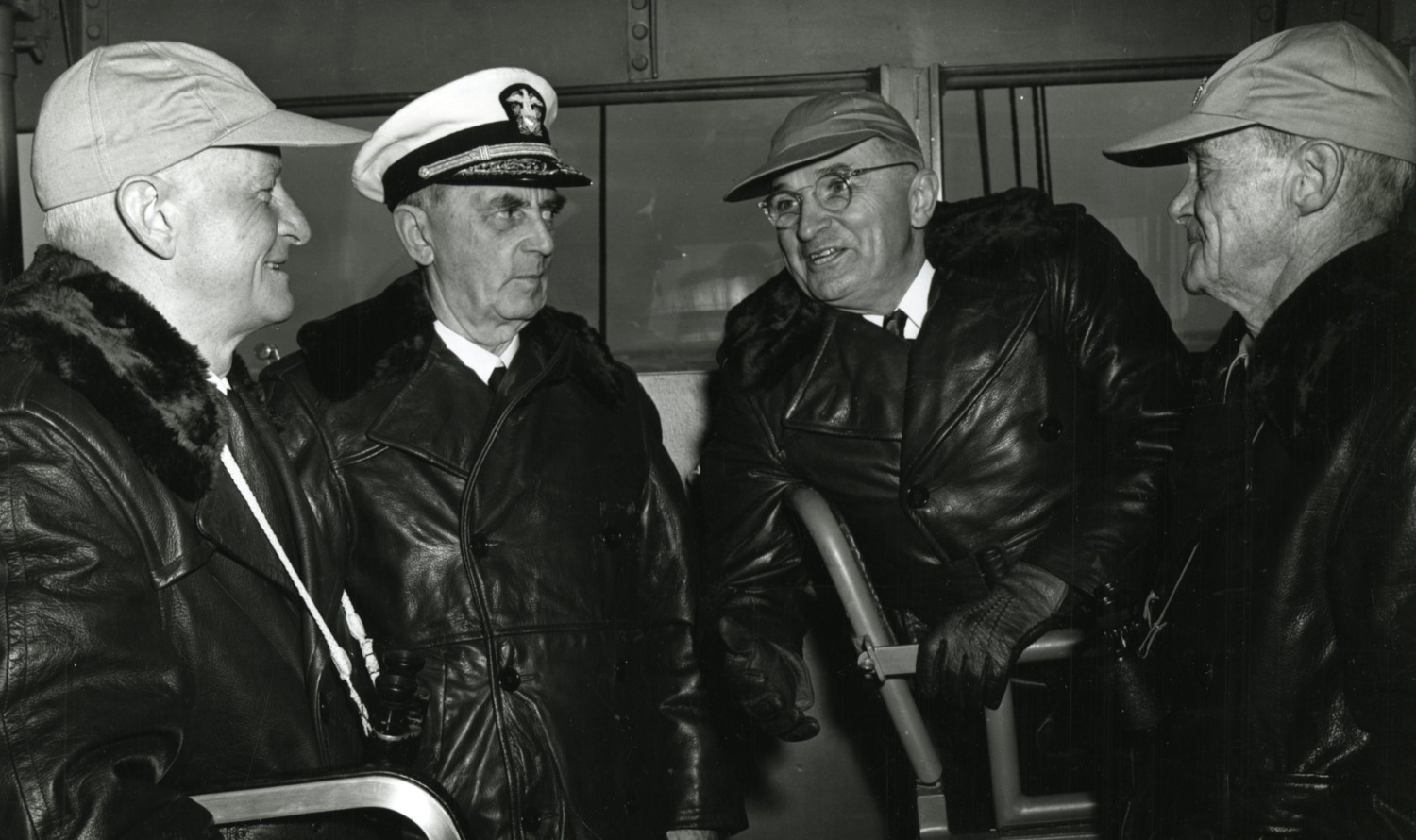 President Truman with Admirals Nimitz, Leahy and Mitscher |
||
|
Harry S. Truman (May 8, 1884 - December 26, 1972): Harry S. Truman (May 8, 1884 - December 26, 1972) was an American politician who served as the 33rd President of the United States (1945-53), coming to office on the death of Franklin D. Roosevelt in the last months of World War II. He is known for launching the Marshall Plan to rebuild the economy of Western Europe, for leading the Cold War against Soviet communism through the Truman Doctrine and NATO, and for defending South Korea in the Korean War. In domestic affairs, he was a moderate Democrat whose liberal proposals were a continuation of Franklin Roosevelt's New Deal, but the Conservative-dominated Congress blocked most of them. He holds the record for vetoes at 180, and saw 12 overridden by Congress; Gerald Ford later tied that record. He used presidential authority to mandate equal treatment for blacks in the military and put civil rights on the national political agenda. Truman served as a United States Senator from Missouri (1935-45) and briefly as Vice President (1945) before he succeeded to the presidency on April 12, 1945 upon the death of Franklin D. Roosevelt. He presided over an unexpected surge in economic prosperity as America sought readjustment after long years of depression and war. His political coalition was based on the white South, labor unions, farmers, ethnic groups, and traditional Democrats across the North. Truman was able to rally these groups of supporters during the 1948 presidential election and win election to a presidential term in his own right. Truman was born in Lamar, Missouri, and spent most of his youth on his family's 600-acre farm near Independence. In the last months of World War I, he served in combat in France as an artillery officer with his National Guard unit. After the war, he briefly owned a haberdashery in Kansas City, Missouri, and joined the Democratic Party and the political machine of Tom Pendergast. Truman was first elected to public office as a county official in 1922, and then as a U.S. Senator in 1934. He gained national prominence as chairman of the Truman Committee, formed in March 1941, which exposed waste, fraud, and corruption in Federal Government wartime contracts. Germany surrendered on Truman's birthday, just a few weeks after he assumed the presidency, but the war with Imperial Japan raged on and was expected to last at least another year. Truman approved the use of atomic bombs to end the fighting and to spare the hundreds of thousands of American and Japanese lives that would inevitably be lost in the planned invasion of Japan and Japanese held islands in the Pacific. Although this decision and the numerous issues that arose as a result of it remain the subject of debate to this day, it was one of the principal factors that forced Japan's unconditional surrender. Truman's presidency was a turning point in foreign affairs, as the United States engaged in an internationalist foreign policy and renounced isolationism. Truman helped found the United Nations in 1945, issued the Truman Doctrine in 1947 to contain Communism, and got the $13 billion Marshall Plan enacted to rebuild Western Europe. The Soviet Union, a wartime ally, became a peacetime enemy in the Cold War. Truman oversaw the Berlin Airlift of 1948 and the creation of NATO in 1949. He was unable to stop Communists from taking over China. When communist North Korea invaded South Korea in 1950, he sent U.S. troops and gained UN approval for the Korean War. After initial successes in Korea, however, the UN forces were blocked by Chinese intervention, and the conflict was stalemated throughout the final years of Truman's presidency. On domestic issues, bills endorsed by Truman often faced opposition from a conservative Congress dominated by the Southern legislators, but his administration was able to successfully guide the American economy through the post-war economic challenges. Truman maintained that civil rights were a moral priority, and in 1948 submitted the first comprehensive civil rights legislation and issued Executive Orders to start racial integration in the military and federal agencies. Allegations were raised of corruption in the Truman administration, linked to certain cabinet members and senior White House staff; this became a central campaign issue in the 1952 presidential election, and helped account for Republican Dwight D. Eisenhower's electoral victory. Scholars, starting in 1962, ranked Truman's presidency as "near great"; since then he has ranked from 5th to 9th place from the top. source: wikipedia - - - - - another history: Harry S. Truman joined a light artillery battery in Kansas City in the summer of 1905, and at once got into hot water. He presented himself to a Kansas City photographer's studio where he had his picture taken in civilian clothes, and then the photographer took him in his new uniform, a beautiful blue affair with red stripes along the trouser legs and red piping on the cuffs, brass buttons down the tunic, a red fourragere hanging from the right shoulder, and a big ornate hat. He stood for one of the pictures in uniform, sat for another, with and without hat. He was a thin bony youth, four years out of high school, just turned 21. All this was preliminary to taking the train down to Grandview, Mo., a few miles south of the metropolis, walking a mile into the country from the station and presenting himself to Uncle Harrison Young, for whom he had been named, and to the family matriarch, Grandmother Harriet Louisa Young, nearly ninety years old. The grandmother remembered the Civil War, when she had been a strong sympathizer with the Confederate States of America. She took one look at her grandson, clad in uniform. "Harry," she said, "this is the first time since 1863 that a blue uniform has been in this house. Don't bring it here again." Harry did what he was told but, then, he later admitted that he thoroughly enjoyed his two three-year enlistments in the national guard, including a summer camp when everything was covered with a foot of water and he and his friends dug holes and enticed sergeants and lieutenants into them. Being an artilleryman, he told the inevitable story about a fellow guardsman who got his finger in the breech of a three-inch gun, lost it and ran for the camp hospital, and another friend picked up the finger and was taking it across the field when he stumbled and lost it. In 1917 although a farmer and over age - he was born in 1884 - he reenlisted and thought the men of the artillery regiment would make him a sergeant and instead they elected him first lieutenant. In France the next summer as a captain, he took over the unruly Battery D, which had been hard on its officers. The day after he took command his men knew they had (as one of them remembered) "a different cat to do business with." They liked him, then adored him, and he took them through heavy action and brought all 198 men and officers out alive. On the way back, in 1919, on the new 14,000-ton German steamer Zeppelin, loaded without ballast, which wallowed from one side to the other, the men whiled away their time playing poker, taking a percentage of each game to buy a 16-inch-high loving cup inscribed to "Captain Harry S. Truman. Presented by the members of Battery D in appreciation of his justice, ability and leadership." After three years (1919-22) as a haberdasher, Harry Truman went into politics, spending 10 years as an administrator of Jackson County, Mo., the big county containing both Independence and Kansas City, then 10 more as U.S. Senator. In January, 1945, he became Vice President under the ill Franklin D. Roosevelt and on Apr. 12 became President of the United States. He felt, he said, like the moon, ?he stars, and all the planets had fallen on him. In the work of the presidency from 1945 to 1953, Harry Truman made many judgments and made them in a manner that every citizen of the United States might well employ for serious decisions of any sort. To his detractors and even to some of his friends he had the reputation of making snap judgments and they were anything but that. When a problem arose apparently requiring a decision, after finding out whether it needed one he made what he called a "jump decision". This was a tentative, perhaps even instinctive, judgment. Then he thought it over, mulled it, plumbed its depths and widths, during his morning walks, in the interstices of the scheduled callers at his office, after afternoon naps (he worked each night, or attended formal functions, and a nap was a necessity), early in the mornings when arriving at his office at 6:00 a.m. or shortly after. Then, when he could wait no longer, he came to his decision. Afterward he did not look back, for what good would that do? Gen. George C. Marshall found the new president a delight to deal with, quick and orderly, as opposed to another president with whom Marshall, himself a man of quick and orderly judgment, had many dealings. In addition to these attractive ways of decision making Truman possessed another quality essential to judgment. This was something Marshall also possessed, that is, a remarkable selflessness. When people came to see him during his presidency he never believed for a moment that they came to see him, Harry Truman, but that they were paying their respects to the high office he held. The writer John Hersey observed him carefully for several days late in 1950, in preparation for a profile in the New Yorker and noticed that there were two people, Harry Truman the man and Harry Truman the president, and no confusion existed between the two roles. Years later I met the former president, who came up to me, put out his hand and said, simply, "Truman." For domestic affairs during the Truman administration the president sought a continuation of the New Deal and titled his own program the Fair Deal. Almost all of his proposals would be adopted, albeit years later. After World War II the principal concerns of his fellow citizens were demobilization of the country's huge military forces and reconversion of industry from wartime to peacetime production. The only proposal of domestic legislation by Harry Truman that did not get attention during the next two generations was his attempt to make medical care available for everyone. He was alarmed by the rising cost of care. What was the country coming to, he wrote a correspondent, when a working man could pay as much as $25 a day for a hospital bed? In foreign affairs his achievement was a series of great measures against the new postwar colossus, the Soviet Union: the Truman Doctrine (1947), Marshall Plan (1947), Berlin airlift (1948-49), North Atlantic Treaty (1949). The Cold War turned hot with the Korean War (1950-53). After the initial public enthusiasm for U.S. intervention in Korea, Truman was vilified for it. Harry Truman will go down in history as the first - and one must hope, only - President to approve the use of nuclear weapons. It was not so much a decision as a confirmation of a long series of smaller decisions that had taken the war in the Pacific against Imperial Japan to such a point that the Japanese government lay in the hands of its military commanders who were determined to fight to the finish. And with the decision to end the war by whatever weapons his own country had at hand, Truman soon faced other decisions involving the new nuclear weapons, decisions that transformed much of the basis of war, should it come once again. He was not merely the first president to order use of nuclear weapons but to confront the dual strategy the world's major nations have followed since, preparation for b?th nuclear and non-nuclear war. During his presidency the Soviet threat was very real. To his distress he beheld the slow production of nuclear bombs that began an era of "nuclear plenty" about the time of the Korean War. The U.S. Air Force became fully able to deliver nuclear weapons only about the same time. The threat from spies was large, for the Soviets obtained the design for the Nagasaki bomb shortly after it was used and employed it in their first nuclear device in 1949. But as intricate as was what Winston Churchill described as the "balance of terror," even more so was the balance of conventional forces, keeping a balance between U.S. Army, U.S. Navy, and (with independence from the Army in 1947) U.S. Air Force. One of President Truman's closest military advisors was his naval aide beginning in 1947, Rear Adm. Robert L. Dennison, who had come to the president's attention that year as captain of USS MISSOURI (BB 63) during a voyage back from Rio de Janeiro where Truman and his advisors opened an inter-American conference. Dennison stayed on until the end of the administration and may well have been one of the most effective aides the Navy ever assigned a president of the United States. Modest and unassuming like the president he served, "Bob" Dennison worked at every task to the best of his ability, which said a great deal for quality and accomplishment. At the outset he sensed a wariness in his "boss," for Truman behind his good-natured Missouri personality was a formal, formidable person who did not give his trust easily. Dennison waited out his apprenticeship and the trust came. Dennison finished his illustrious career as commander-in-chief of the Atlantic Fleet. source: USS Harry S. Truman website |
||
|
Harry S. Truman was authorized as CVN-75
on 30 June 1988; named United States on 9 May 1989; subsequently
renamed Harry S. Truman; laid down on 29 November 1993, at Newport
News Shipbuilding and Dry Dock Co., Newport News, Va.; launched on 7
September 1996; sponsored by Mrs. Barbara Bush, wife of President
George H.W. Bush; and commissioned on 25 July 1998 at Naval Station
Norfolk, Va., Capt. Thomas G. Otterbein in command. Boeing F/A-18E/F Super Hornets completed their second round of sea trials on board Harry S. Truman off the Virginia capes (3-14 March 1999). Capt. Robert O. Wirt Jr., Lieutenant Commanders Timothy H. Baker, Robert L. Floyd, and Michael M. Wallace, Maj. Matt Shihadeh, USMC, and Lieutenants Alan D. Armstrong, Erik O. Etz, and Klas W. Ohman flew F1 and F2 on 3 March. Aircraft flying from Harry S. Truman, Capt. David L. Logsdon in command, and with CVW-3 embarked, during her maiden deployment to the Mediterranean, Red Sea, Gulf of Aden, Indian Ocean, Arabian Sea, and Arabian Gulf (28 November 2000-23 May 2001), struck an Iraqi radar system in southern Iraq with precision-guided munitions during Operation Southern Watch, on 1 January 2001. Harry S. Truman carried out a maritime interception operation surge in the Arabian Gulf, to enforce Iraqi compliance with UN sanctions, early the next month. On 5 February, Aircraft 617, a Sikorsky SH-60F Seahawk from Helicopter Antisubmarine Squadron (HS) 7, operating from the ship proved instrumental in a coalition operation that halted the smuggling of 2,300 metric tons of Iraqi oil worth $460,000 by vessels Al Salam and Mustafa. The surge concluded on 11 February. Following Operation Desert Fox (16-20 December 1998), the Iraqis had launched more than 60 surface-to-air missiles and fired antiaircraft guns more than 1,000 times at aircraft. Early in 2001, coalition intelligence analysts revealed that Iraqi dictator Saddam Hussein had begun to install fiber optic cabling into his air defense network. Iraqi gunners learned to briefly radiate their radars to avoid retribution from Hussein’s henchmen, then shut down and run to escape allied AGM-88 High-speed Anti-Radiation Missiles, but then began to radiate radars from around Baghdad, outside the no-fly zones, sending targeting data to their guns through the cables. On 16 February therefore, 25 American and British aircraft attacked Iraqi military targets with the largest strikes since Desert Fox. Harry S. Truman launched F/A-18C Hornets from Strike Fighter Squadrons (VFAs) 37 and 105 and Marine Strike Fighter Squadron (VMFA) 312, and Grumman EA-6B Prowlers from Electronic Warfare Squadron (VAQ) 130, and together with USAF McDonnell Douglas F-15E Strike Eagles and British Panavia GR.1 Tornados, the allied aircraft struck five Iraqi radar, and command, control, and communication nodes outside Baghdad with a variety of ordnance including AGM-154A Joint Standoff Weapons. On 11 April 2003, the Navy designated the Eastern Mediterranean east of 30°E as a zone for eligibility for Imminent Danger Pay or Combat Zone Tax Relief benefits. This move fell short of reaching all the veterans who served in Operation Iraqi Freedom I because it failed to identify those who took part from 19 March. On 18 February 2004, Navy officials thus announced the retroactive eligibility of veterans of Iraqi Freedom for the benefits during that initial 24-day period. The decision principally impacted Task Force 61, including aircraft carriers Harry S. Truman, with CVW-3 embarked, and Theodore Roosevelt (CVN-71), with CVW-8 embarked. Training Squadron (VT) 9’s Lt. Charles B. Bassel, the squadron’s E-2/C-2 Standardization Officer, performed the last arrested landing of a North American T-2C Buckeye, during carrier qualifications on board Harry S. Truman on 17 July 2003. During Summer Pulse 04 the Navy tested changes to operational methods that resulted from the Fleet Response Plan. At times from June 2004, aircraft carriers Enterprise (CVN-65), George Washington (CVN-73), Harry S. Truman, John C. Stennis (CVN-74), John F. Kennedy (CV-67), Kitty Hawk (CV-63), and Ronald Reagan (CVN-76) deployed in five theaters. Their operations extended into September during scheduled deployments, surge operations, and joint and international exercises. Two Grumman E-2C Hawkeyes of Carrier Airborne Early Warning Squadron (VAW) 126 deployed from Harry S. Truman in the Arabian Gulf to Kandahar AB Afghanistan, providing airborne command and control during President Hamid Karzai’s inauguration (4-13 December 2004). On 30 January 2005, aircraft flying from Harry S. Truman provided on-call close air support in 32 sorties during the Iraqi national elections. Aircraft carrier Carl Vinson (CVN-70) relieved Harry S. Truman in the Arabian Gulf on 20 March. A detachment comprising half the SH-60F and HH-60Hs of HS-8 subsequently deployed from Carl Vinson to Camp Arifjan, Kuwait. The Seahawks patrolled southeastern Iraq and flew maritime security operations over the Northern Arabian Gulf, returning to Carl Vinson on 29 June. Hurricane Katrina made landfall along the coast of the Gulf of Mexico on 29 August 2005. A catastrophic storm surge inundated the levees along the Mississippi River and the rising waters flooded 80% of New Orleans, La. Six E-2C Hawkeyes from VAWs 77, 121, and 126 monitored airspace and directed rescue aircraft. On 30 August amphibious assault ship Bataan (LHD-5) arrived, and augmented two embarked MH-60S Seahawks of Helicopter Sea Combat Squadron (HSC) 28 with four Sikorsky MH-53E Sea Stallions from Helicopter Mine Countermeasures Squadron (HM) 15. Meanwhile, amphibious assault ship Iwo Jima (LHD-7) moored at New Orleans and became a hub for helicopter operations as Headquarters, Joint Task Force Katrina. On 1 September, Harry S. Truman arrived with elements of 13 helicopter squadrons embarked. Additional naval aviation reinforcements included MH-60s of Helicopter Antisubmarine Squadrons (Light) (HSLs) 43, 47, and 49, and Helicopter Combat Support Squadron (HC) 11, two Boeing Vertol CH-46E Sea Knights and six CH-53E Super Stallions from six Marine squadrons from Marine Corps Air Station (MCAS) New River, N.C., four Super Stallions from Marine Heavy Helicopter Squadron (HMH) 772, and Fleet Logistics Support Squadrons (VRs) 57 and 58. Seventy-six Coast Guard and Coast Guard Auxiliary aircraft rescued 12,535 people during 1,817 sorties. Altogether, more than 5,000 Coast Guardsmen saved 33,545 lives. Over 70 fixed wing aircraft and more than 350 helos from all the services responded. On 22 February 2008, HS-7, embarked on board Harry S. Truman, and auxiliary dry cargo ship Sacagawea (T-AKE-2) rescued ten Iraqis from Korean-flagged tanker Nadi when she sank in the Arabian Gulf. The following day HS-7 transferred the rescued mariners to British dock landing ship Cardigan Bay (L.3009) for their return to the Iraqi Navy. EA-18Gs from VAQs 129 and 132 completed the first Growler traps on board Harry S. Truman on 5 August 2009. Heavy rains (late July-early August 2010) caused flooding in Pakistan that killed an estimated 1,600 people and rendered hundreds of thousands homeless. On 9 August amphibious assault ship Peleliu (LHA-5), dock landing ship Pearl Harbor (LSD-52), and amphibious transport dock Dubuque (LPD-8) arrived off Karachi, Pakistan, to render assistance. At times 15 CH-46E Sea Knights of Marine Medium Helicopter Squadron (HMM) 165 and CH-53E Super Stallions of HMH-465 from the 15th Marine Expeditionary Unit (MEU), augmented by MH-60S Seahawks of HSC-23 and three MH-53E Sea Dragons of HM-15 Detachment 2, contributed to the evacuation of 10,051 people and delivery of 1,895,038-pounds of humanitarian relief supplies to victims. Some of these helos operated from Pakistani airfields at Chaklala, Ghazi, and Pano Aqil. In addition, two Aérospatiale SA-330J Pumas flew from auxiliary dry cargo ship Lewis and Clark (T-AKE-1). Meanwhile, McDonnell Douglas AV-8B Harrier IIs of Marine Attack Squadron (VMA) 311 carried out close air support missions from Peleliu for coalition troops fighting Islamic extremists in Afghanistan. On 16 September amphibious assault ship Kearsarge (LHD-3), dock landing ship Carter Hall (LSD-50), and amphibious transport dock Ponce (LPD-15), with Bell Boeing MV-22B Ospreys of Marine Medium Tiltrotor Squadron (VMM) 266 and helos from the 26th MEU embarked, arrived to participate. Air Force cargo aircraft and ten Army Boeing CH-47 Chinooks and eight Sikorsky UH-60 Black Hawks also flew humanitarian assistance missions. Peleliu came about on 31 October. Harry S. Truman subsequently arrived, and on 15 November four Super Stallions of the 26th MEU’s VMM-266 refueled on board. 2010 Truman began a seven-month deployment to the 5th and 6th Fleet areas of operations in support of maritime security operations on 21 May 2010. Truman led a task force of 11 American warships and 5,000 men into the Suez Canal on 20 June 2010. An F/A-18C Hornet of VFA-37, embarked on board Harry S. Truman in the Northern Arabian Sea, spotted a vessel on fire about 50 miles from the carrier on 18 August 2010. Two SH-60F Seahawks of HS-7 rescued all eight Iranian seafarers from their stricken vessel. The ship visited four ports during its 213 days at sea, including Marseille, France; Dubai, U.A.E; Manama, Bahrain; and Souda Bay, Crete, before returning to the United States on 20 December 2010. 2011 On 2 February 2011, Commander, Naval Air Force U.S. Atlantic Fleet named Truman as the Battle Effectiveness Award, or Battle "E", award winner, which was third consecutive Battle "E" award. This was the sixth award in the ship's twelve-year history, having previously won the Battle "E" award in 2003, 2004, 2005, 2008, and 2009. Harry S Truman entered a Docked Planned Increment Availability at Norfolk Naval Shipyard in late March 2011. On 28 February 2011, the aircraft carrier began its dry-docking planned incremental availability (DPIA) maintenance and yard overhaul period at Norfolk Naval Shipyard in Portsmouth, Virginia (pictured). During this maintenance cycle, Truman received a new main mast, an upgrade in its close-in weapons systems, and the installation of the Automated Digital Network System (ADNS) which provides the carrier with enhanced communications and cooperative engagement capabilities to assess possible threats. Truman is expected to complete this DPIA yard overhaul in early 2012 and begin preparations for its sixth overseas deployment. Also, Truman's berthing spaces were also upgraded, installing 2,500 racks, replacing 46,000 square feet of deck and painting 106,000 square feet of spaces. On 8 November 2011, Captain Tushar Tembe died after collapsing on the pier near the ship. Executive Officer Captain Craig Clapperton assumed command after Captain Tushar Tembe's death. Soon after Tembe's death Captain Dee Mewbourne assumed command and Captain Craig Clapperton resumed his position as Executive Officer. 2012 On 7 April 2012, Norfolk Naval Shipyard completed the ship's nuclear power plant modernization and testing was to begin to ensure its readiness for sea trials lasting 90 days. Harry S. Truman returned to the U.S. Navy fleet in the summer of 2012. On 26 November 2012, an X-47B Unmanned Combat Air System (UCAS) was hoisted on board the Truman in preparation for an unmanned aircraft's first, carrier-based testing. Truman was to be the first aircraft carrier in Naval aviation history to host test operations for an unmanned aircraft. Testing on the X-47B was conducted over a three-week period that included in-port and underway demonstrations aboard. The X-47B successfully completed carrier deck tests aboard the Harry S Truman on 18 December 2012. 2013 On 6 February 2013, the U.S. Department of Defense announced that the upcoming deployment of Harry S. Truman, the Ticonderoga-class guided-missile cruiser Gettysburg, and the rest of Carrier Strike Group Ten will be postponed pending the resolution of the upcoming budget sequestration, leaving the carrier John C. Stennis and its carrier strike group as the only carrier force operating in the Persian Gulf region. The strike group was originally scheduled to depart Naval Station Norfolk, Virginia, on 8 February 2013. On 22 July 2013, Harry S. Truman left for an extended deployment to the 5th Fleet area of responsibility, and settled into their mission of supporting Operation Enduring Freedom and the coalition of troops on the ground in Afghanistan. 2014 On 14 February 2014, the Commander, Naval Air Force U.S. Atlantic Fleet named Harry S. Truman as the East Coast aircraft carrier Battle Effectiveness Award winner. On 23 March 2014 Harry S. Truman officially turned over the watch to George H.W. Bush in the U.S. 5th Fleet area of responsibility conducting maritime security operations and supporting theater security cooperation efforts. 2015 On 16 November 2015, Harry S. Truman, with assigned Carrier Air Wing Seven, began a scheduled deployment to the U.S. 6th and 5th Fleet areas of operation. The carrier was accompanied by the cruiser Anzio and Destroyer Squadron (DESRON) 28, Bulkeley, Gonzalez, Ramage and Gravely. On 21 December 2015, Djibouti President Ismail Omar Guelleh visited USS Harry S. Truman stationed near the Yemeni island of Berim. On 26 December while transiting the Straight of Hormuz several unguided rockets fired by Iran landed approximately 1,500 yards (1,400 m) away from Harry S. Truman which was traveling with the destroyer Bulkeley and the French frigate Provence. Iran had announced over maritime radio they were carrying out tests "only 23 minutes before" and were criticized by the U.S. Central Command for "Firing weapons so close to passing coalition ships and commercial traffic within an internationally recognized maritime traffic lane." On 29 December 2015, Harry S. Truman began launching strikes against the Islamic State group. By mid-April 2016, aircraft of Carrier Air Wing Seven operating from the carrier had dropped 1,118 pieces of ordnance in operations against the group, surpassing a record of 1,085 pieces that was set by aircraft assigned to USS Theodore Roosevelt in 2015. 2016 On 12 January 2016, an unarmed Iranian drone flew directly over Harry S. Truman in international waters and took "precise" photos, according to state television in the Islamic Republic. On 3 June 2016, F/A-18 Hornets launched from Harry S. Truman conducted air strikes against ISIS targets from the eastern Mediterranean. It was the first time the U.S. Navy had conducted strike missions in the Middle East from the Mediterranean Sea since flying operations against the Iraqi military in 2003. 2017 On July 21, 2017, TRUMAN completed an on-time, 10-month Planned Incremental Availability (PIA) at Norfolk Naval Shipyard for maintenance and refurbishment of shipboard systems to prepare for future operations. Over the next six months, TRUMAN completed a robust work-up cycle in preparation for deployment. 2018 Carrier Strike Group 8 began a further scheduled deployment to the Middle East and Europe on 11 April 2018. The carrier returned to Norfolk on 21 July and left again for operations in the Western Atlantic Ocean on 28 August. On 25 October, the carrier took part in the NATO exercise Trident Juncture which was held in and around Norway. 2019 On 27 February, the Pentagon announced that Harry S. Truman's mid-life refuelling and overhaul, tentatively scheduled for 2024, may be cancelled and the ship instead retired early as a cost-saving measure. The likelihood of the ship actually being decommissioned more than 20 years ahead of schedule was uncertain, as this would have left the carrier fleet at ten ships, one below the legally mandated level. The nominated Chief of Naval Operations told Congress he supports "to forgo" the $ 3.5 billion overhaul scheduled for the Truman. Congress prevented the Navy from taking the same action with sister ship George Washington in 2016, as well as the White House, as President Donald Trump had promised to increase the carrier fleet to 12. On 1 May, President Trump announced he overrode the decision to decommission USS Harry S. Truman. In late August it was announced that a malfunction of the ship's electrical distribution system would prevent her scheduled deployment. In late October the ship's electrical malfunction was repaired and Harry S. Truman departed Norfolk to be deployed in the Persian Gulf. She was reported as entering the 6th Fleet Region on 2 December 2019. 2020 In July 2020, USS Harry S. Truman was at Norfolk Naval Shipyard, in Portsmouth, Virginia. 2021 Harry S. Truman along with CVW-1 and her battlegroup deployed out to sea on 1 December 2021. It was originally planned for Harry S. Truman to transit the Suez Canal into the Middle East. However, in light of the standoff between Russia and Ukraine in late 2021 escalating, the carrier was ordered to stay in the Mediterranean. 2022 In January 2022, Harry S. Truman and her strike group came under command of NATO's Naval Striking and Support Forces for the first time since the Cold War, for a ten-day exercise patrolling the Mediterranean. From 17 May to 23 May, Harry S. Truman and Carrier Strike Group 8 took part in the NATO vigilance activity, Neptune Shield 2022. On 8 July 2022, an F/A-18E Super Hornet of Carrier Air Wing One was blown overboard into the Mediterranean Sea. The carrier had encountered unexpected heavy weather while conducting a replenishment-at-sea. One sailor received minor injuries. On 8 August 2022, the United States Sixth Fleet announced the lost aircraft had been recovered from a depth of 9,500 feet (2,900 m) using a remotely operated CURV-21 recovery vehicle. On 8 August 2022, The Aviationist reported that based on a photo sent to the outlet, taken at the Port of Augusta, Sicily, they were able to identify the involved aircraft as the aircraft with modex 205, part of Strike Fighter Squadron 211 (VFA-211). The aircraft was loaded aboard Military Sealift Command roll-on/roll-off ship USNS Mendonca at the Port of Augusta on 16 August 2022 to be transported back to the United States. Harry S. Truman returned to Norfolk on 12 September 2022. 2024 Harry S. Truman deployed on 23 September 2024 to the 6th fleet. After completing NATO exercises in the North Sea, she entered the Oslofjord for a visit on 1 November. On 14 December, she transited the Suez Canal and entered the Middle East. She launched her first combat sorties in support of Operation Prosperity Guardian against the Houthi rebels in Yemen on 21 December. On 22 December 2024, an F/A-18F Super Hornet from VFA-11 was shot down by USS Gettysburg in a friendly fire incident. Both crewmembers of the aircraft survived. 2025 Harry S. Truman was involved in a collision with the Panamanian-flagged merchant vessel Besiktas-M at approximately 11:46 p.m. local time on 12 February, while operating in the vicinity of Port Said, Egypt, in the Mediterranean Sea. The collision did not endanger the aircraft carrier with no reports of flooding or injuries. An investigation into the collision was launched. One week later Harry S. Truman's commanding officer, Captain Dave Snowden, was relieved of command. In March 2025, the United States launched more than 47 airstrikes on multiple provinces across Yemen. In response, the Yemeni army targeted Harry S. Truman in two phases using ballistic missiles, cruise missiles, and drones. These two attacks were followed by a third attack the next day. sources: US Naval History & Heritage Command / wikipedia / US Navy |
||
| patches + more | ||
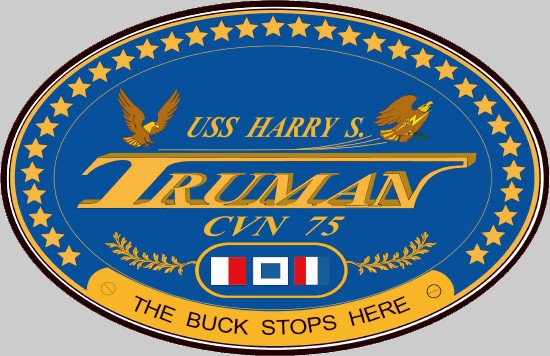 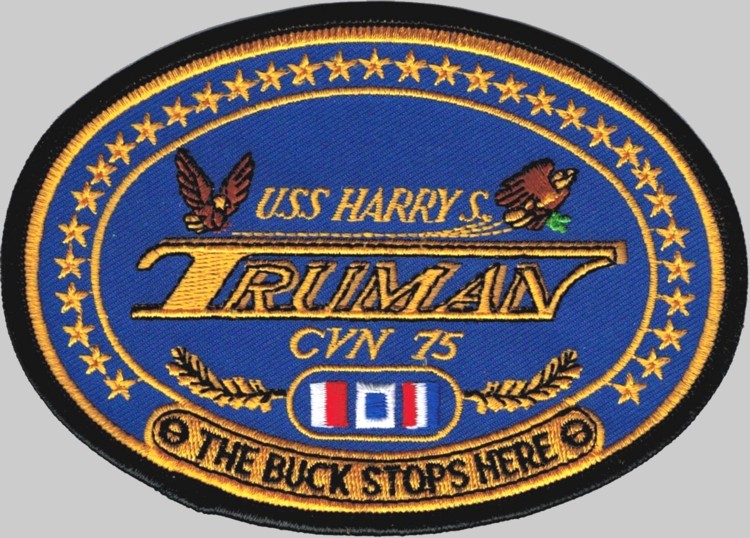 |
||
| | seaforces.org | USN ships start page | |